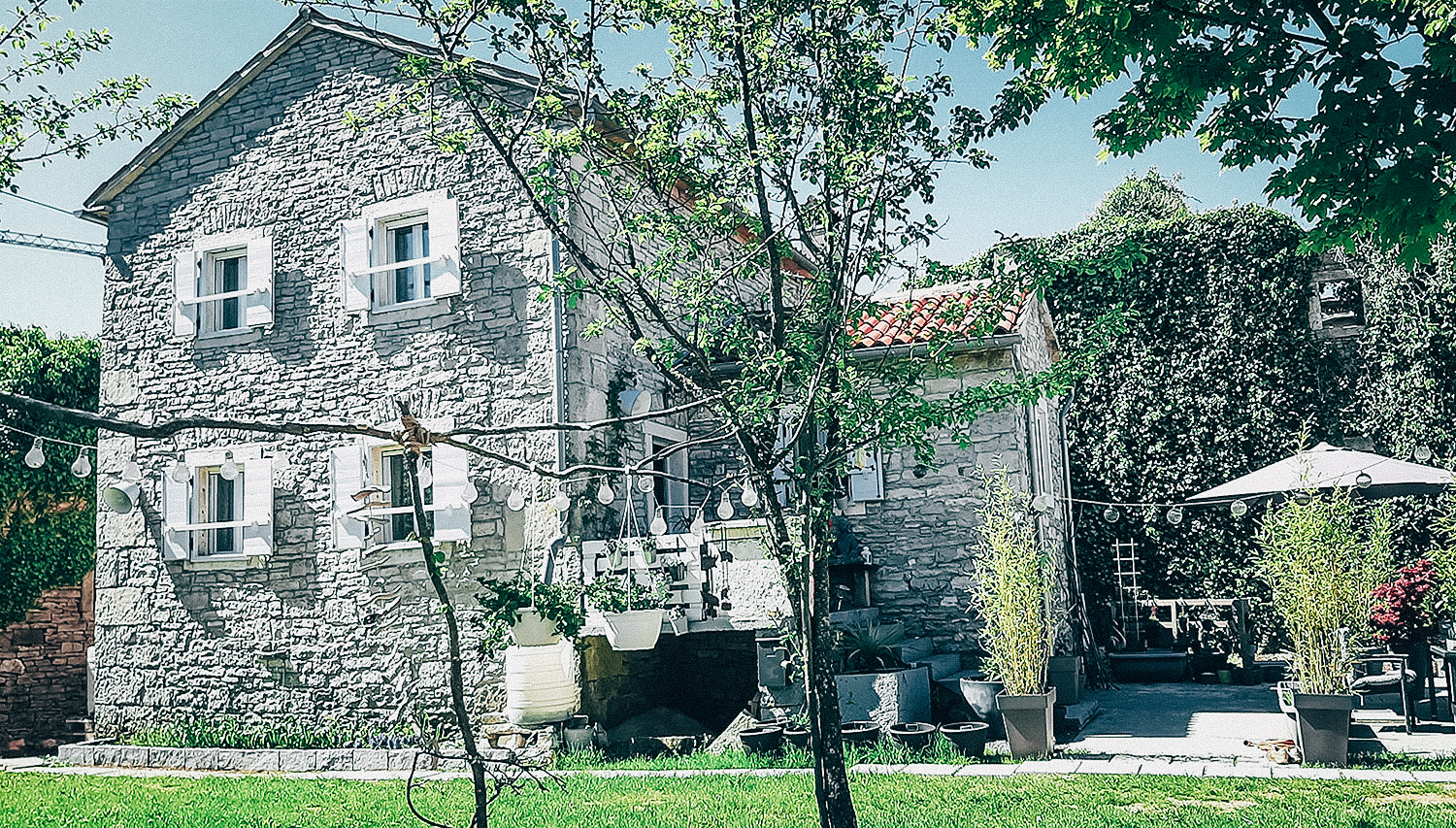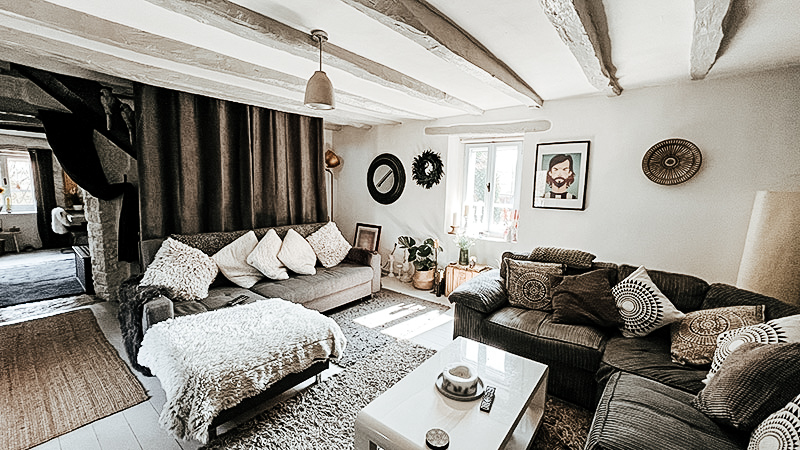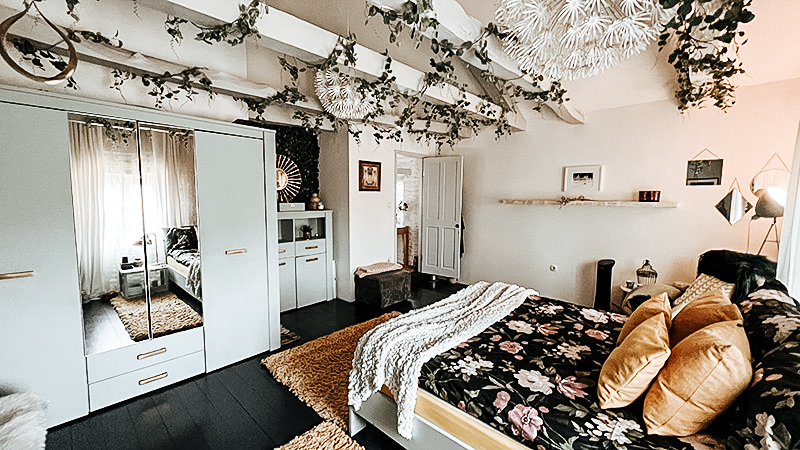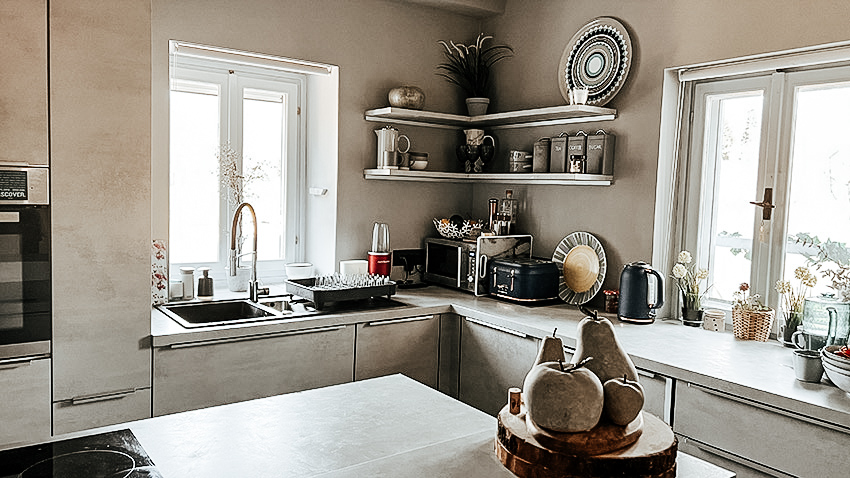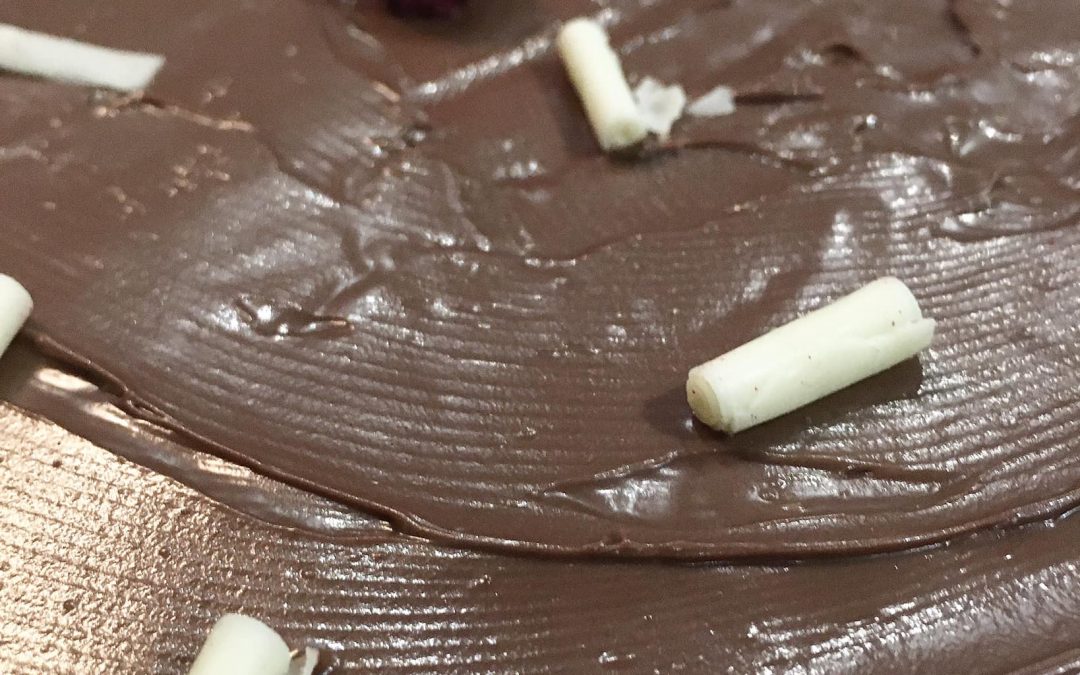
by Helen | Jan 25, 2024 | Lifestyle
I have never been much of a baker, but I do love the idea of baking. Unfortunately, I’m very impatient and I like quick and easy – preferably immediate – results, so the thought of standing in the kitchen, baking up a complicated recipe doesn’t really do it for me. I wish it did, as I think I’d take great pleasure in successful results, but that’s where we’re at. Then I stumbled across this recipe…
three ingredient chocolate cake
And, yes – it does actually require only three ingredients, so I figured I could give this one a go. I’m sure more creative bakers would enhance the recipe, but I decided to stick with the original, apart from a slight flourish with the topping…
what you’ll need
- 350g choc chip cookies – I used two packets of quite deluxe cookies, with plenty of chocolate chips
- 360ml milk
- 10g baking powder
what you’ll need to do
Simply crush the cookies, using a bag and a rolling pan, leaving some larger chunks for texture. Tip into a mixing bowl, add the milk and baking powder and blend, either by hand or using a whisk. Pour into a parchment lined baking tin and bake for 25 minutes in an oven, preheated to 180°C. Use a wooden skewer to check that it is cooked and then allow to cool. Remove from the tin, place on a wire tray and unless you want a naked chocolate cake, you can begin decorating. Extra ingredients are obviously needed at this point, but these are up to you, as I’m sure you’ll be a whole lot imaginative than I was.
All I did was melt a large bar of Milka chocolate and smothered this over the cake, leaving it quite rough – this almost any errors were easily disguised. As an extra sparkle, I added tiny white chocolate curls and dried raspberries – all taken from a box of museli…
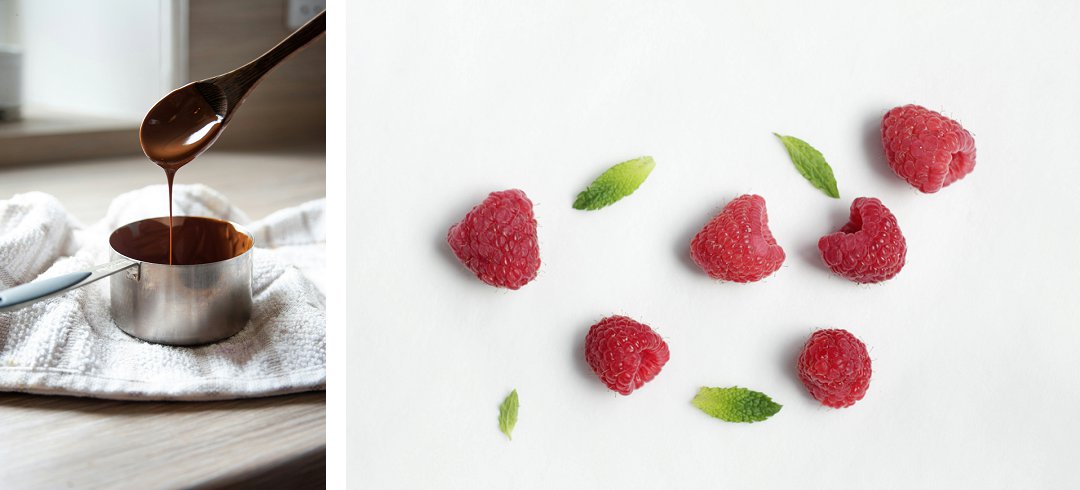
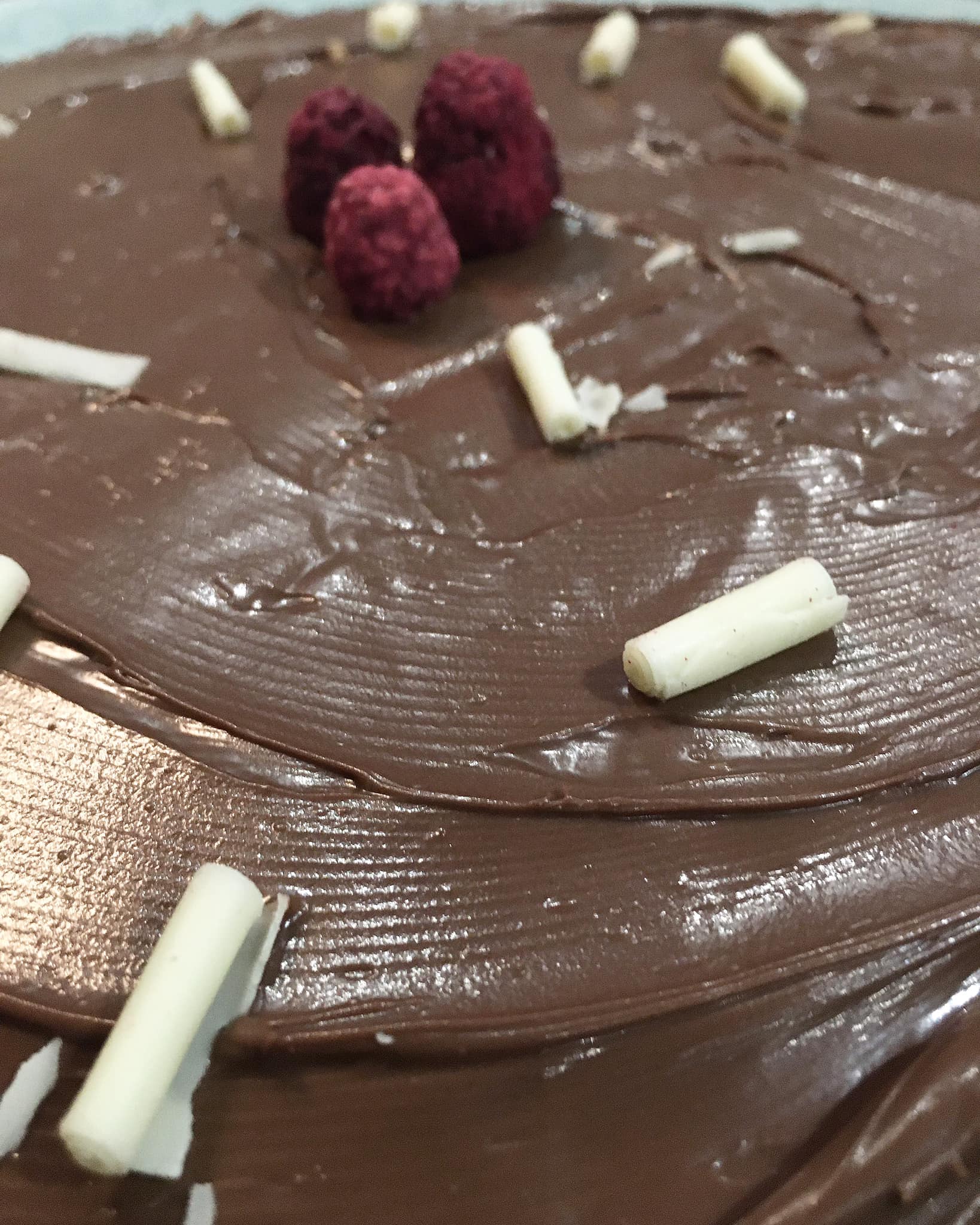
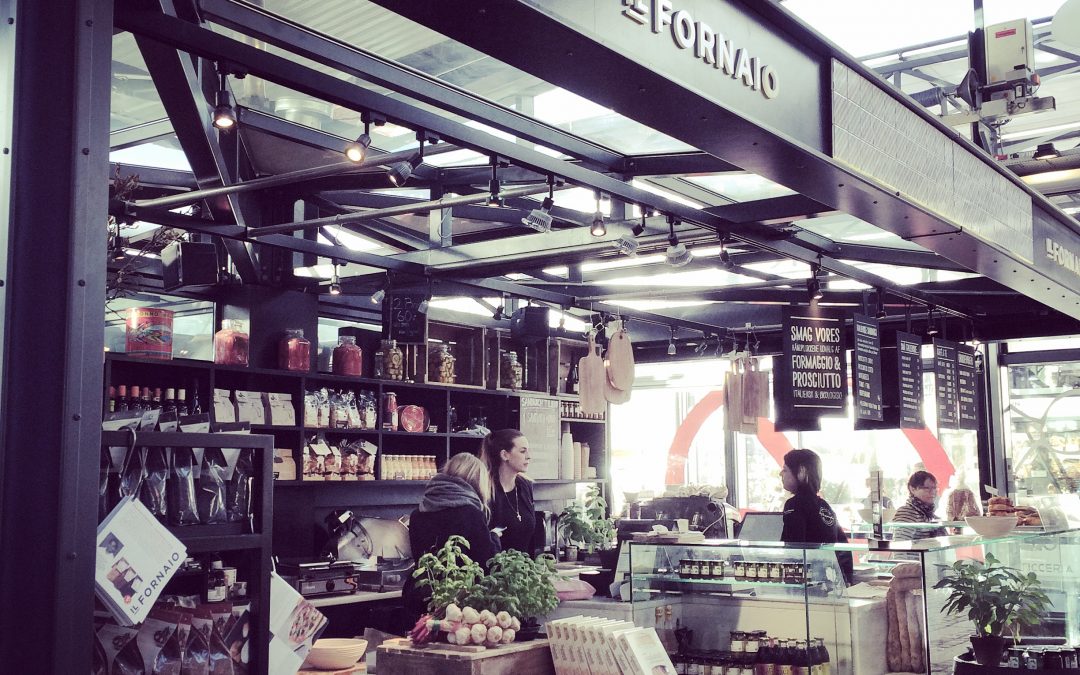
by Helen | Jan 24, 2024 | Lifestyle
Copenhagen, for us, is just about the perfect city. As much as we love Italy beyond reason, the cool Danish capital, is the perfect place for a short break. It’s a city that can be easily broken down into areas, so makes exploring it really easy. On our last trip, we stayed in the Vesterbro neighbourhood, and from here, we did get to see a lot of the city. Transport around Copenhagen is excellent – obviously if you’re a local, bikes are king, but they can easily be hired if you’re just visiting. Public transport is reliable, and the Metro, s-trains and buses (including waterbuses) can all be accessed with the same ticket. But, mostly we used our feet and covered a great deal of ground.
As well as being super stylish and effortlessly cool, Copenhagen is a foodie paradise. And, with really affordable options – one being the amazing Torvehallerne Food Hall – you will be well fed and watered throughout your visit. Opened in its present form in 2011, and with over sixty stalls, it’s right in the centre of the city, very close to the busy Nørreport Street and the beautiful rectangular lakes (Peblinge, Sankt Jørgens and Sortedams), and is the perfect place to stroll, pick up some tasty treats and have a bite to eat. With local produce, farm-to-table dining, Danish specialities and global cuisine, this food market is more of an experience, and one that really should be on everyone’s “must visit” list. As well as being able to eat inside the hall – most of the food outlets have seating, although they can be at a premium – you can enjoy the outdoor seating where there are benches and tables around the flower and fruit market and in the square behind.
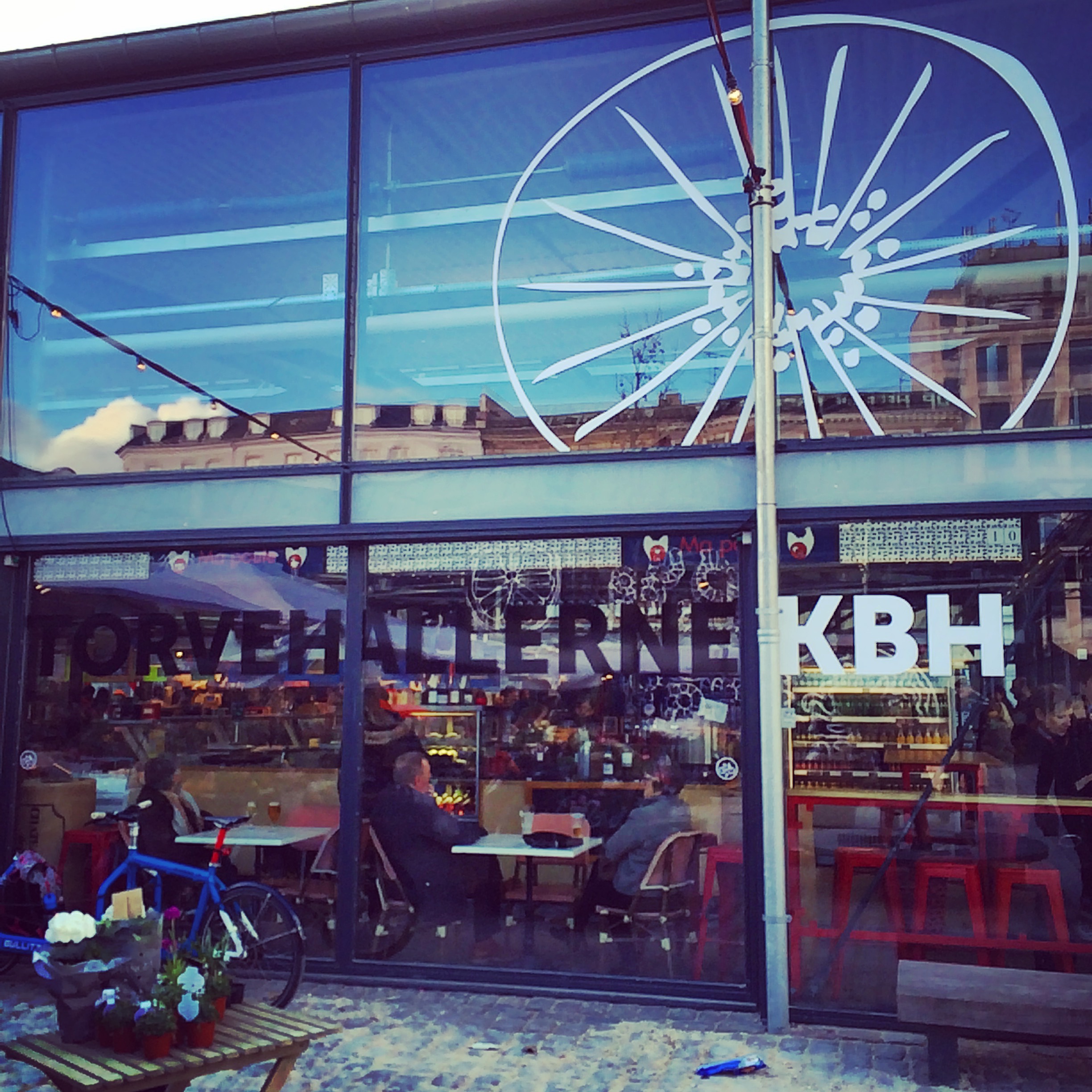
Like everything in Copenhagen, this food hall just screams style. All outlets are independent and all are presented beautifully – from the ways the goods are displayed, to the logos and branding, to the colour palette choices through to the presentation of either the food or the packaging. Attention to detail is in evidence everywhere. This place really delivers and is a fabulous day out. As well as plenty of foodie retail opportunities – fabulous if you are self-catering in Copenhagen – the options for grazing are just wonderful. We chose one of the outlets which prepared and cooked the most divine fresh pasta and sauces, accompanied of course, by delicious Italian white wine.
Whatever you desire, you will be able to source in this incredible food market – coffees to go, fresh coffee beans, pizzas, pasta, fresh spices, meats, cheeses, olives, pastries (Danish, of course, being the most popular), breads, fresh juices, tapas, oysters, open sandwiches, organic products, herbal products. The list is endless!
Outside the glass food hall, are many stalls selling fresh flowers and plants and fruit and vegetables. The floral choices are just staggering and I know if I lived in Copenhagen, I’d have fresh flowers every single day!
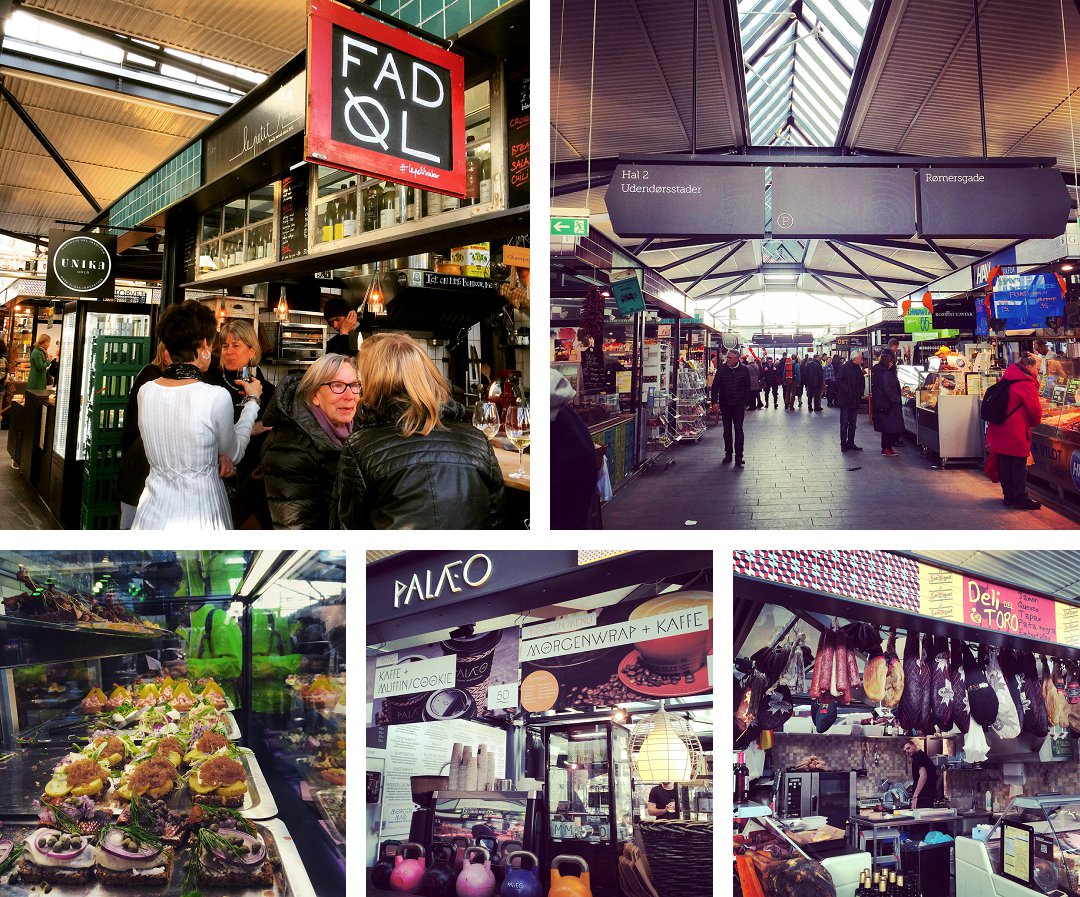
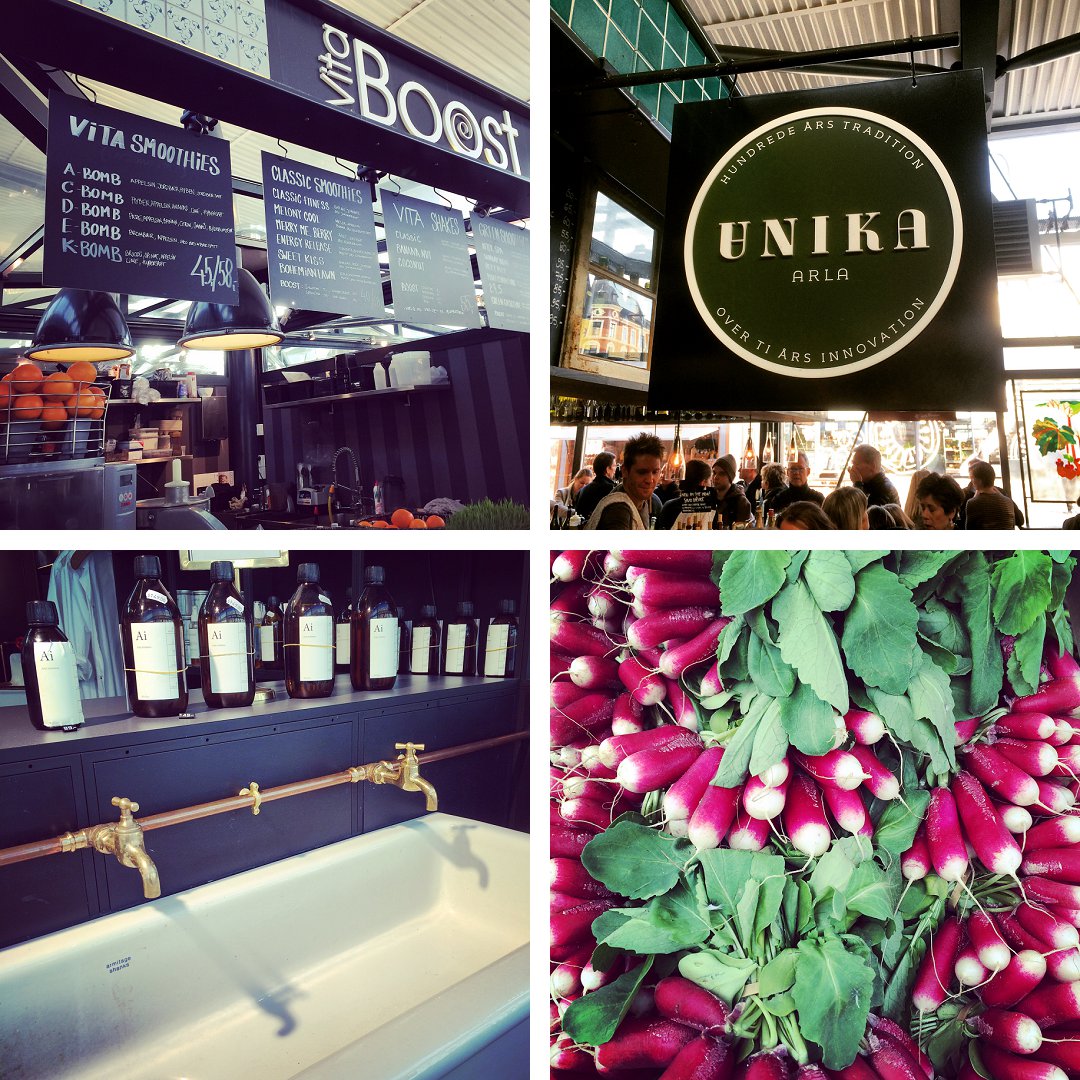
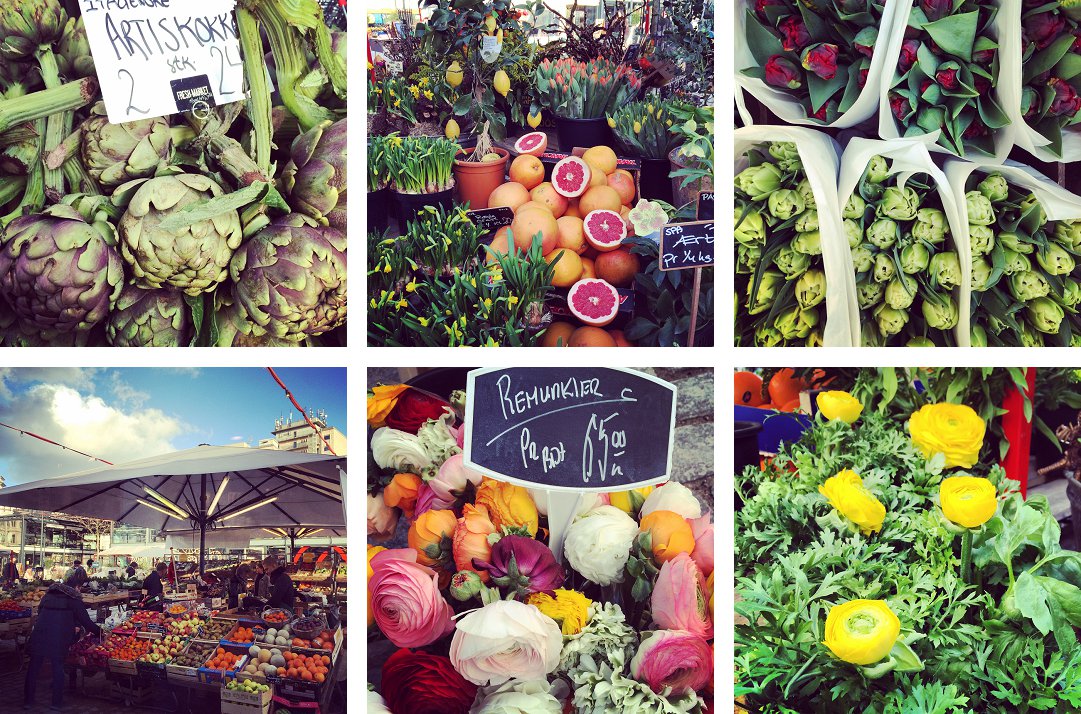
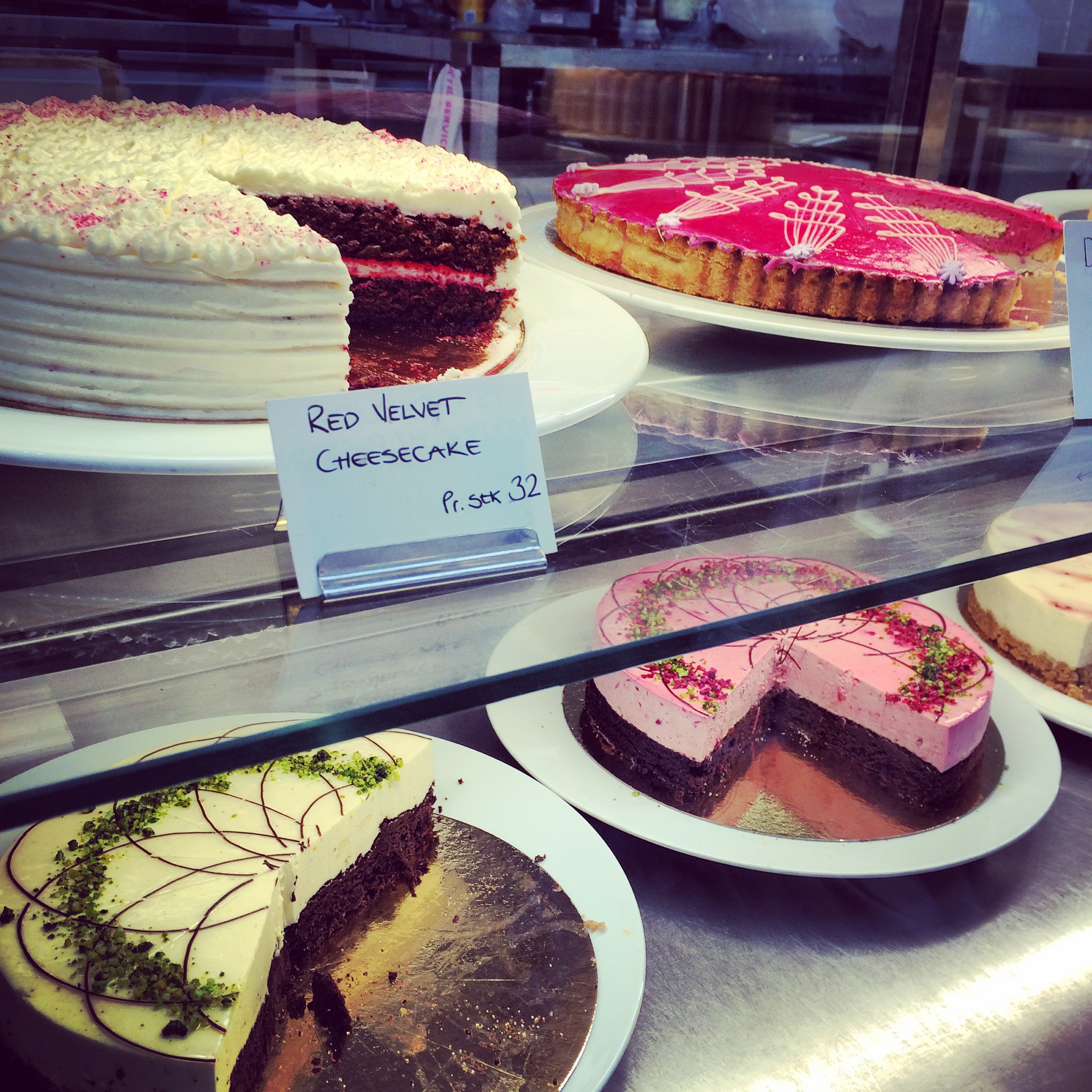
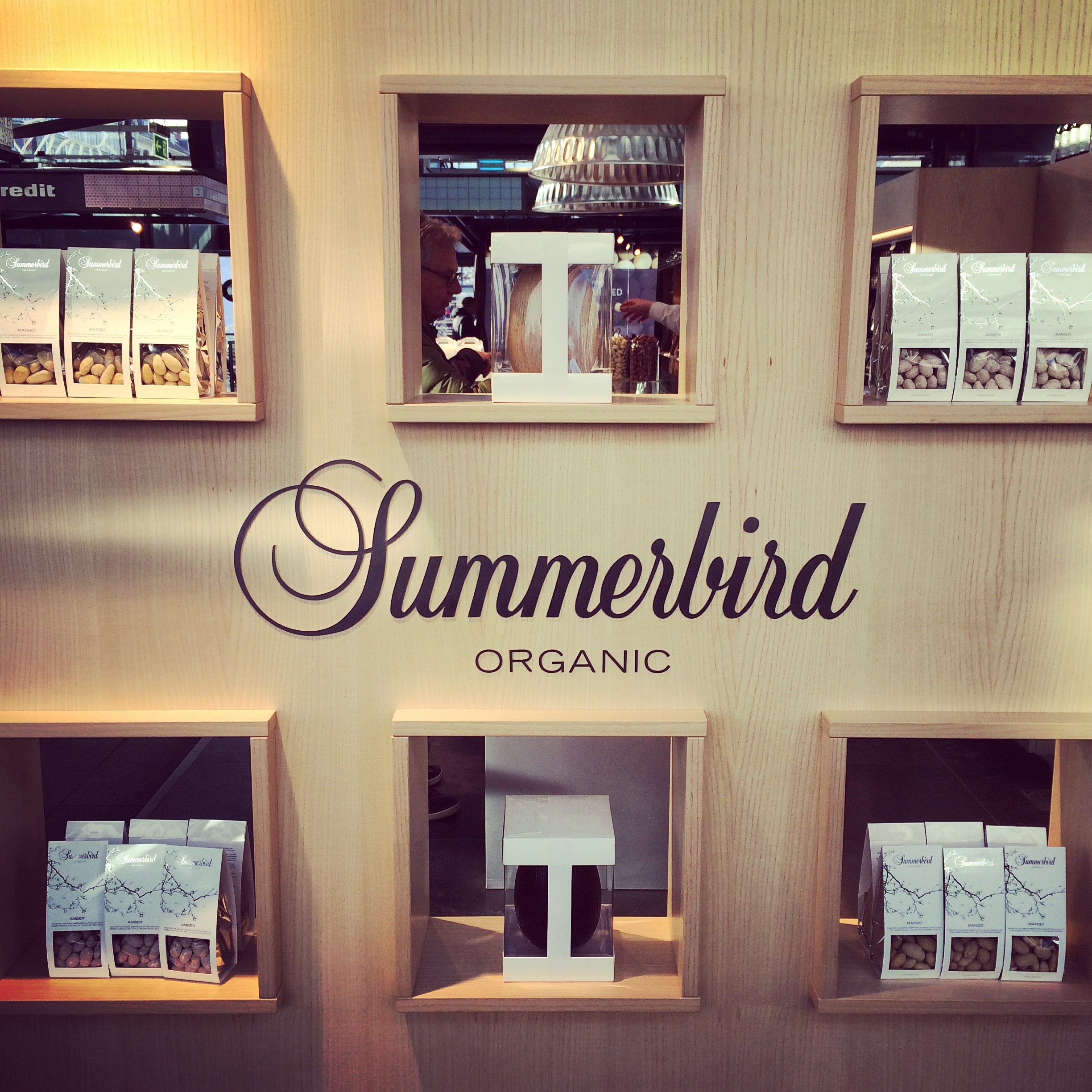
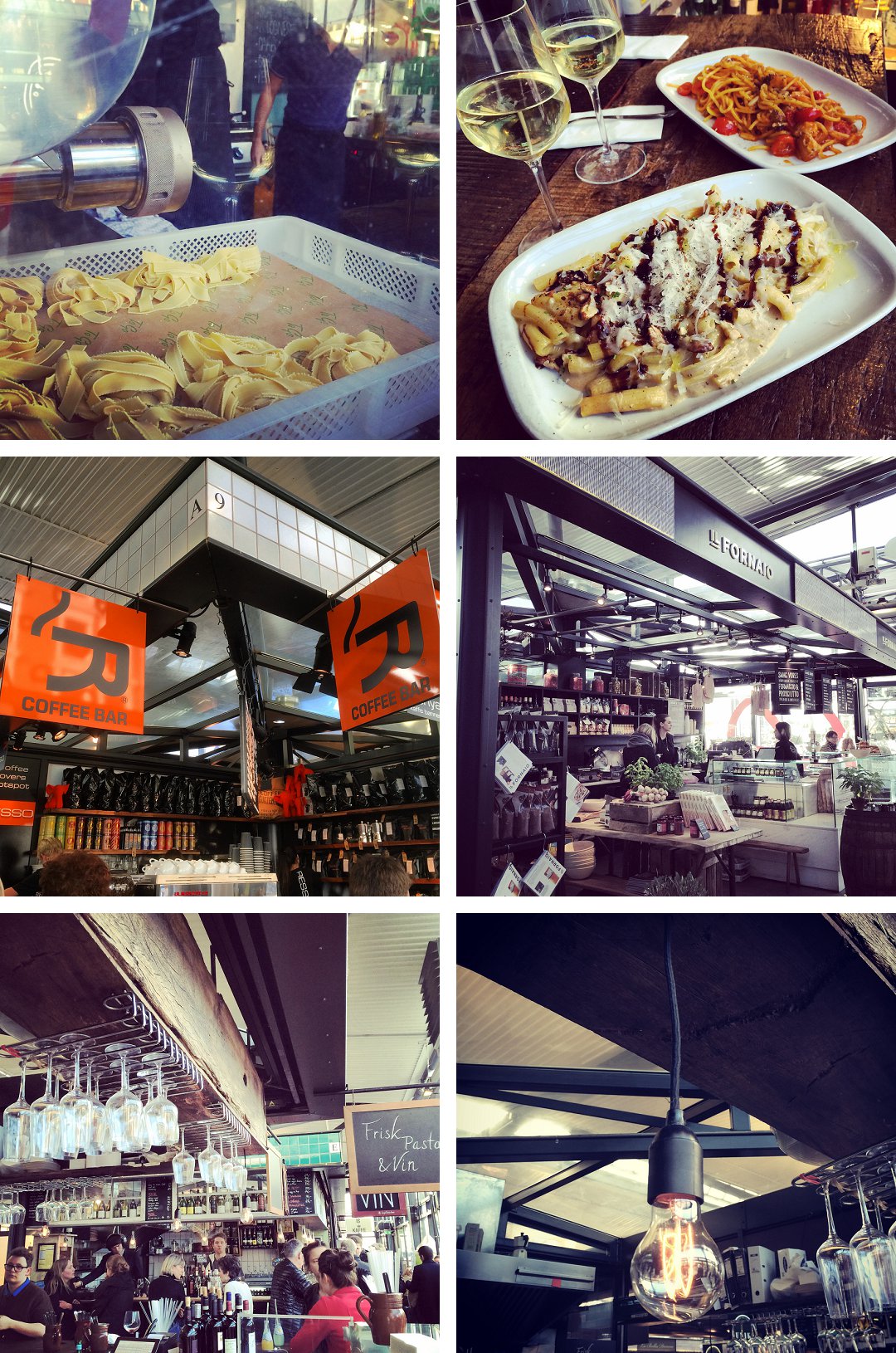
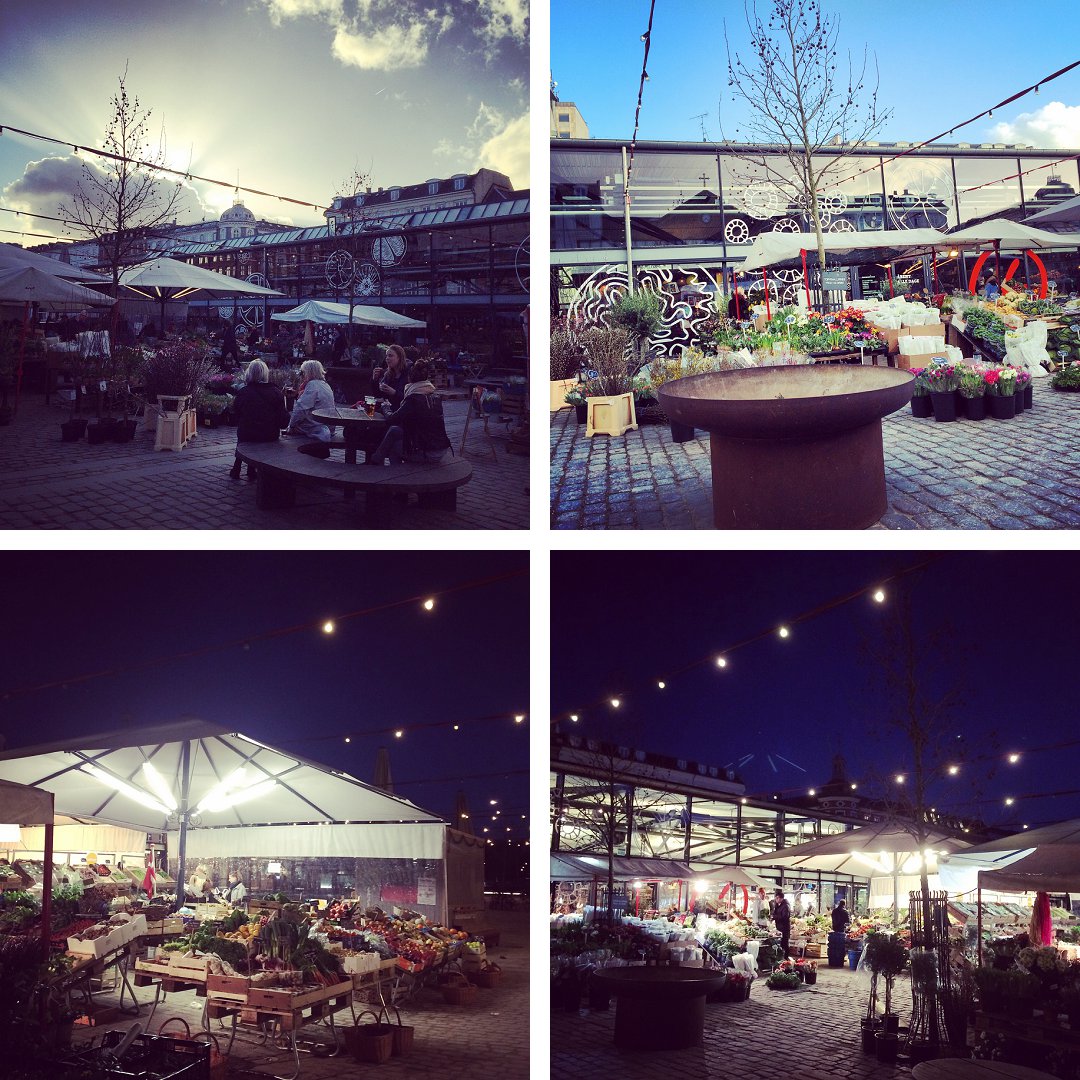
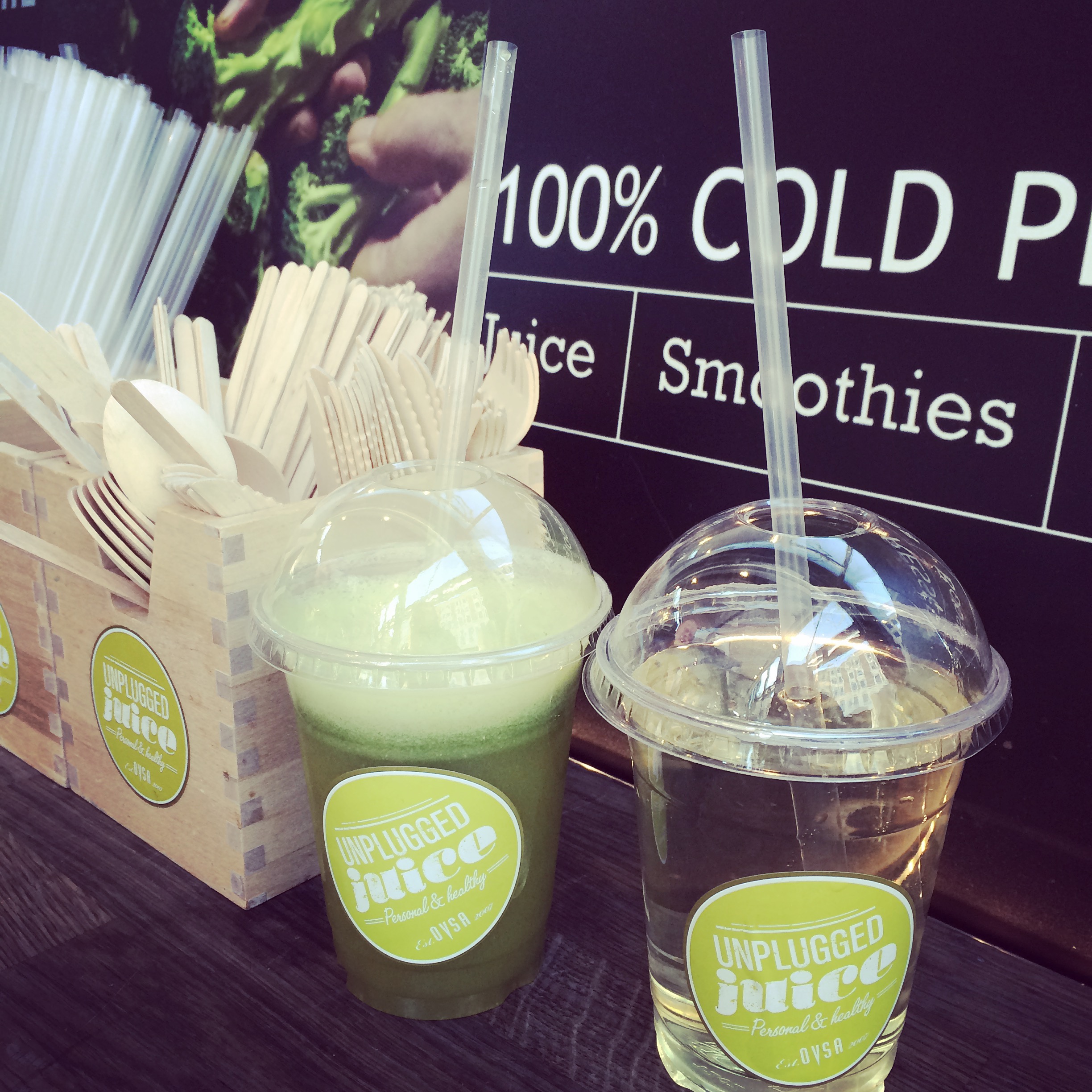
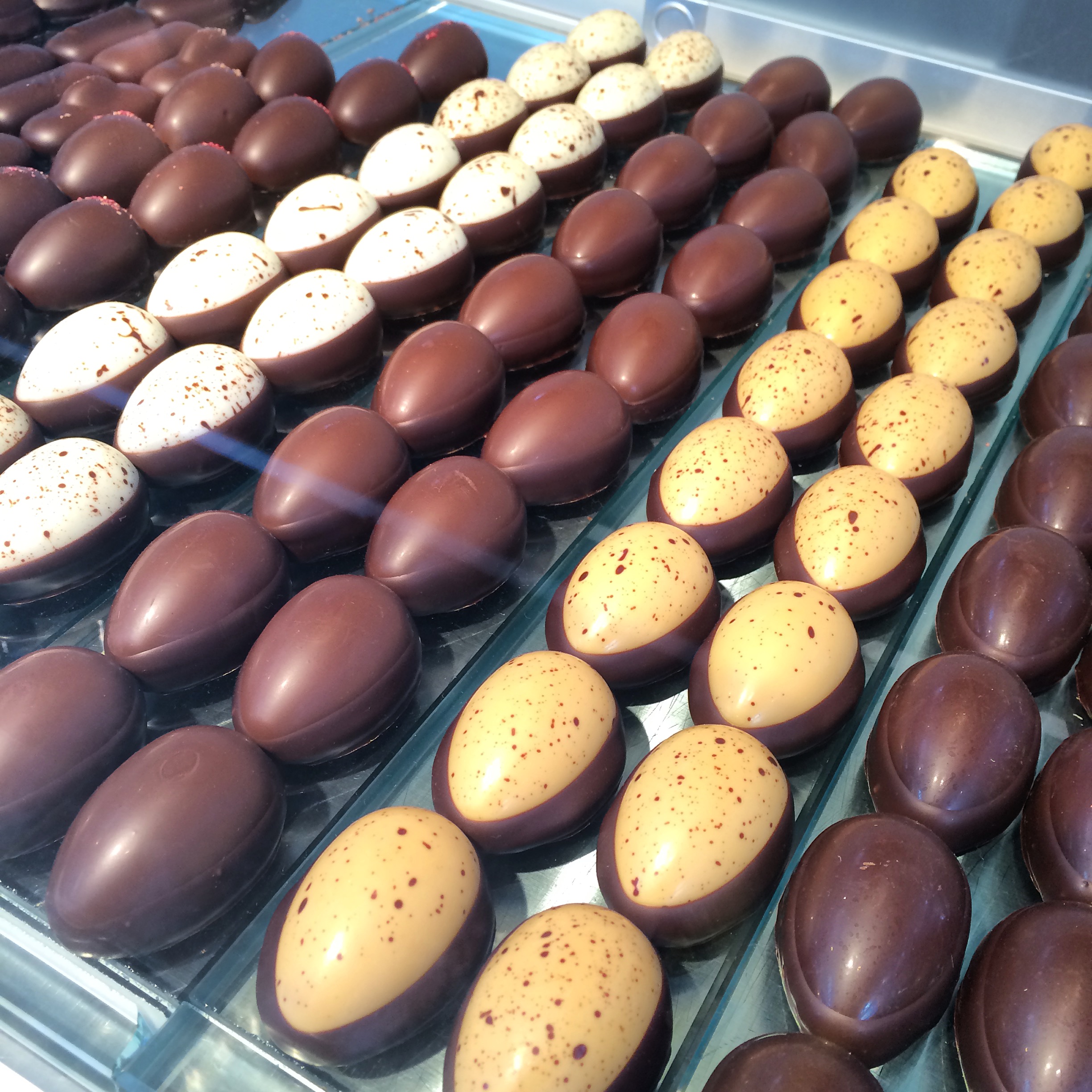
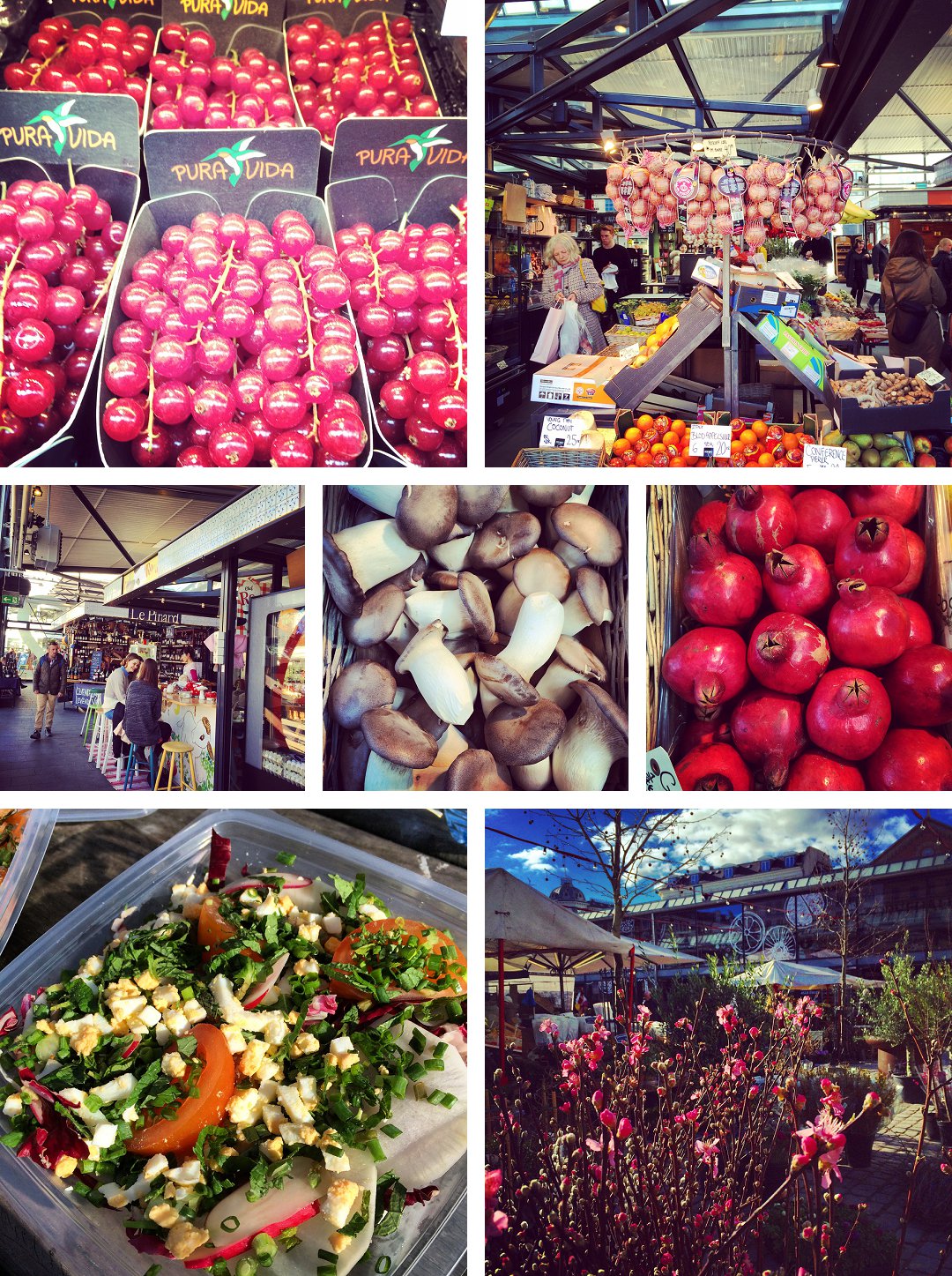
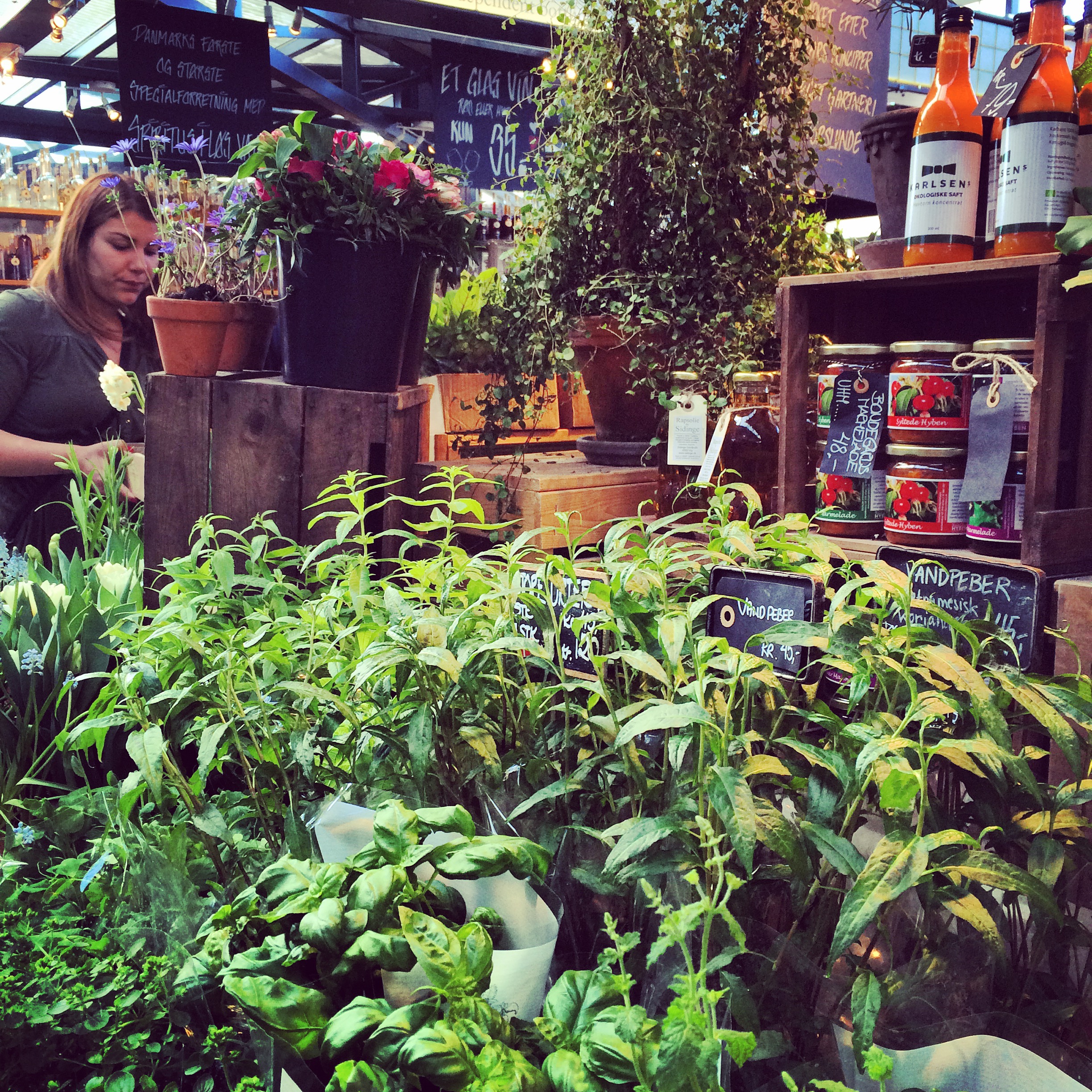
We totally love Copenhagen. Although it obviously can be very expensive, we found that you can do the city on your budget. We’re not Noma type people, so we didn’t have this kind of dilemma when it came to eating out and it’s another reason why places like Torvehallerne are such great choices, and why I could just not recommend this food hall enough.
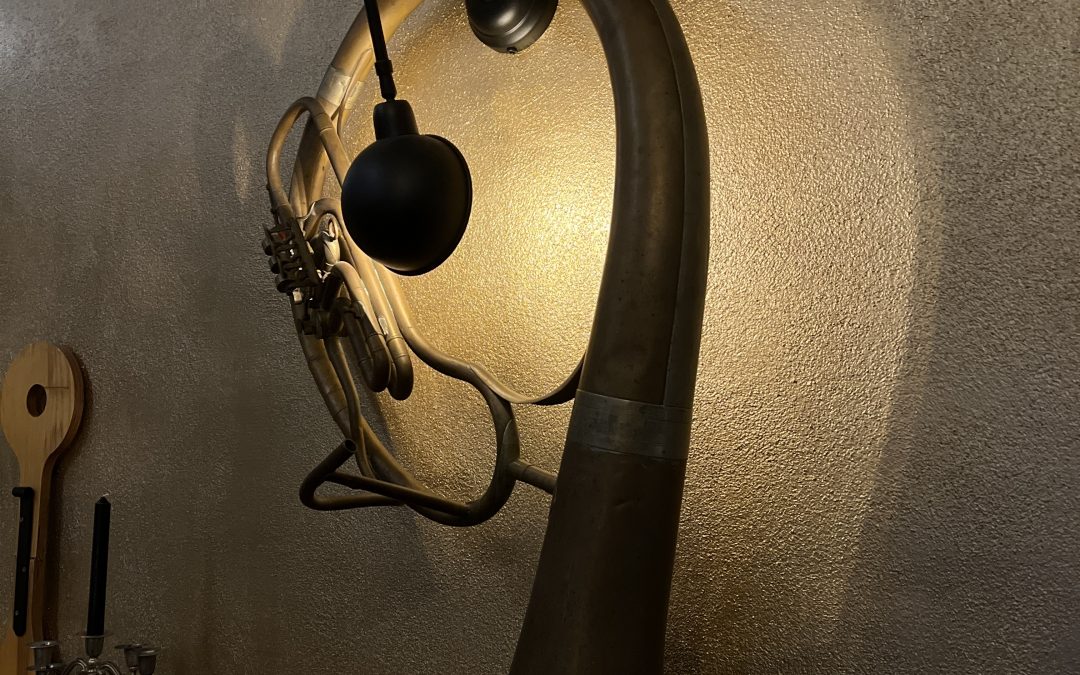
by Helen | Jan 17, 2024 | Lifestyle
The opening of a new bar is something quite exciting here, in northern Istria. Although we have lots of choice when it comes to excellent restaurants, cool bars seem to be more of a thing on the coast. In fact, bar culture doesn’t really seem to have taken hold here, in the way it has back in the UK, and so when we see, or hear of something which could slot right into Burton Road, in West Didsbury, we are all over it. Over on Instagram I spotted a fairly new account for a jazz wine bar in Grožnjan and was immediately drawn to the very stylish interior, so of course we had to seek it out at the weekend.
Jazz bars definitely aren’t my favourite kind of bars, as I’m not the biggest fan of this type of music. However, Grožnjan holds a really renowned Jazz Festival every summer, which attracts some top names that even I’ve heard of (Georgie Fame, anyone?), so a bar of this kind is probably right at home in this beautiful medieval hilltop town. It’s conveniently located right next to one of favourite restaurants in the area – aModoMio – down a short, but extremely pretty cobbled alley.
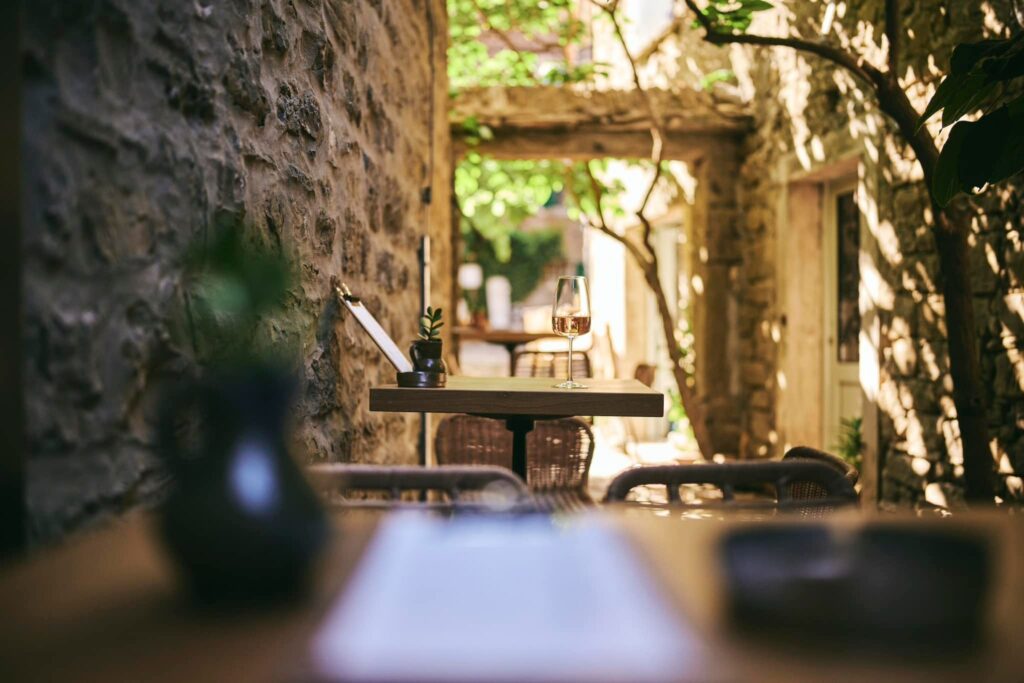
Housed inside one of Grožnjan’s typical old, stone buildings, Trubar Bar is a warren of higgeldy-piggedly rooms, on two levels, with a small terrace running along the rear of it, on the first floor, with incredible views across the Mirna Valley, to the other famous medieval hilltop town of Motovun. Bare stone walls are complemented and softened by chalk painted cabinets and shelving. The bespoke bar is the focal point of the entrance room, along with an area with reclaimed cupboards and worktops for the preparation of their charcuterie boards. Velvet drapes section off this area from the rear where the kitchen (I think) and the toilets are located.
Wooden stairs lead up to the first floor, and walls are decorated with vintage instruments, photographs of jazz players and tumbling greenery. The theme continues in the main upstairs room – it’s very cleverly fitted out, with plenty of seating and tables, and a couple of small chaise longues. It’s not a huge room, and could feel over crowded, but somehow this feeling is avoided, even when you also add in a piano, a drum kit and a dual turntable. The musical influences are evident everywhere, and it’s not all jazz, which I think is a good thing. Nice to see a vinyl copy of Sgt. Pepper’s Lonely Hearts Club Band, amongst the stack of albums.
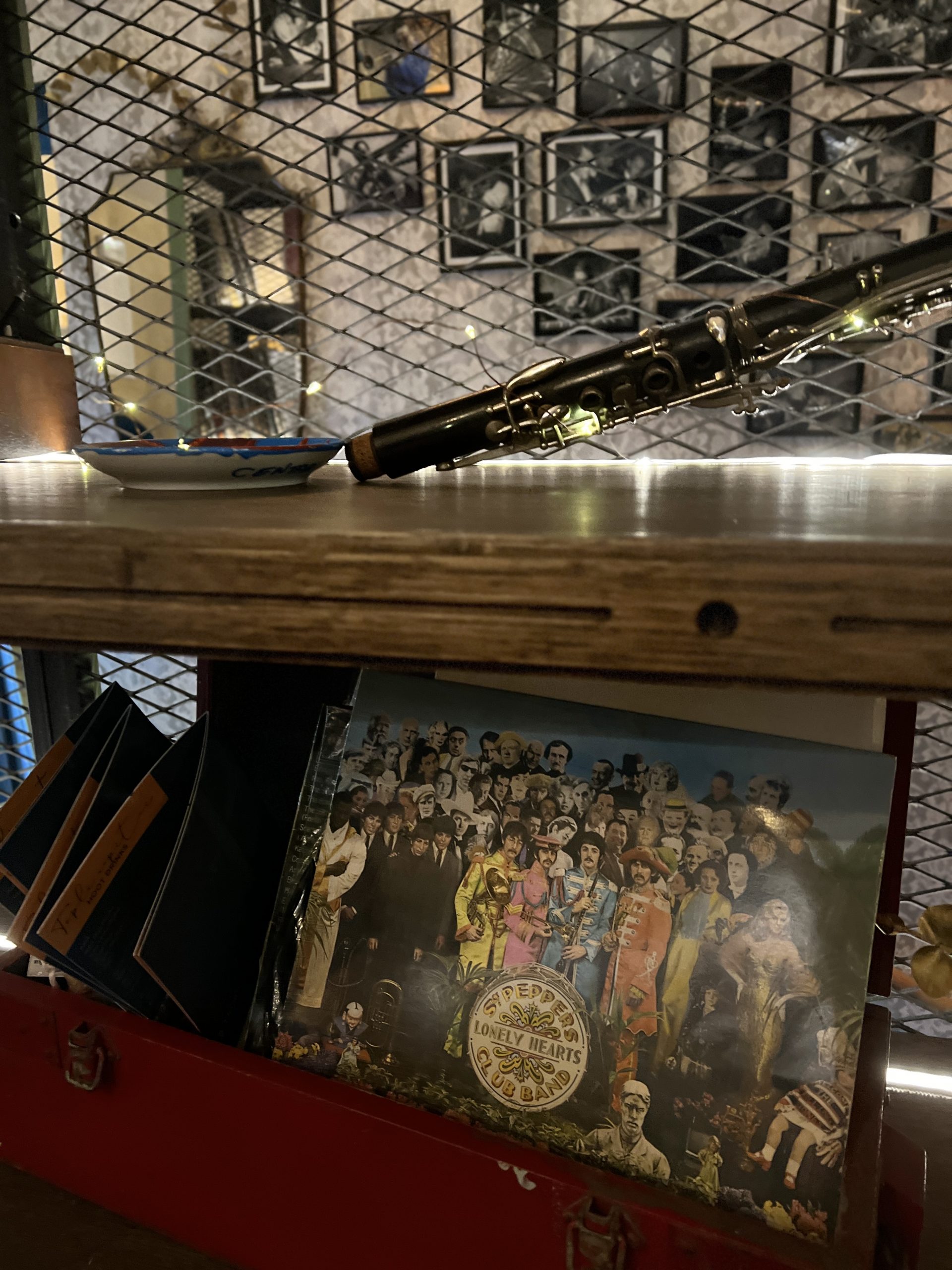
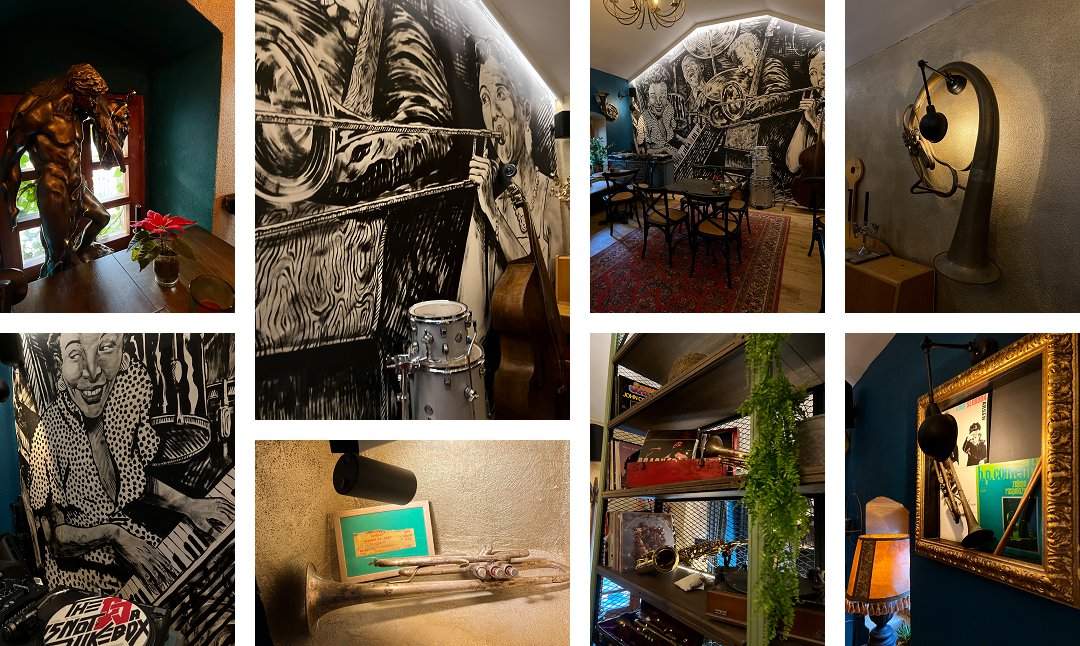
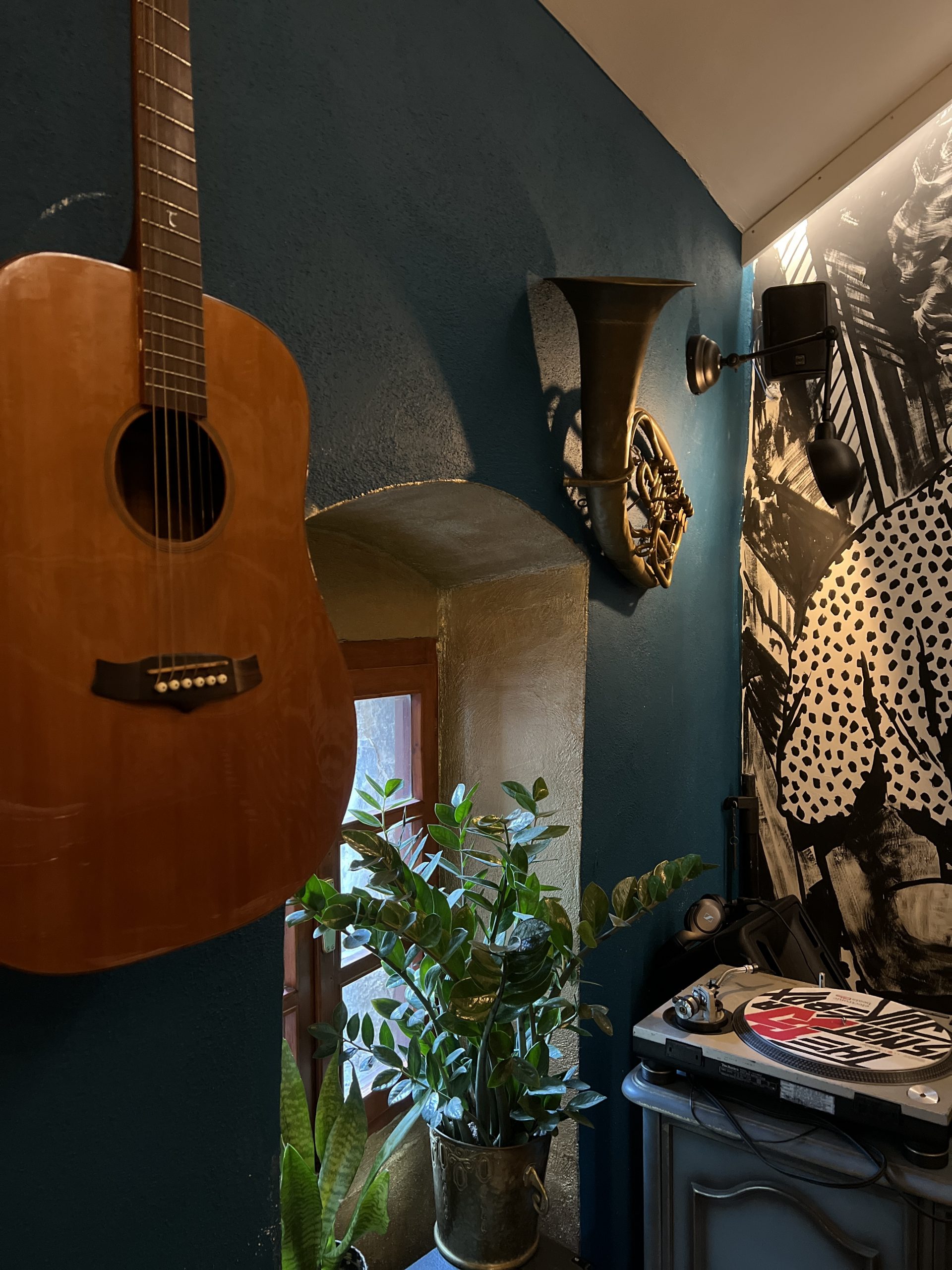
The second room on this floor is smaller – a couple of sofas and an exquisite velvet Chesterfield style armchair, with doors leading out on the narrow balcony. It was easy to get a seat out here on a sunny, but very chilly, Saturday afternoon in January but I’m guessing this space is highly fought over in the height of summer.
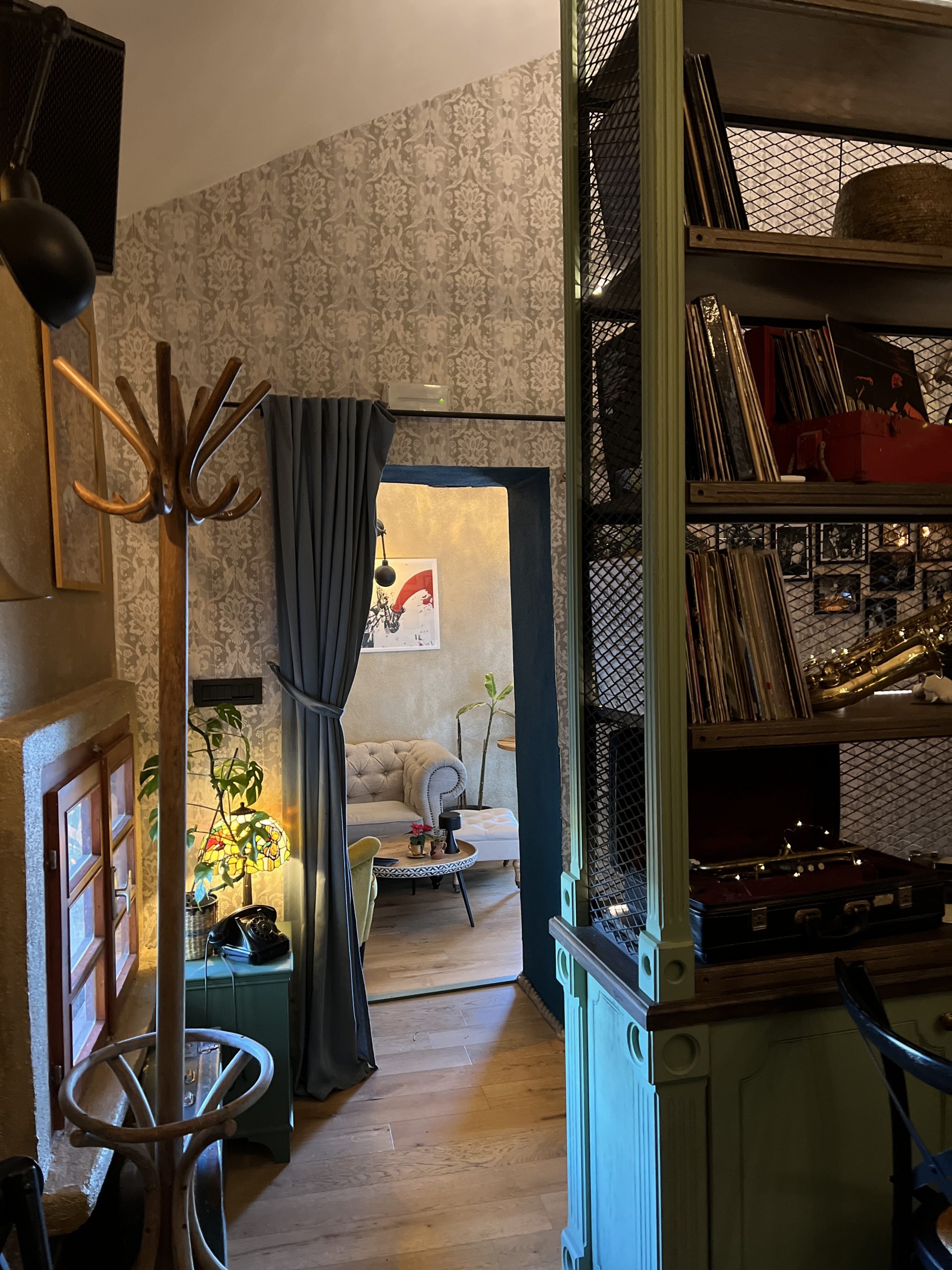
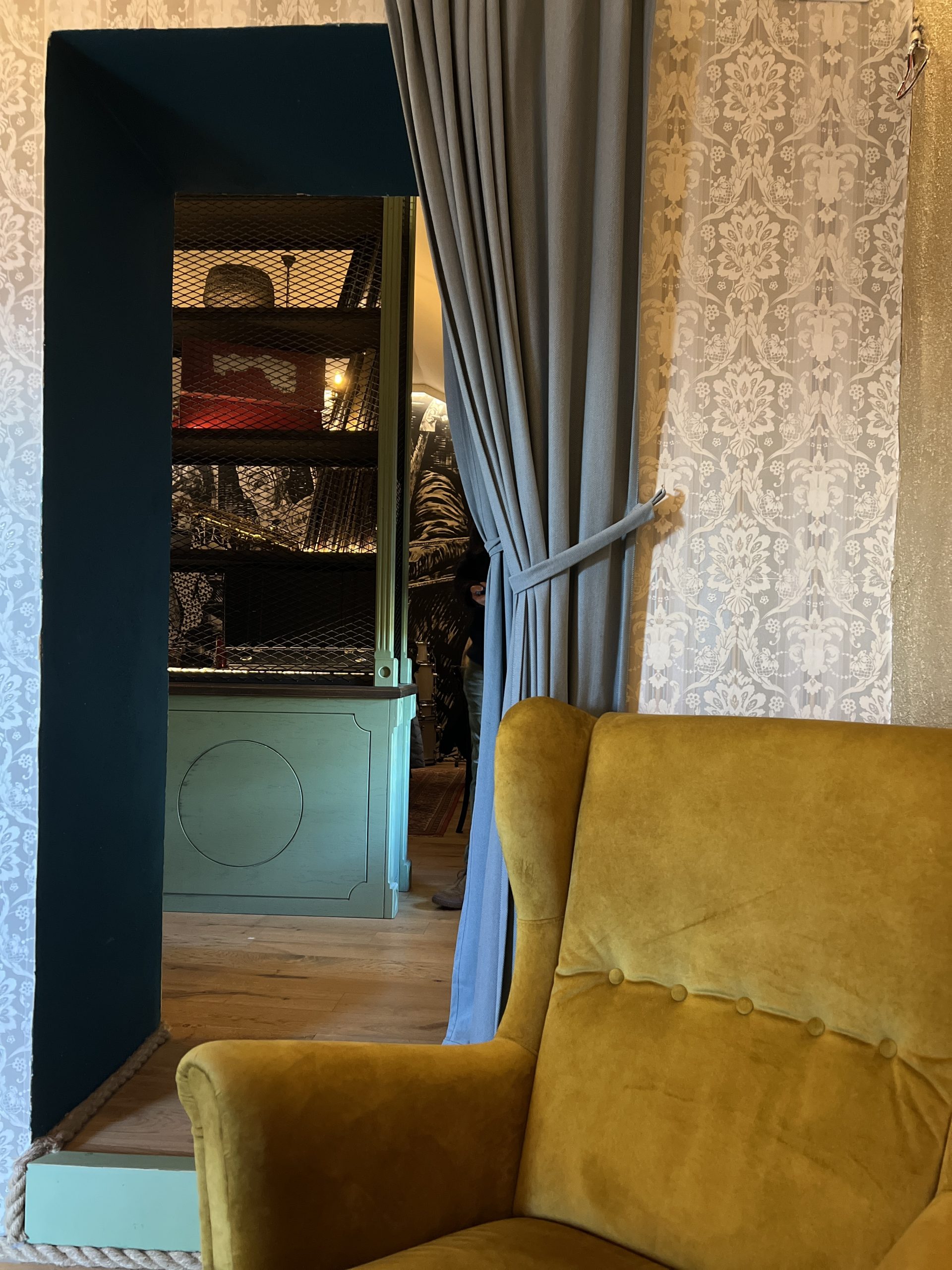
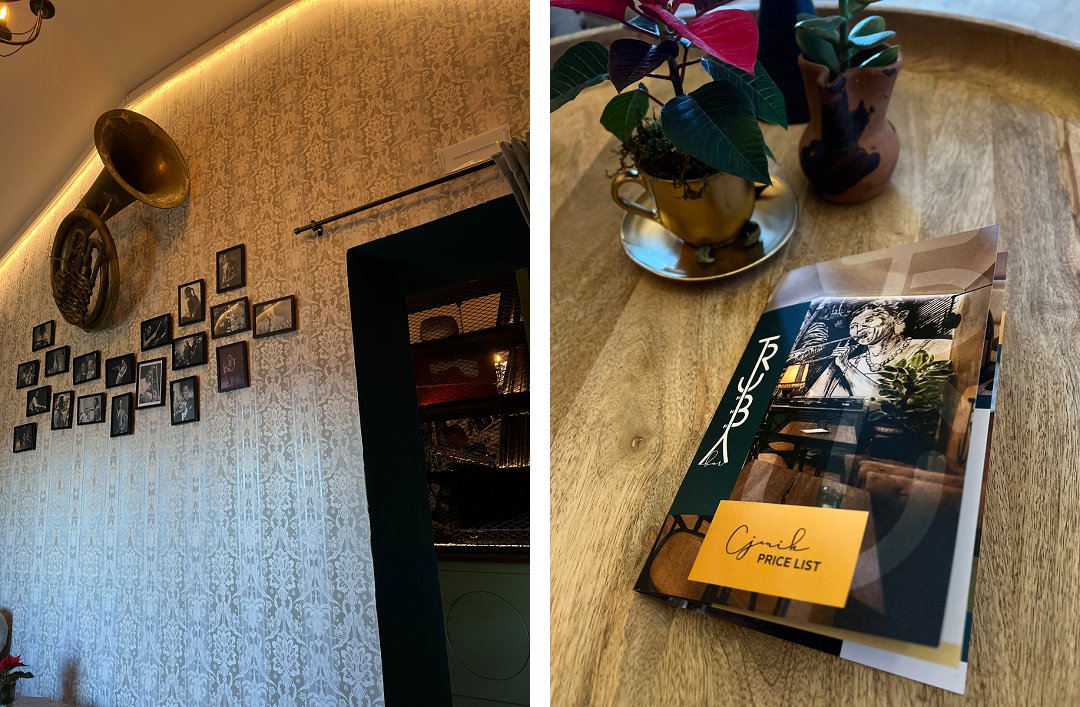
With the delicious local beer from San Servolo on draught and an excellent selection of very good local wines, as well as a range of cocktails, this bar has really thought things through. The charcuterie boards looked delicious – although they are a bit more pricey than other boards we’ve sampled locally. But, hey – if you want one, that’s what you’ll pay.
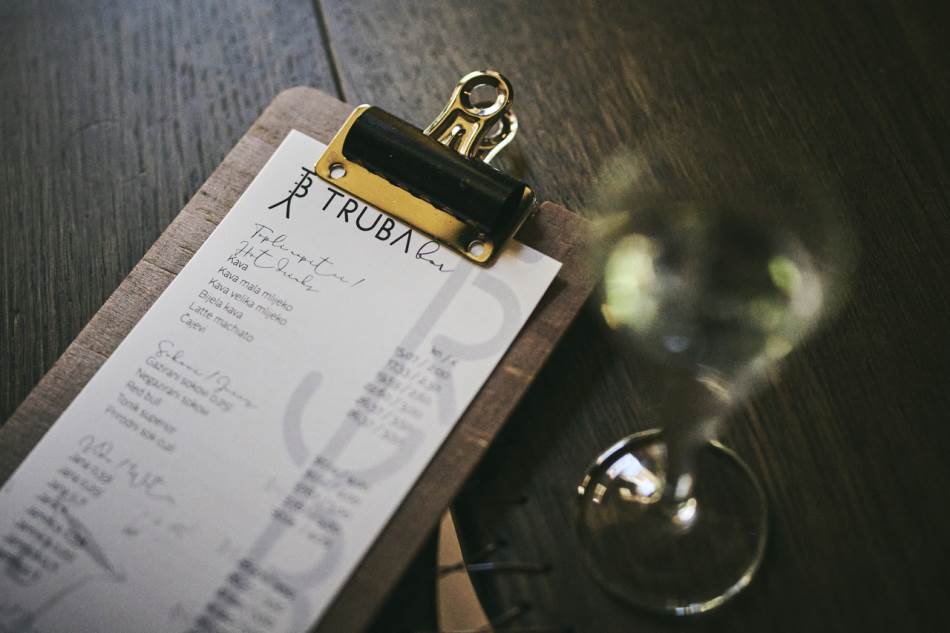
With dark navy walls, gold walls, dark wood, vintage and antique furnishings, industrial wall lights and moody lighting, this bar has, as far as we are concerned, got it right in terms of decor and ambience. OK, you may pay a little more than you might get elsewhere in internal Istria, but when you’ve been missing a cool, local bar, this seems a small price to pay. And, when you leave and this is the view you have across to the Adriatic, well, that’s pretty priceless…

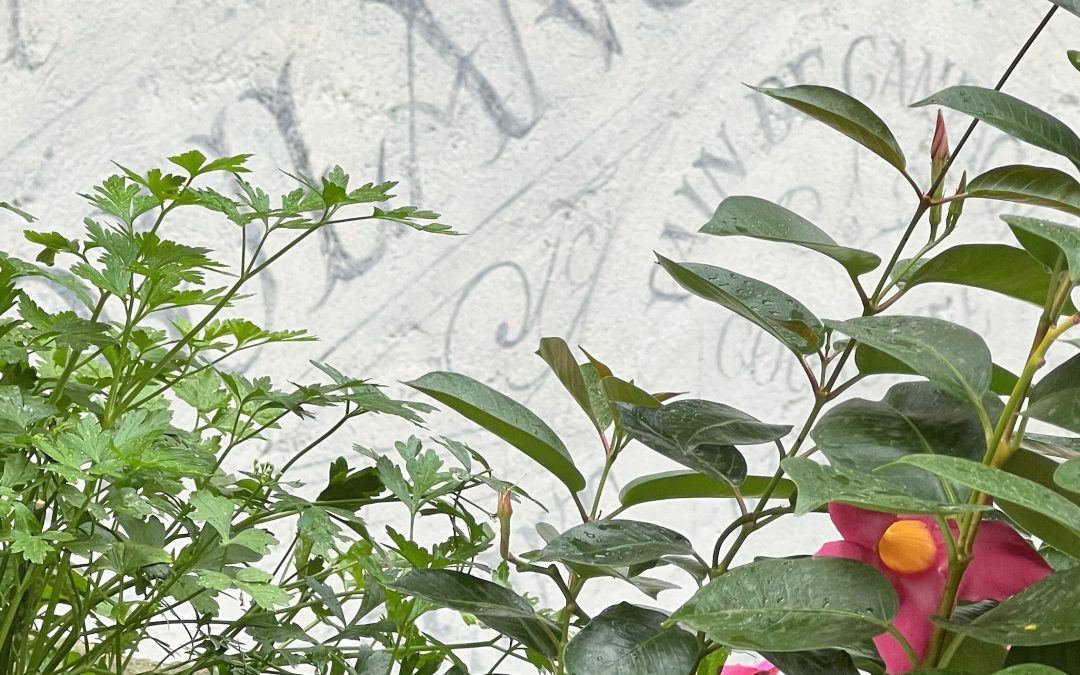
by Helen | Jan 16, 2024 | France, Travel
Sometimes you stumble across somewhere that is just too pretty to be real, even when the weather isn’t on your side, and instead of being bathed in sunlight, grey clouds and drizzle dominate. On the day we visited Caunes-Minervois, south east of Carcassone, it was one of those days. Summer had ended and autumn was starting to take a grip. Tourists had largely left and the steep, narrow, cobbled roads up from the medieval abbey were empty. Thankfully, we did come across a local who cautioned us about going any further up the road, in our wide Honda CRV – even though the road is accessible to vehicles, and we had been advised we could offload outside our Chambre d’Hote, the road was becoming more & more inaccessible, and so we had no alternative other than to turn around and head back down to the parking area outside the Benedictine Abbey. It’s worth knowing this if you stay at L’Ancienne Boulangerie, as you may find yourself dragging a lot of luggage up a steep cobbled hill.
However, all was forgotten when we arrived at the B&B, as it was so pretty and so quintessentially French. Wooden shutters, honey coloured stone, wrought ironwork and honeysuckle and ivy (I think) climbing around the front door,
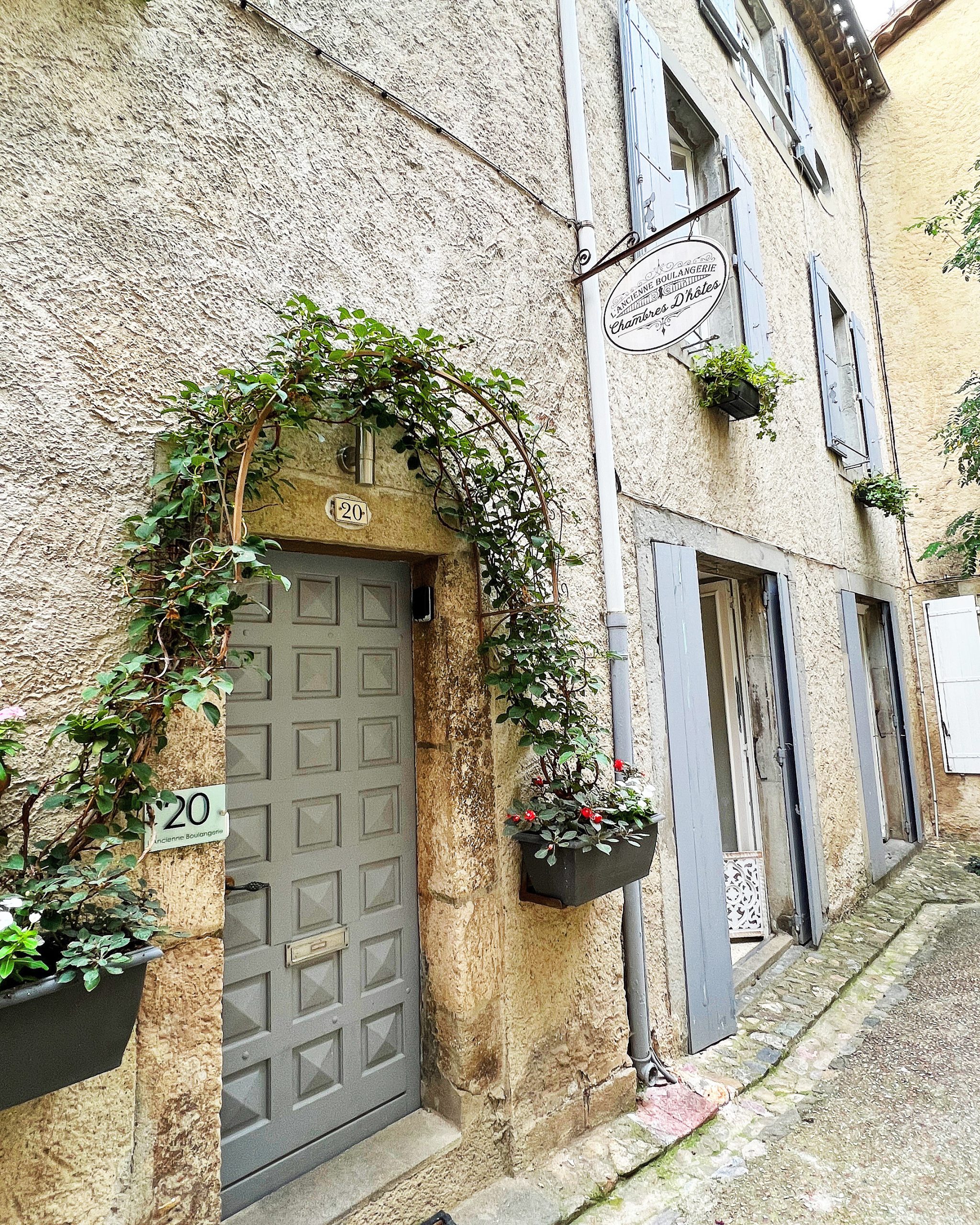
The frontage doesn’t really hint at what lies behind the front door. It’s a warren of corridors and rooms and a winding, quite steep staircase – which again, if you have mobility issues, you might want to be aware of. It’s a beautiful old building, which apparently used to be the old bakery – l’ancienne boulangerie – which served both the village and the abbey. Now, it’s an absolutely delightful Chambre d’Hote with three, maybe four bedrooms, a beautiful communal lounge, a large breakfast/dining room and a terrace, accessible from an upstairs corridor, and the room we were allocated. The Australian owners have put a lot of love into this building, to create a very pretty B&B, full of antiques and curiosities and vintage finds. Nothing perfectly matches – and the deliberate mis-matching works well, as every room and nook and cranny has something of interest to absorb.
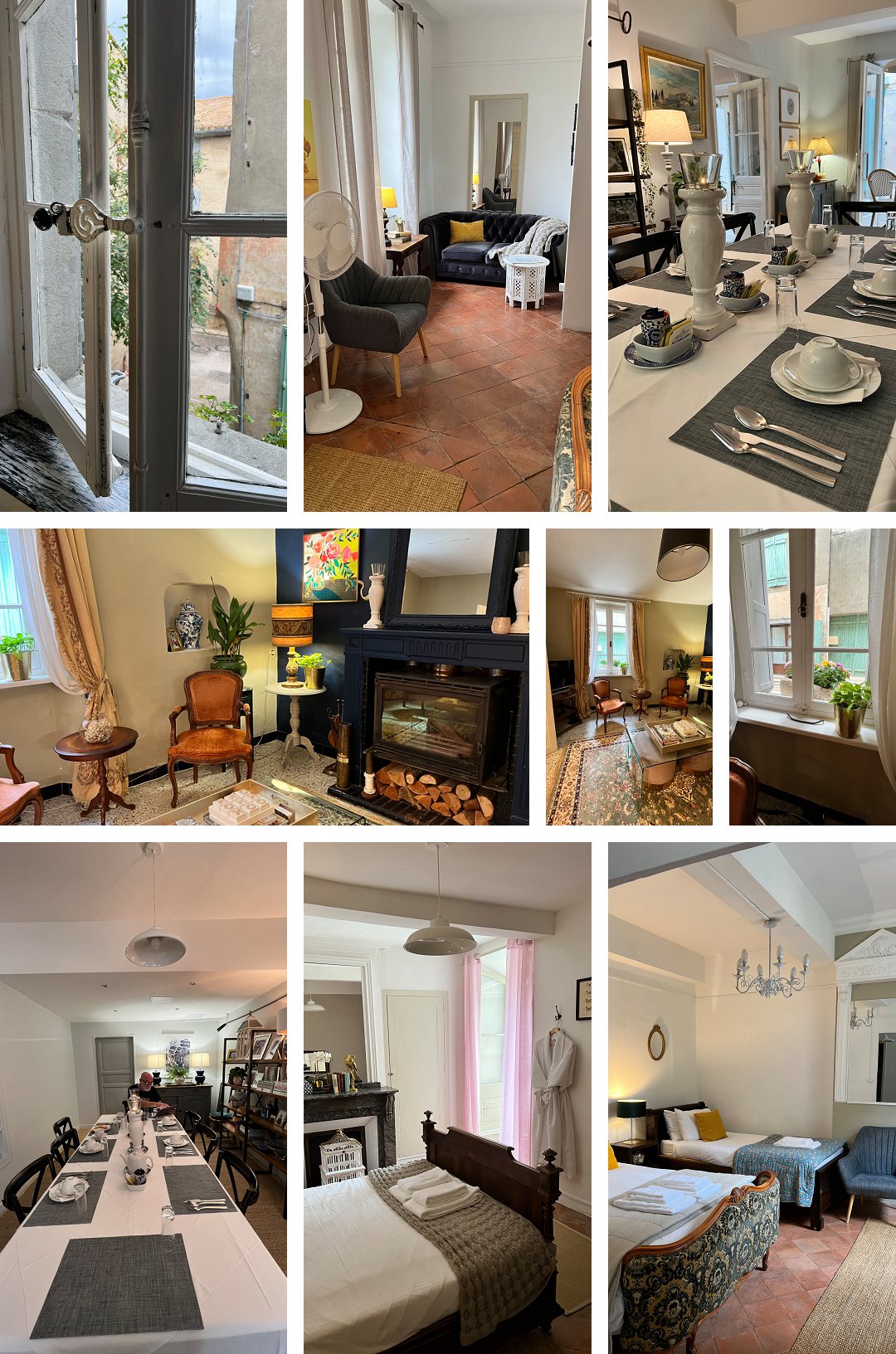
Our room was pretty, and again, very typically French, with chalk painted furniture and a big wooden framed bed. It did have an en-suite of sorts – a shower cubicle in the room, and a toilet behind a door (in what was probably once a cupboard) and a wash basin in the room. So, not the best arrangement, but OK for just one night. Perhaps the best thing about the room was its access to the first floor terrace, through French doors. Other guests can access it via a corridor, but it did feel as if it was ours, and therefore, very private.
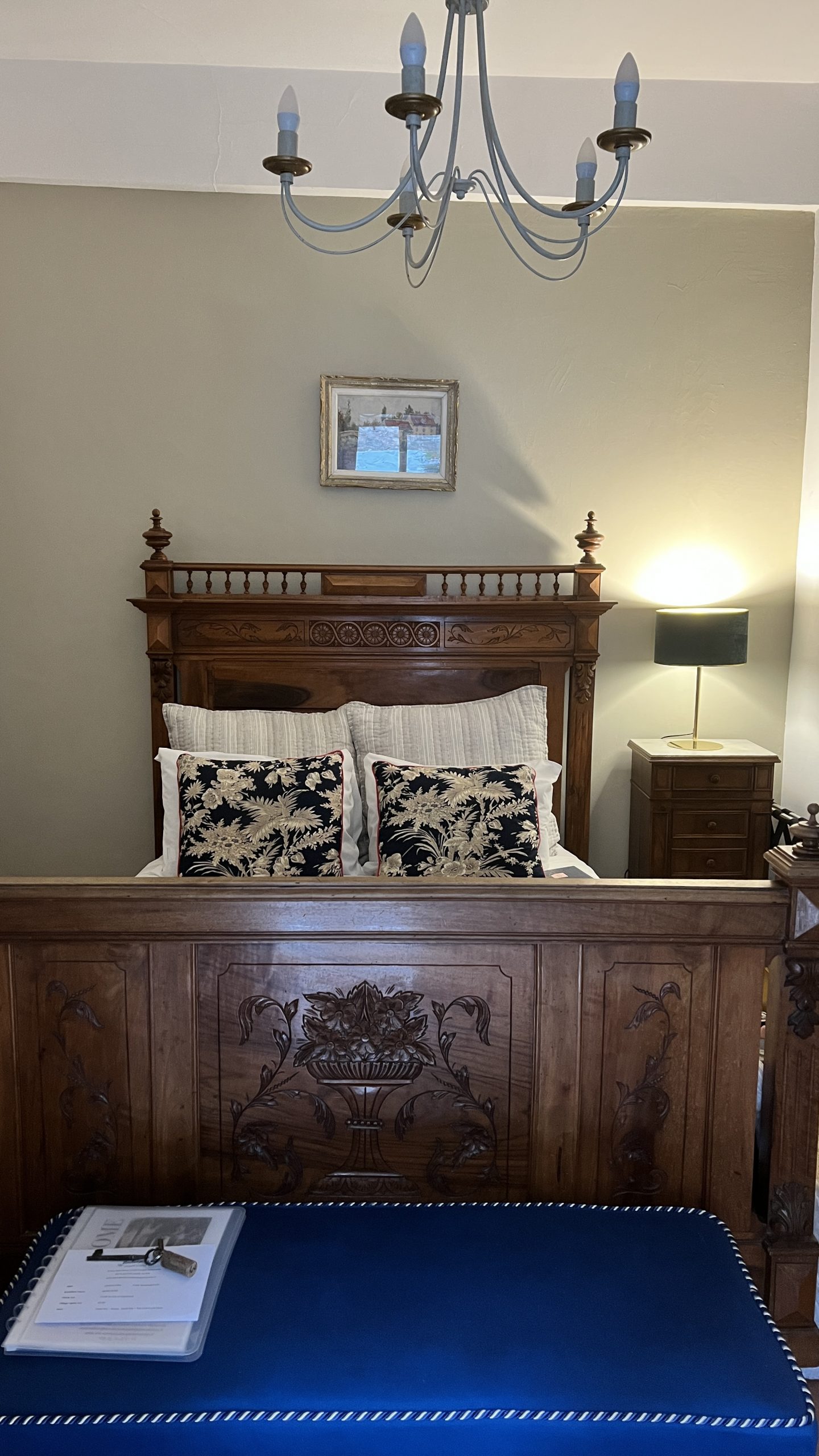
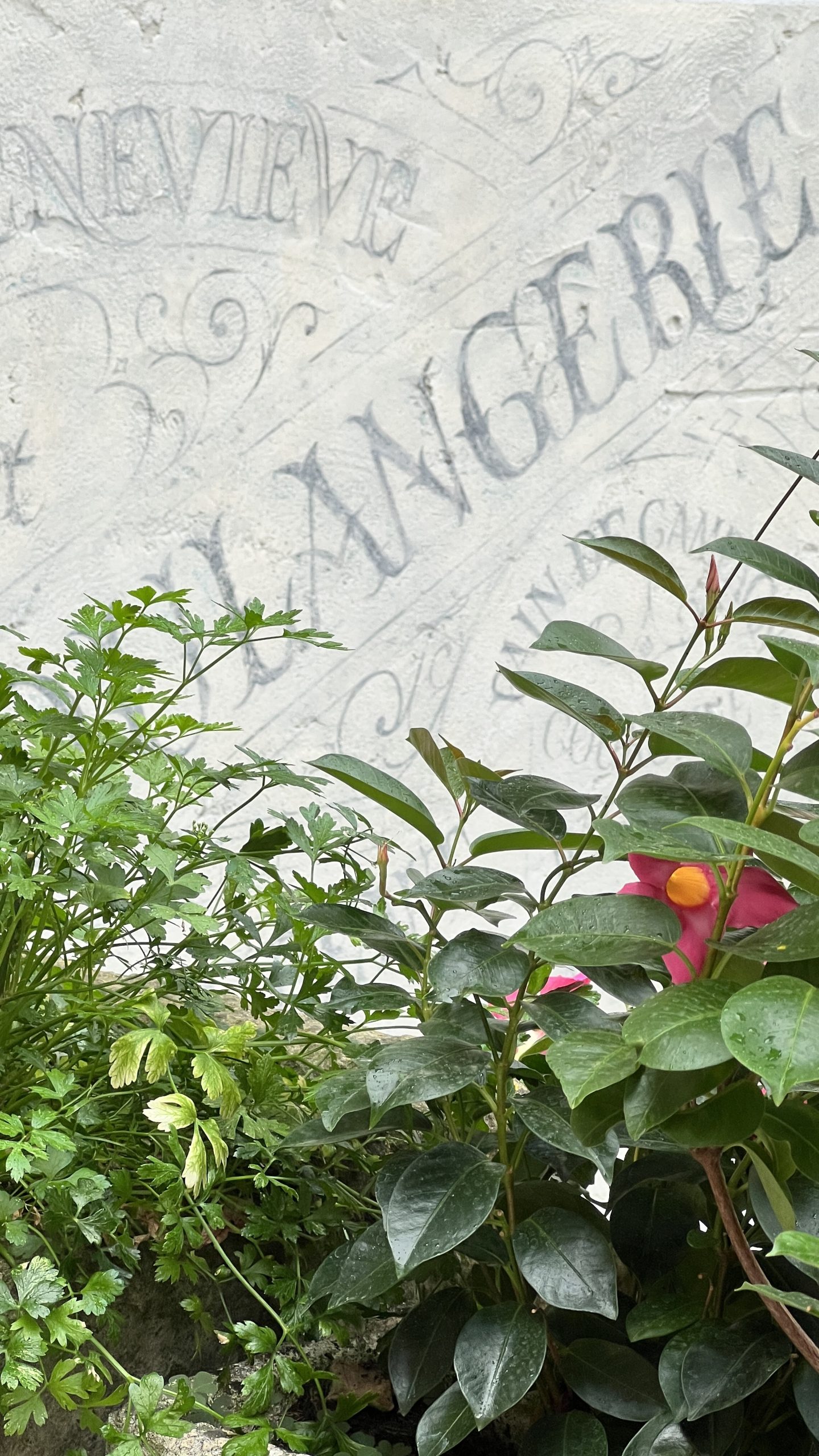
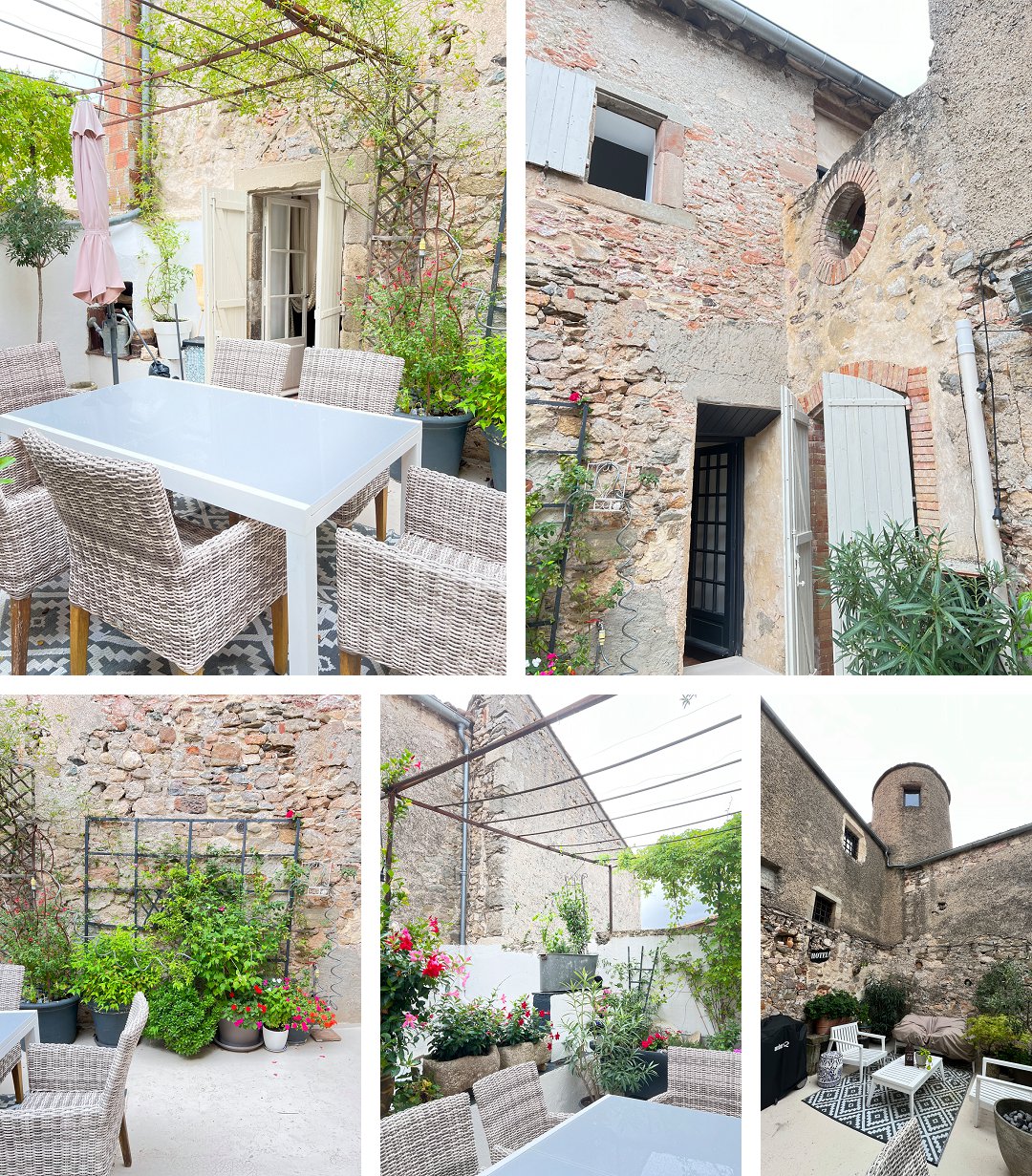
We didn’t see the terrace at its best, as it was a grey. drizzly day at the end of September, but there were still enough clues to show that in the summer, this would be a lovely place to either soak up the sun on the loungers, or enjoy a pre-dinner drink, or two.
Breakfast was a leisurely affair, chatting to the owners and enjoy a typical French start to the day – excellent coffee, juices, hams, cheeses, fresh bread, croissants and jams, home made yoghurt and fruits. Again, had the weather been better, the breakfast room would have been even more pretty, with sunshine streaming in, but candlelight and soft lighting set the mood very well. It was clear that this B&B is at the very heart of this village – people stopped to chat by the open window and a couple of locals popped in for coffees.
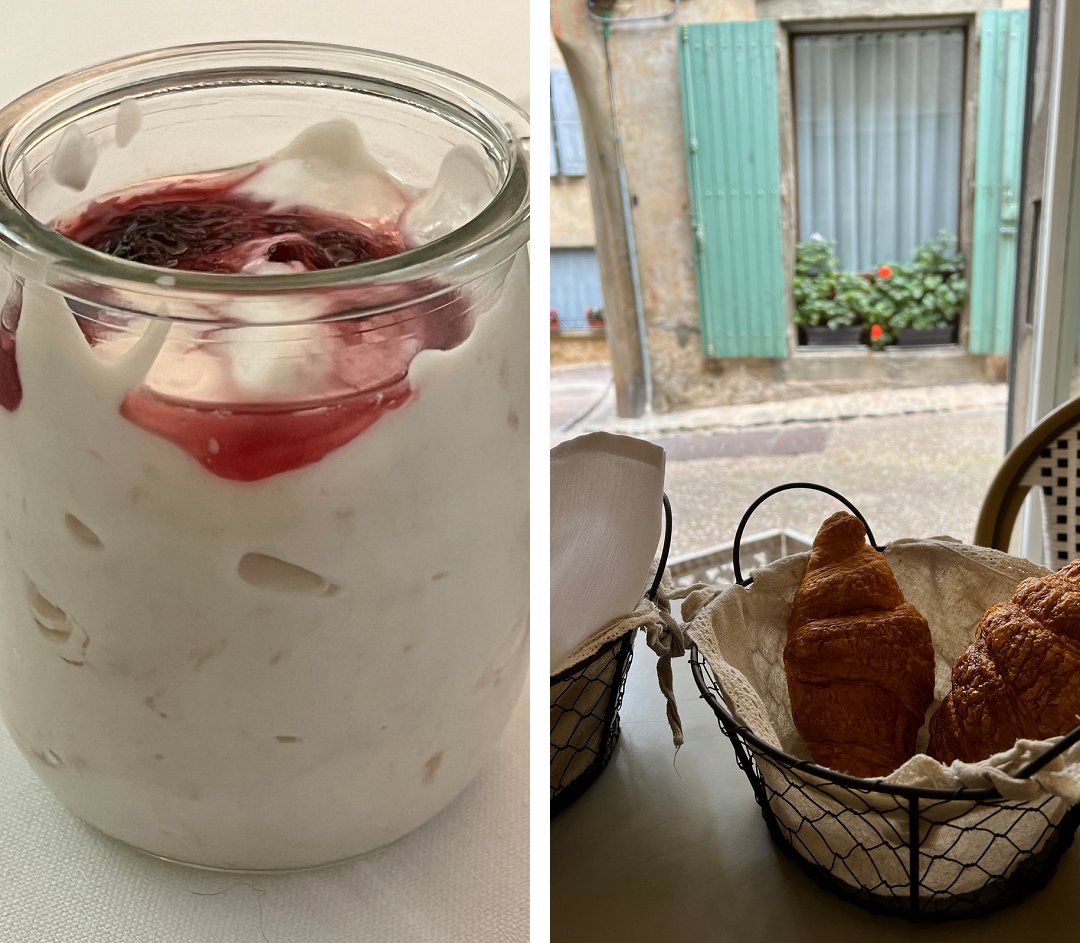
And, as we found with a few of the French establishments we stayed in on our recent roadtrip, a dog was part of the deal. This one was very placid, and was no bother at all – but again, if you have an aversion to dogs being anywhere near your breakfast, it’s maybe worth knowing that this one is allowed to wander. But then, aren’t they all?
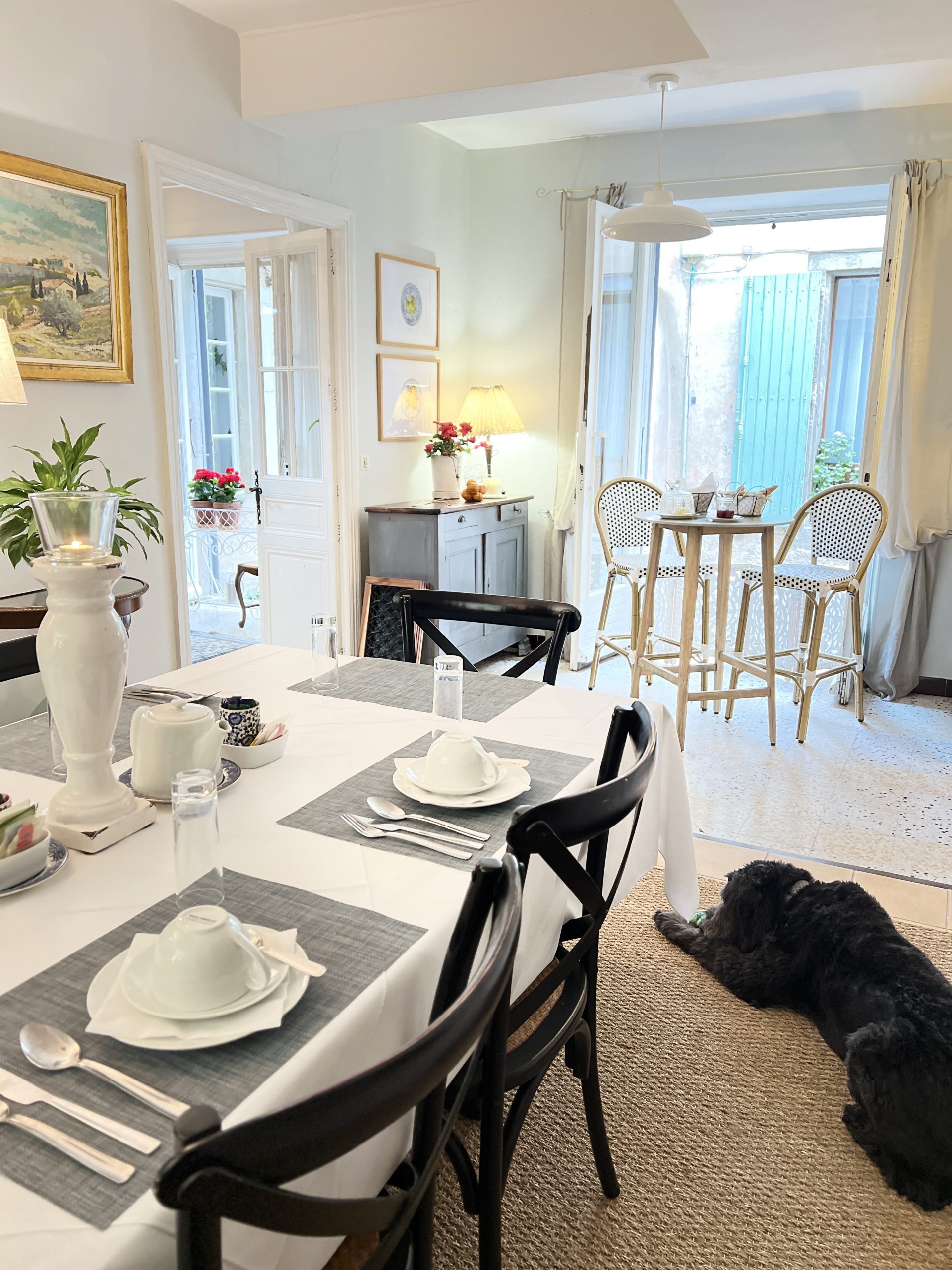
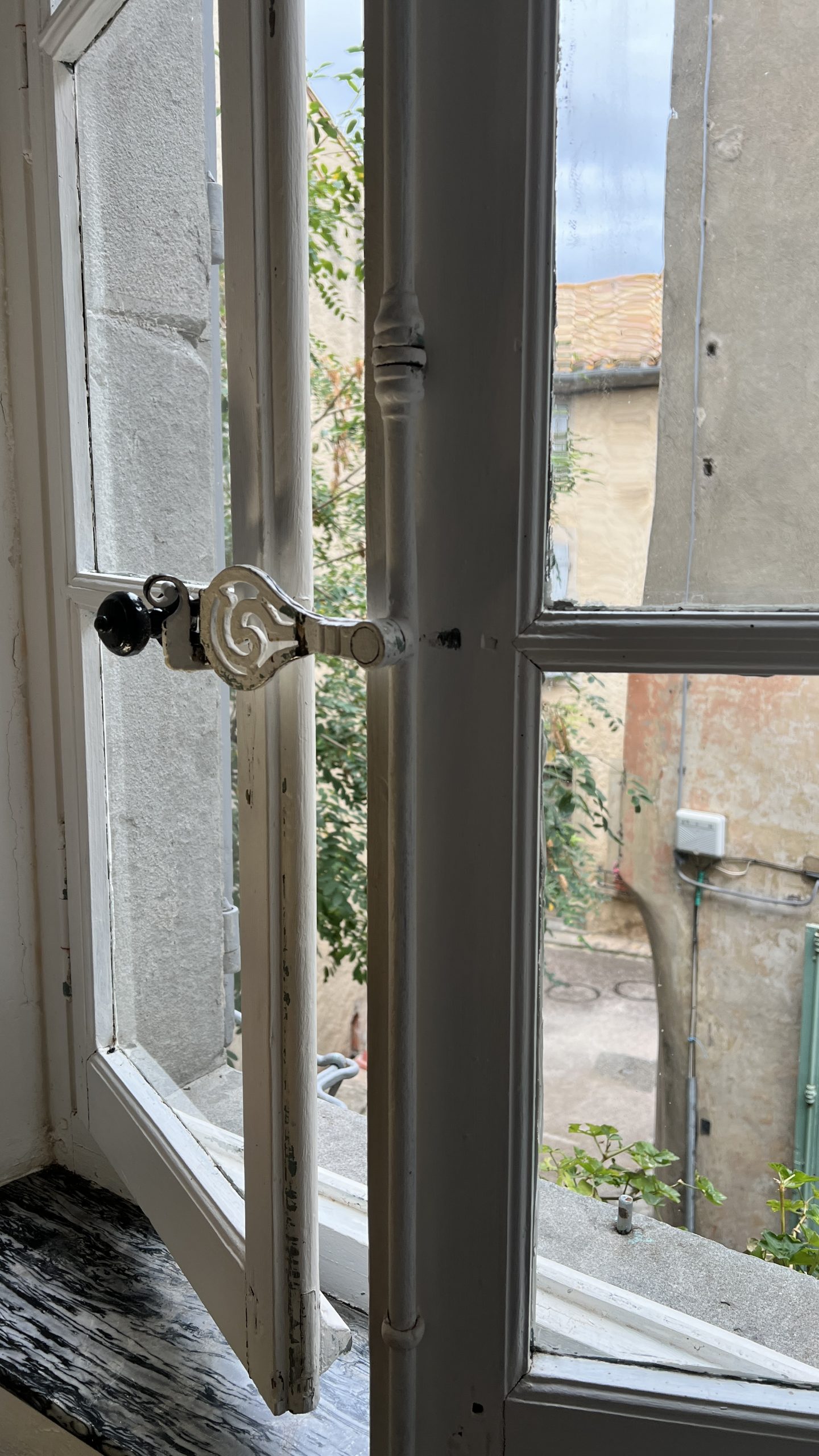
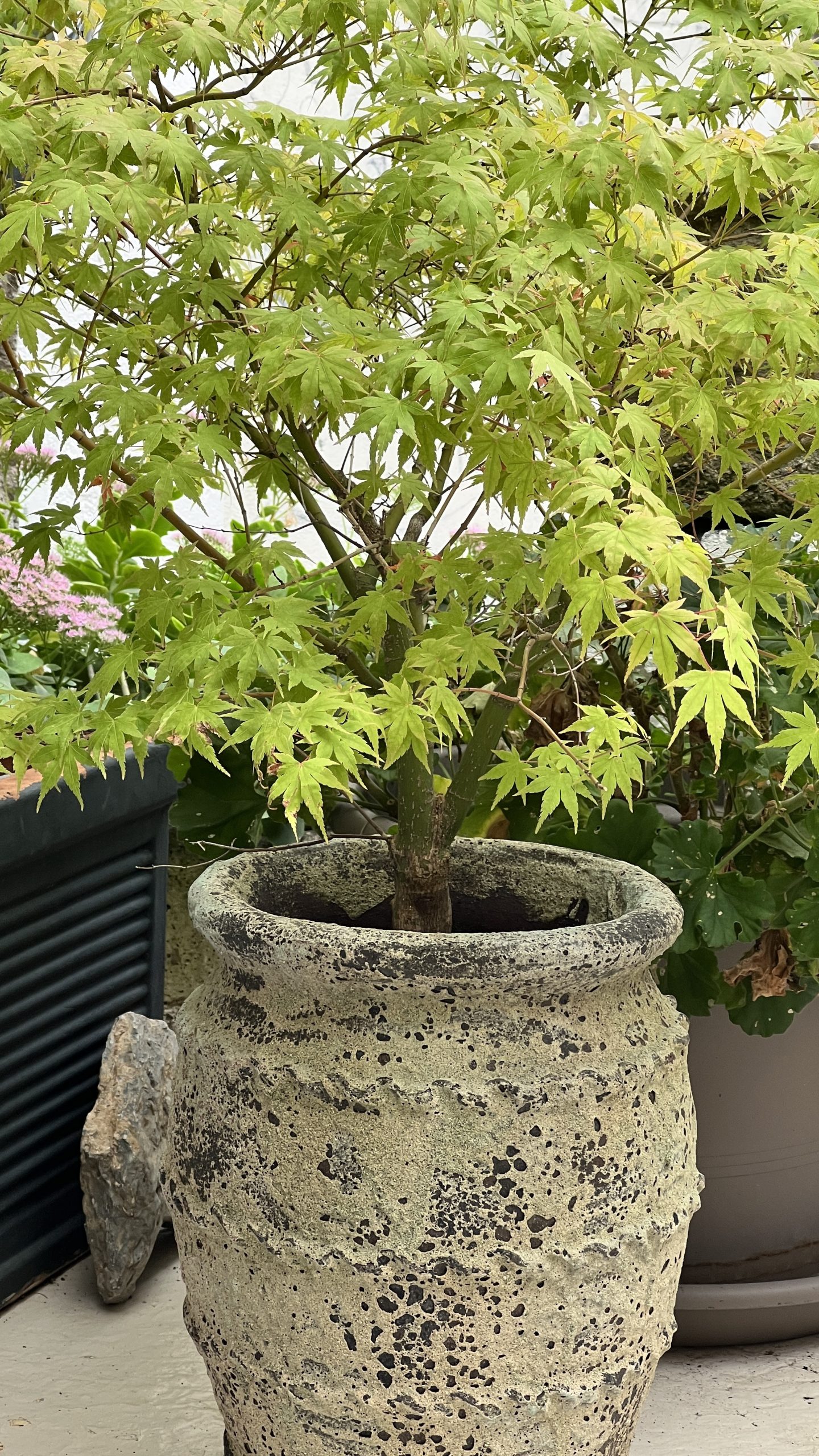
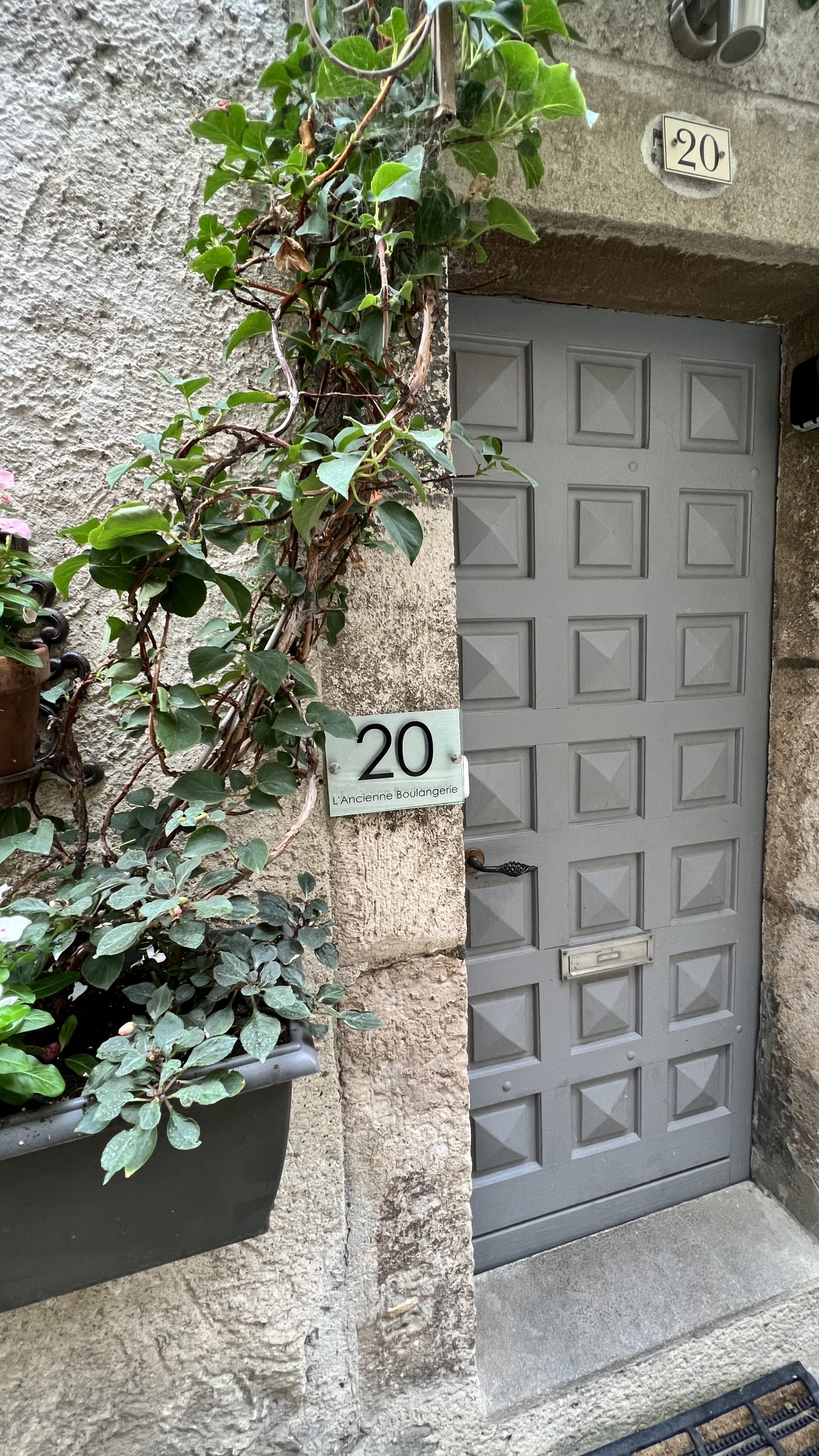
Because of the weather and the shortness of our stay, I don’t think we saw the best of L’Ancienne Boulanagier or Caunes Minervois, but we were still impressed. If somewhere could be this pretty and picture-book on a dull day, I can just imagine how stunning it all must be on a bright summer’s day, when everything is in bloom and the light reflects off the beautiful stone buildings. Given how big France is, and how much there is to explore, I can’t see us making a beeline back – we’d obviously revisit if in the area – so I’m glad we did get to see this quaint medieval town this time around.
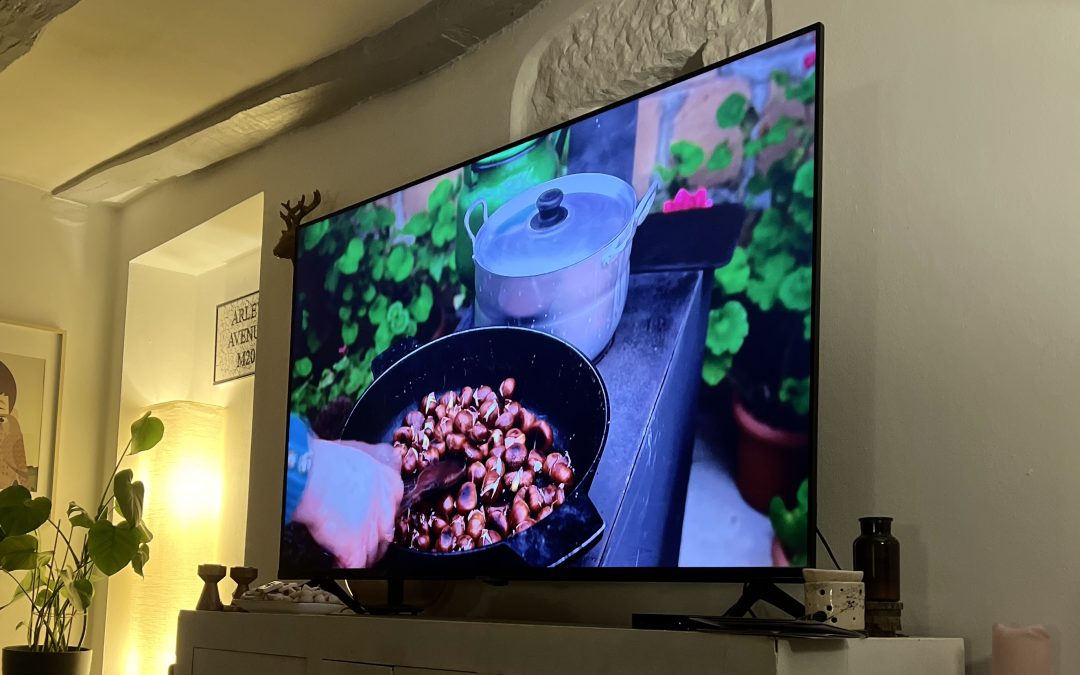
by Helen | Jan 11, 2024 | Lifestyle
A couple of years ago, in the depths of winter, we were staying in an apartment in a hotel on the edges of Zagreb. It was cold and dark and just a bit too far to walk into the centre of the city for a meal. So, with cooking facilities in the apartment, we decided to stay in. We had pasta, we had wine, we had wi-fi and we had access to You Tube on the TV. I can’t remember what we logged on to watch, but the last person’s choice of viewing caught our eyes and piqued our interest – the Country Life Vlog.
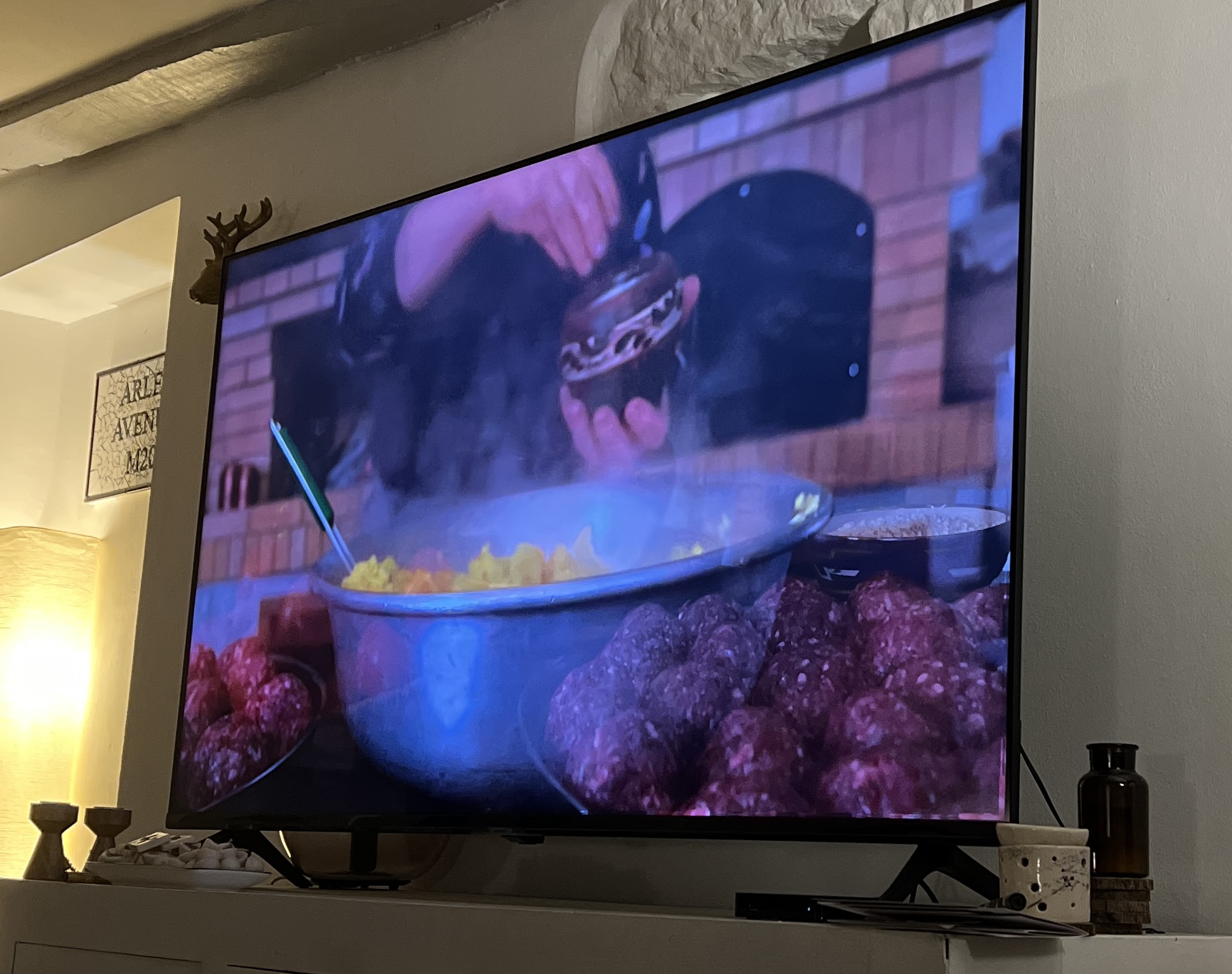
Filmed entirely on location on a remote farmstead in Azerbaijan, nestled beneath the Greater Caucasus Mountains, it largely features the matriarch, Aziza and her husband and their assortment of farm animals and pets. The story behind the vlog started when their son, a professional chef called Amiraslan, was working in a restaurant in the capital, Baku, which was forced to close due to the pandemic. Amiraslan saw this as an opportunity to share their region’s dishes and way of life with the world, and he returned to his native village and began to create videos of his family at work preparing traditional dishes and doing traditional jobs around the farm. In a year, their Youtube channel gathered over 450,000 subscribers with many of their videos reaching over one million views.
No sound accompanies these videos – which can be short as 10 minutes or as long as 40 minutes, depending, on what is being prepared and cooked – apart from the sounds of peeling or chopping or frying. Sometimes you’ll hear the sounds of nature – chirping birds, miaowing cats, yapping dogs, buzzing insects – but dialogue between the wife and husband is very, very rare. Mostly, they are totally engaged in their own work. She does the cooking. He does the manual work. There is no voice over. There’s no context which explains the vlog. But the more you watch, the more mesmerising it becomes. Although where we live now is pretty rural, we have 100% access to everything which makes our lives easy and totally 21st century. We can hop in the car and be in the hustle and bustle of Trieste within 40 minutes. If we need a litre of a milk, although it’s not as easy a nipping across Burton Road to the Co-op, we can easily get one within half an hour. We have access to strong and secure wi-fi, meaning that we have 24/7 access to what is happening in the world and are in very regular contact with family. So, although we are quite rural in terms of our location, our lives are still essentially like the ones we lived in West Didsbury. And, I think this is what makes the Country Life Vlog so compelling – it gives you a real time insight into a very different kind of life. A life that could have been lived in a different time.
All of the ingredients comes from the land and their animals. Everything is made from scratch and always in huge quantities – off camera, I do hope there are a lot of mouths to feed! The filming of everything is just beautiful – it is simple in technique, but evocatively beautiful in style. A close up of Aziza deftly chopping onions. A bowl of glistening red cherries. A turkey, fanning its tail feathers, the family puppies bounding around in the snow. An axe, swiftly chopping mountains of logs, to fuel the open stoves and fires that the cooking is done on.
The cooking is as authentic as you would expect. As well as Azerbaijani cuisine, expect influences from around the world. Expect to see demonstrations of how to make traditional lamb stews, cabbage dolma, kebabs and baklava, as well as pizzas, paella and cinnamon rolls. But don’t expect to see a sanitised version – this ain’t Nigella Lawson! Expect to see butchering. Expect to hear knives cutting through animal bones. Expect to see plucking. But also expect to see cooking done in a way that we don’t see any longer – it’s amazing how mesmeric the chopping of vegetables can be, or the peeling of fruit, or the grating of cheese. And, you can always filter out the more “real” demonstrations and opt to watch the episodes which focus on less meat and less gritty reality. (They also have episodes where they actually show how to make/build things essential to their lives – an oven, a woodstore, a firepit, for example).
The Vlog is filmed all year round – with the food that is being cooked obviously reflecting the seasons – so you get a real sense of the way this couple live their lives. It’s clearly a much easier life in spring and summer, but definitely not a life I would relish, as their hard work on the land continues, relentlessly. But the beauty of their surroundings is magical, especially when everything is in flower and growing profusely. Winter filming shows how these people just “get on with it”. Cooking still happens over open fires, or in big cauldrons – and outdoors, too, even when the snow is deep around them and icicles are hanging off the eaves of buildings. Life carries on around the cooking – heavy snow is pushed off towering conifer trees with a long stick, before the weight breaks the trees. Back breaking shovelling of snow happens around the cooking area, and the paths to the house. Trees are chopped down into logs with a single axe and the logs stored for winter fuel. And, all of this done against the backdrop of the most incredible natural beauty.
I know very little about Azerbaijan, and I think I expected that it would be bleak country, impoverished and harsh. But this Vlog shows how wrong you can be. Although they live a rural, sometimes quite feudal existence, they clearly have access to modern amenities – since we first watched it in 2021, it’s clear that improvements have been made around the farmstead, with new buildings (constructed by Aziza’s husband) in evidence, and everything looking a whole less “ramshackle”. A beautiful little studio kitchen area has been created, enabling the cooking to be done more easily, in terms of filming. But, the whole experience still offers an authentic, captivating and immersive experience of rural Azerbaijan. With its stunning cinematography and real storytelling, the Vlog has become a popular platform to explore the charm of country life. But, don’t just take our word for it – take a look yourself and we promise you will be as drawn in as we are…


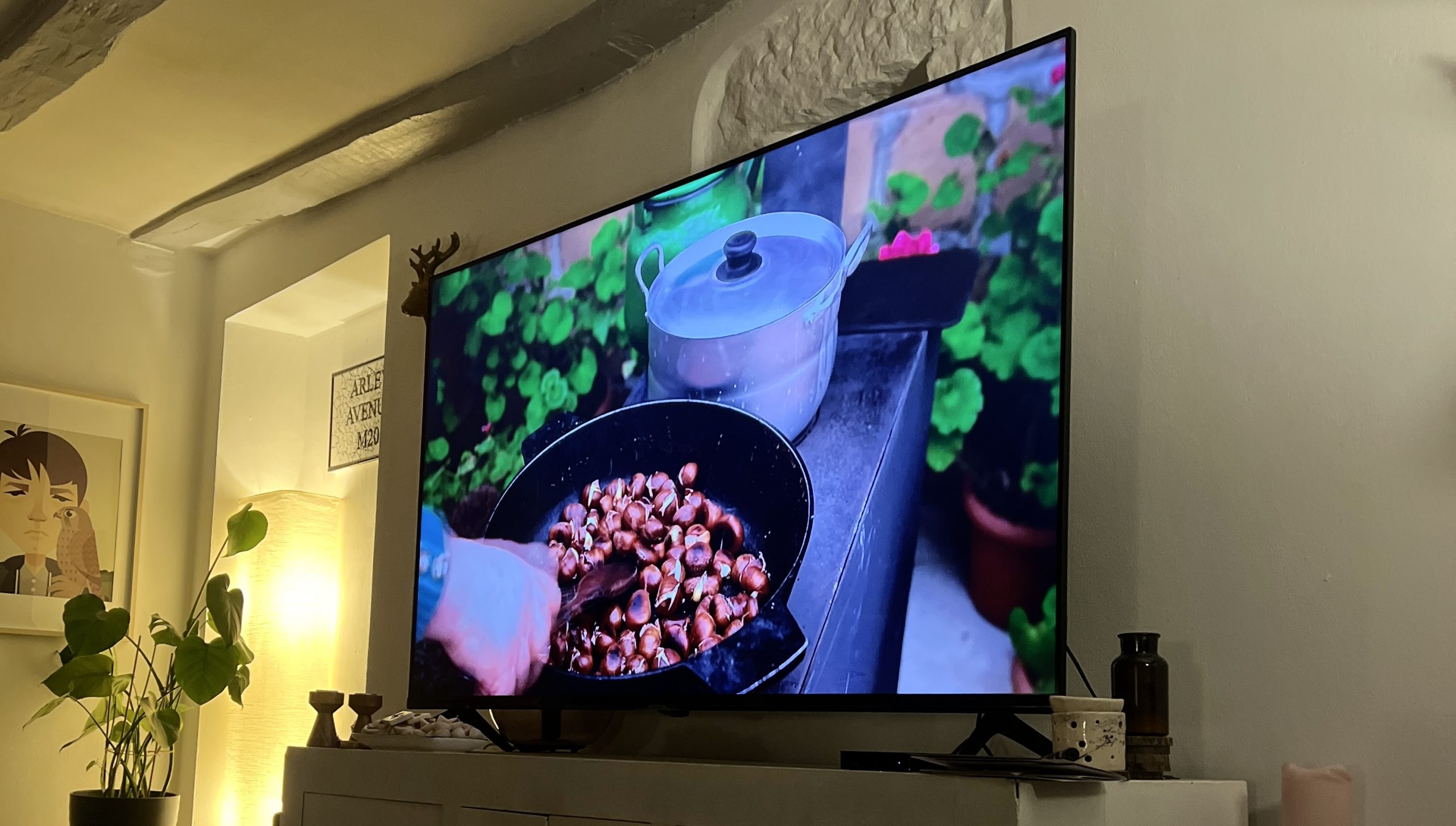
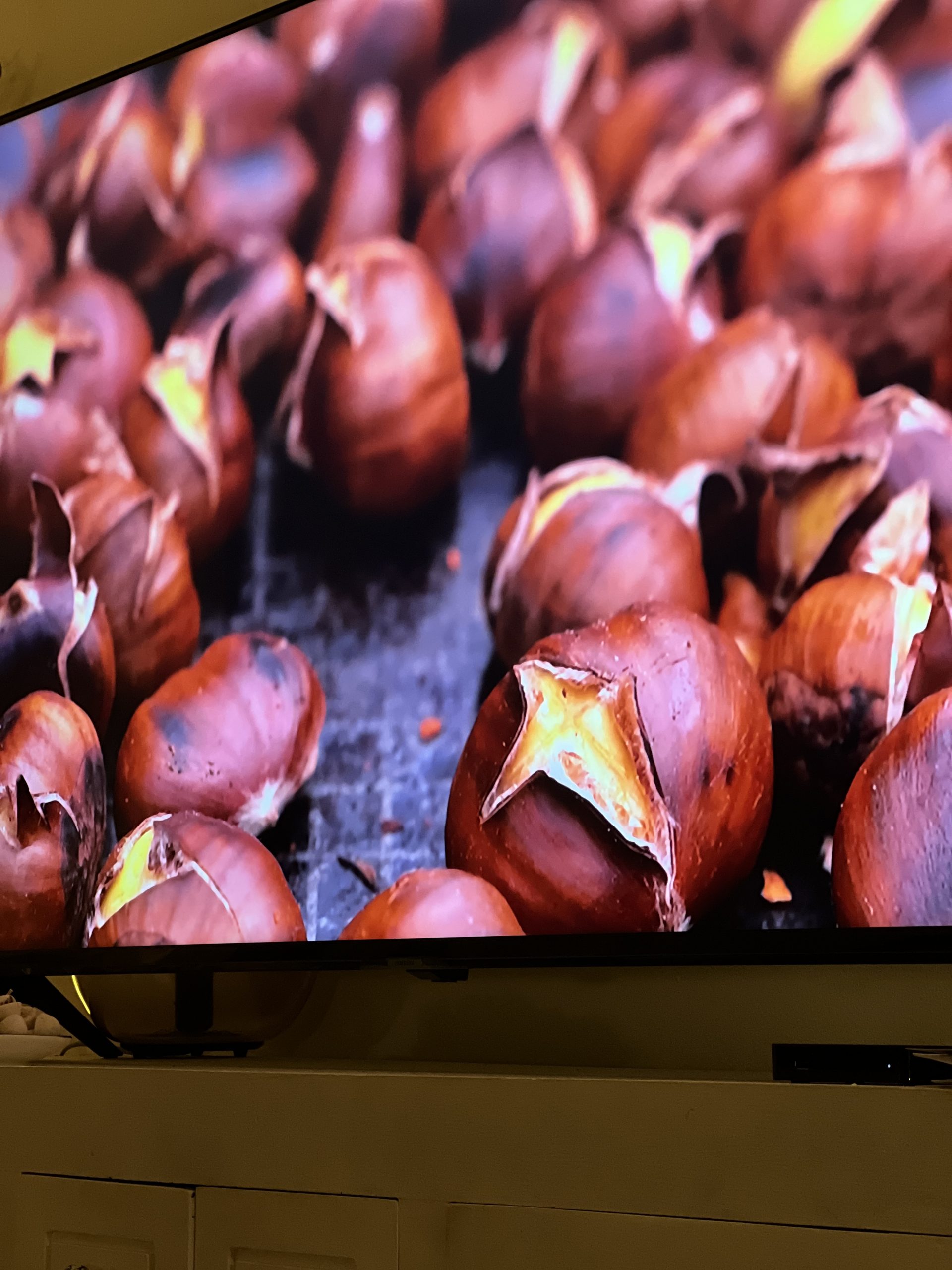


We love to spend a bit of time, every now and again, just absorbing an episode or two of this wonderful Vlog. I doubt we’ll ever recreate any of the recipes, and I certainly don’t hanker after their life-style or where they live, as beautiful as it seems. For us, it’s pure escapism and a chance to just be totally quiet and peaceful and see into a quiet window of this rural family’s farm life and see a glimpse of Azerbaijani traditions and rich cultural heritage.
In a world where everything is faced paced and noisy and full on, you want to keep watching because of the silence. A rare treat, these days…
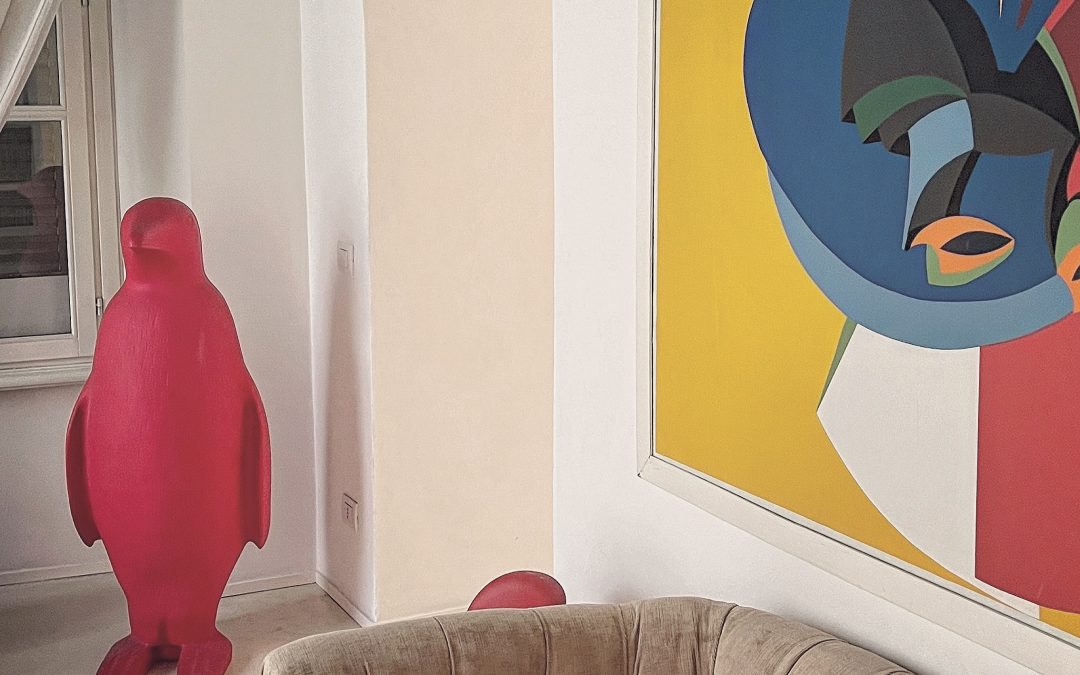
by Helen | Jan 9, 2024 | Italy, Travel
Whenever we stay in Bergamo, in Lombardy, we like to discover new places to stay. In December, we met up with friends from Manchester who had flown over, and so rather than a hotel room for two, or a small apartment, we needed an apartment for four adults, for four nights. There’s lots of choice in Citta Alta, the upper town where we were staying, but because it’s a medieval walled town, many converted apartments, although in large old buildings, are small. Most are beautiful, but most saying they could accommodate four adults, did so by having a shared bathroom and a sofa bed in the living room. We know our Manchester friends well enough to have gone for one of these, but we decided to just try and see what else we could find – and wow, did we stumble upon a stunner!
With quite a strange name – Casa M Charme e Relax – the apartment is located just off the main cobbled road in the old town, Via Bartolomeo Colleoni. An absolutely perfect location. We had a fairly good idea where the apartment is, and as a bonus, it also came with a parking space, at an additional cost of €20 per day. Quite pricey, but invaluable if you are staying in Alta, as most of the streets are accessible by residents only, so with a parking space, you get a permit too, to access the old town and not be liable for a hefty fine. But be warned – driving in Alta, even with a permit – is a hairy experience! Google Maps took us right through the centre, along cobbled streets which, in the past, we had assumed were pedestrianised, and up and down roads which were so narrow we had to pull the wing mirrors in. Suffice to say, when we arrived outside the apartment, we were mightily relieved!
We were definitely not expecting what we were greeted with. In any way. Once through the small metal door, the hallway opened up in front of us, with sweeping stone steps and expansive area outside the first floor apartment, with original frescoes, covering the walls. Astonishingly beautiful – and if back in the UK, probably behind the protection of glass. But these were just there. As they will always have been.
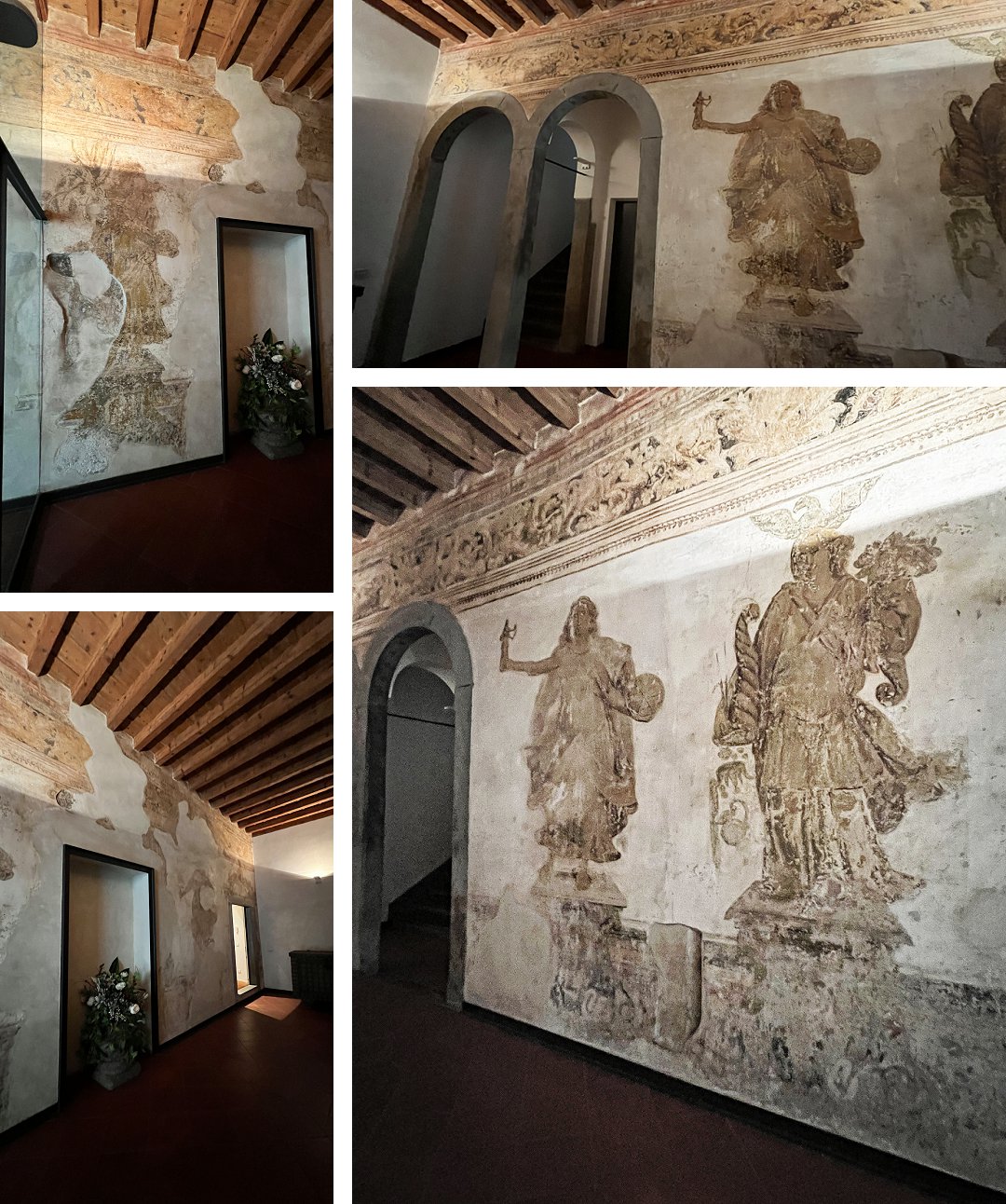
The door to the apartment (bottom left photo above) opened into a vestibule, with another fresco above the door, and freestanding sculptural works of art. A bit of a mini art gallery.
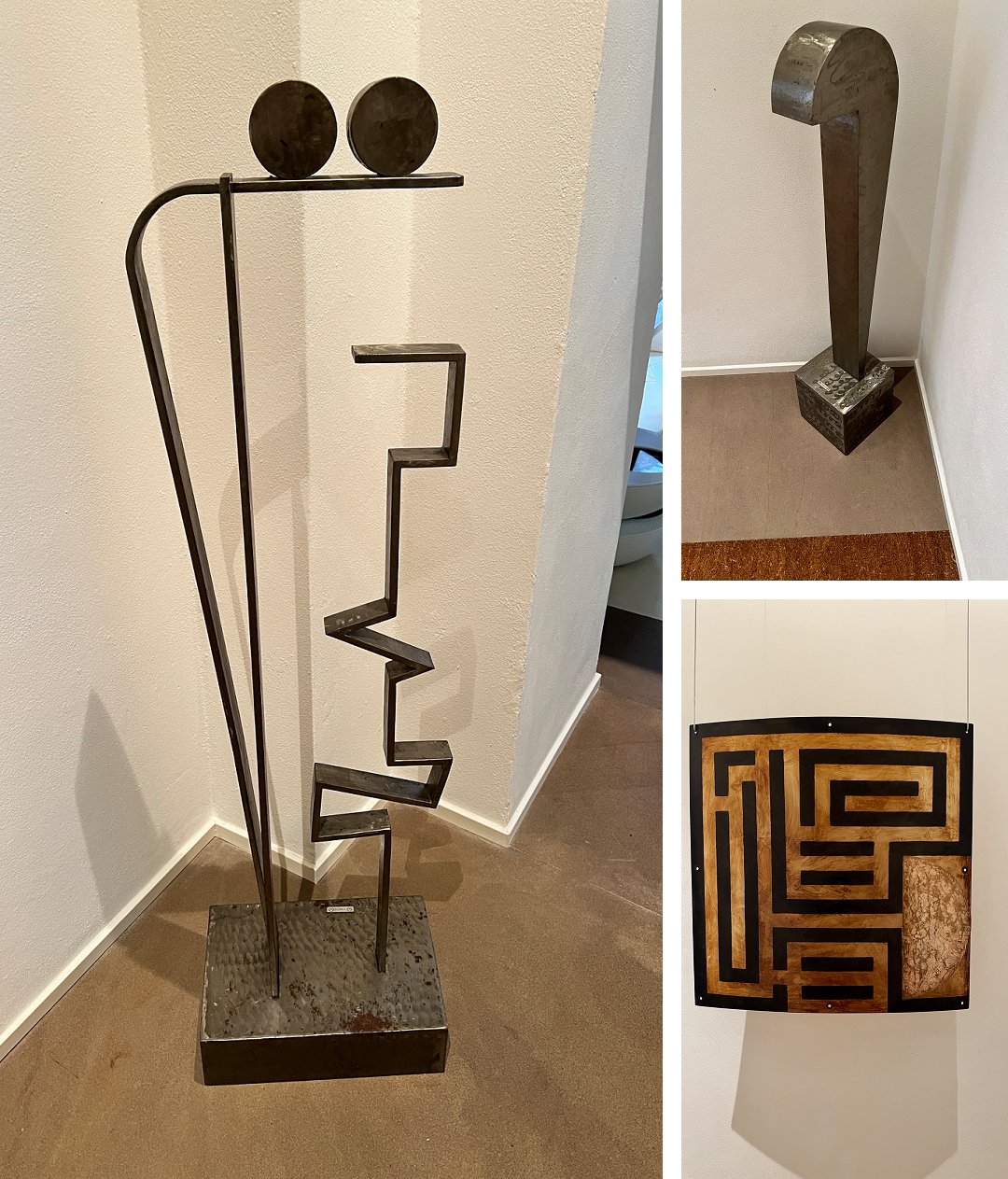
With a reception room, a large living room, a dining room, a kitchen, a laundry room, two bedrooms (one en-suite), a separate WC, a large landing room (with glass doors out onto a terrace) and internal circular stairs down into a second bathroom with a sunken bath/shower, it is an AMAZING space. It is clearly an apartment which is also used by the family, as there are many personal effects, including photographs, books and children’s toys. Normally, I find this very off-putting if we are staying somewhere, but this apartment is just so expansive, it gets away with it. You almost feel as if you are staying in the home of someone you know because everything is so tasteful and absolutely everything is available to make your stay as comfortable – and presumably homely – as possible. The owners have exquisite taste – the furniture is exceptionally high quality and it seems as if no expense has been spared. And, I don’t think it has been, especially as I googled this little guy, as I fancied a white one for our garden. Let’s just say, I won’t be getting one any time soon…
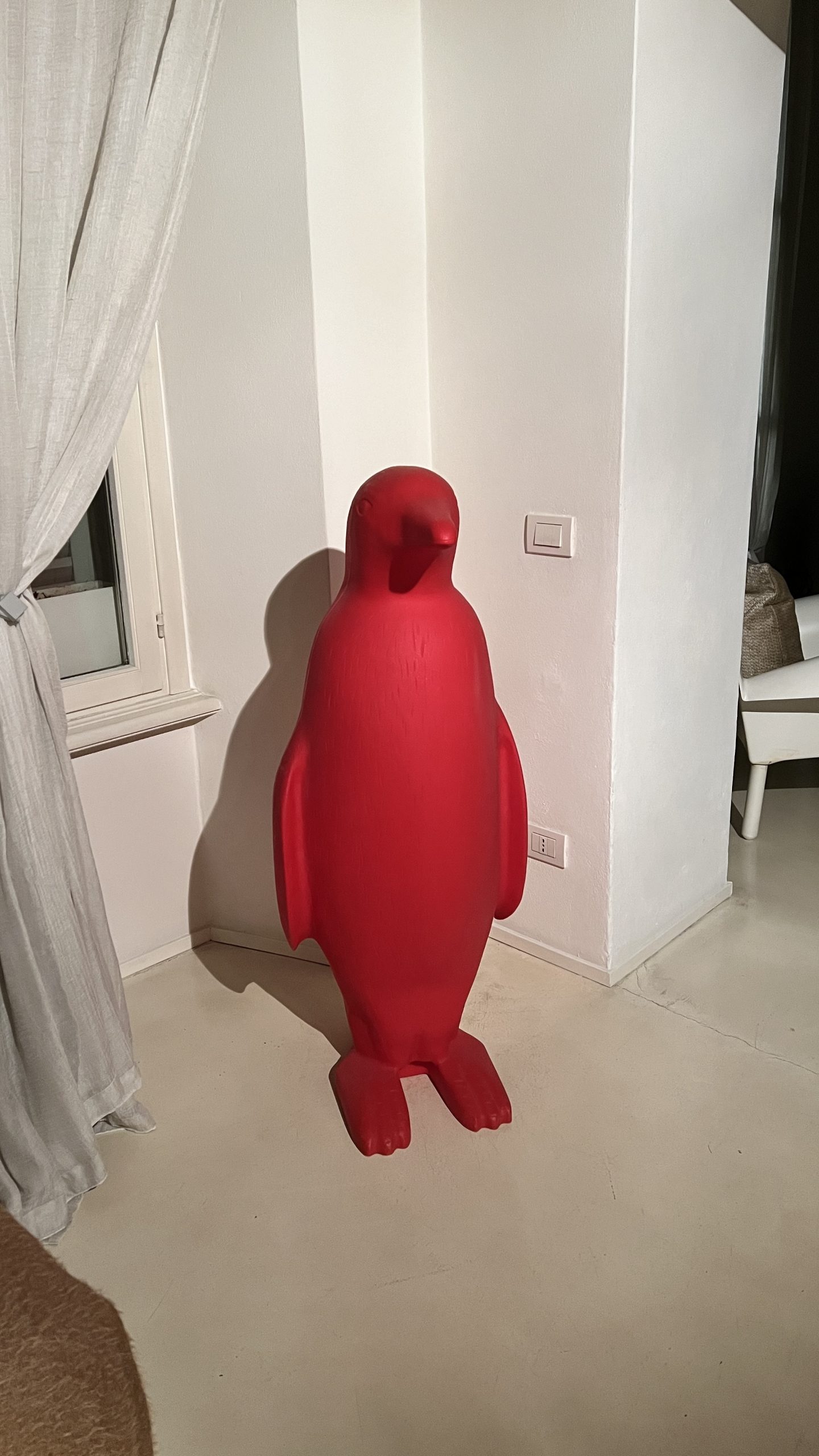
As an extra special touch, because it was December, we also had a beautifully decorated Christmas tree in the reception room. Just another one of those touches which really added to our stay.
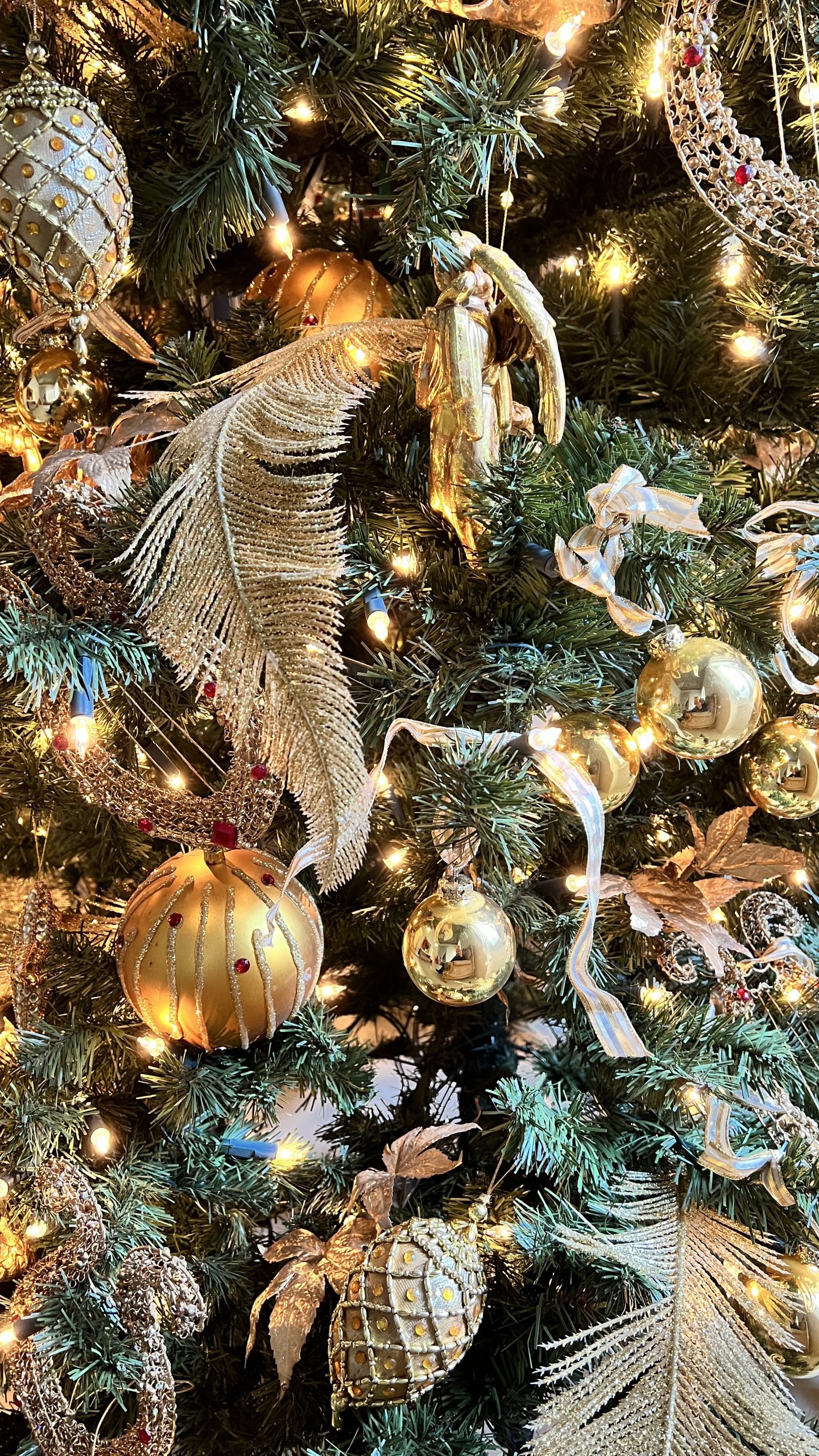
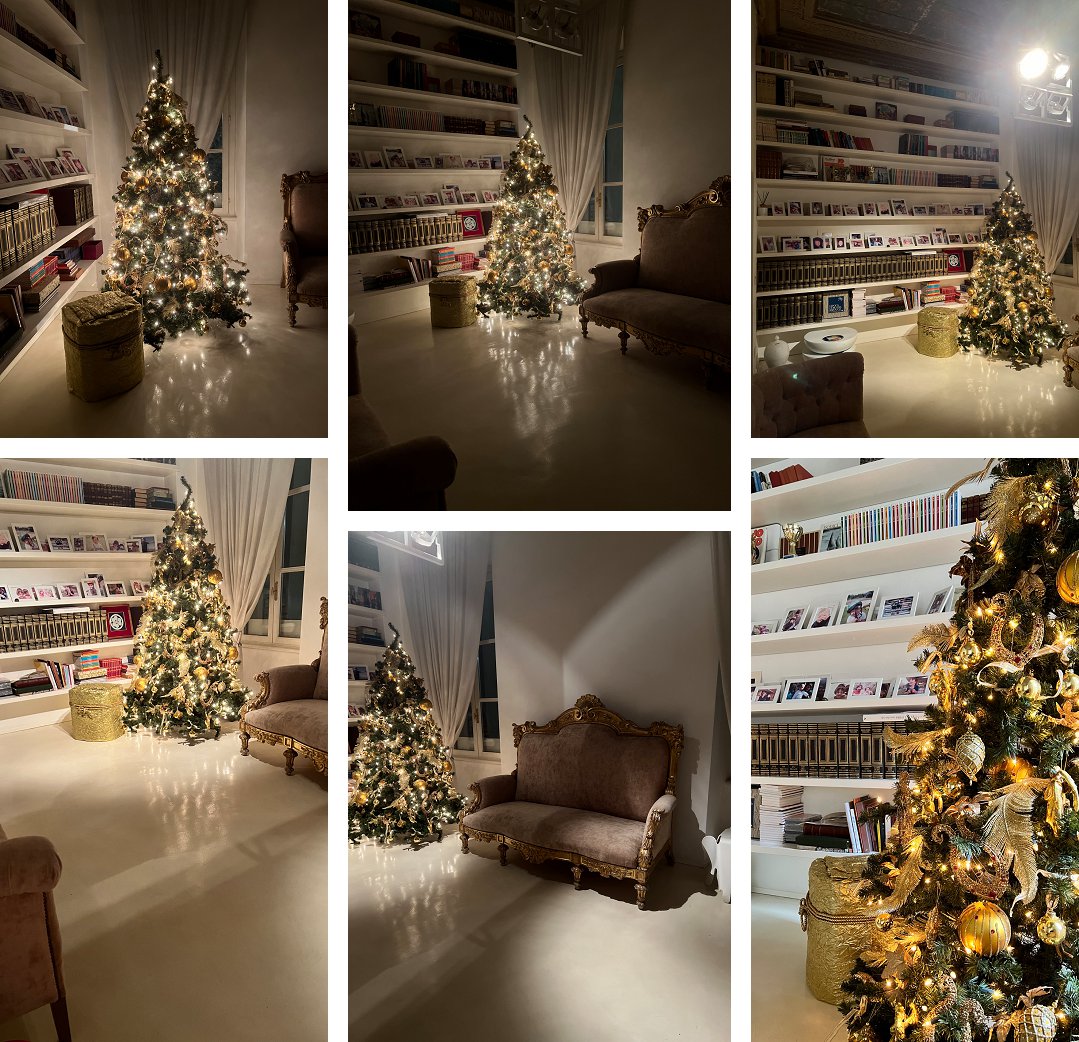
The main living room was very large, with a huge L-shaped sofa and two big white plastic armchairs – this makes them sound horrible, but my word they were comfortable and perfect for making you sit properly. The room also benefited from massive windows, covered with drapes to the floor, a very impressive original fireplace, cool, funky lighting and original artwork. The floors are also under heated, so we were warm and cosy without having hot and cold spots – the whole apartment remained at a constant, comfortable temperature throughout our stay.
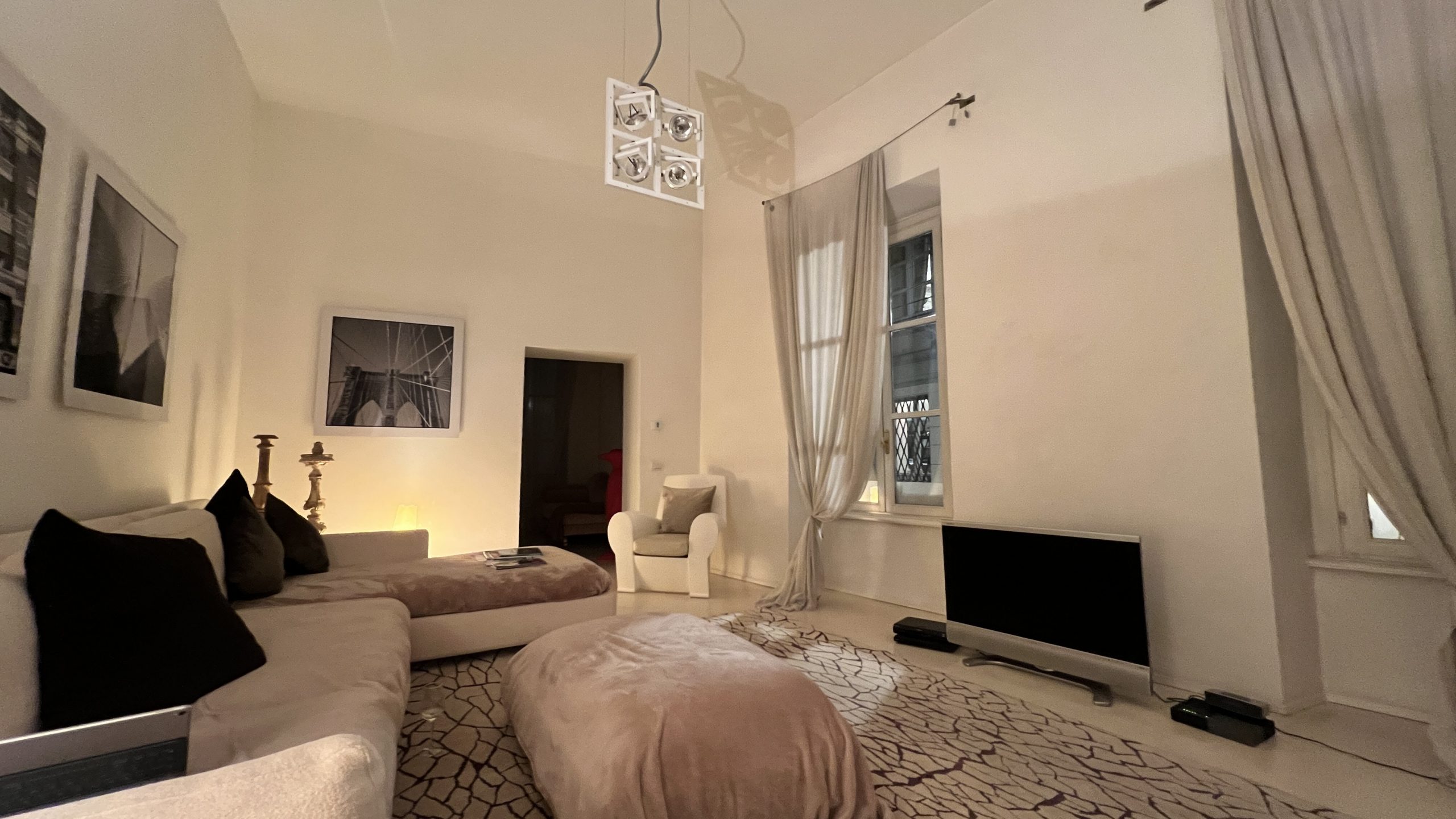
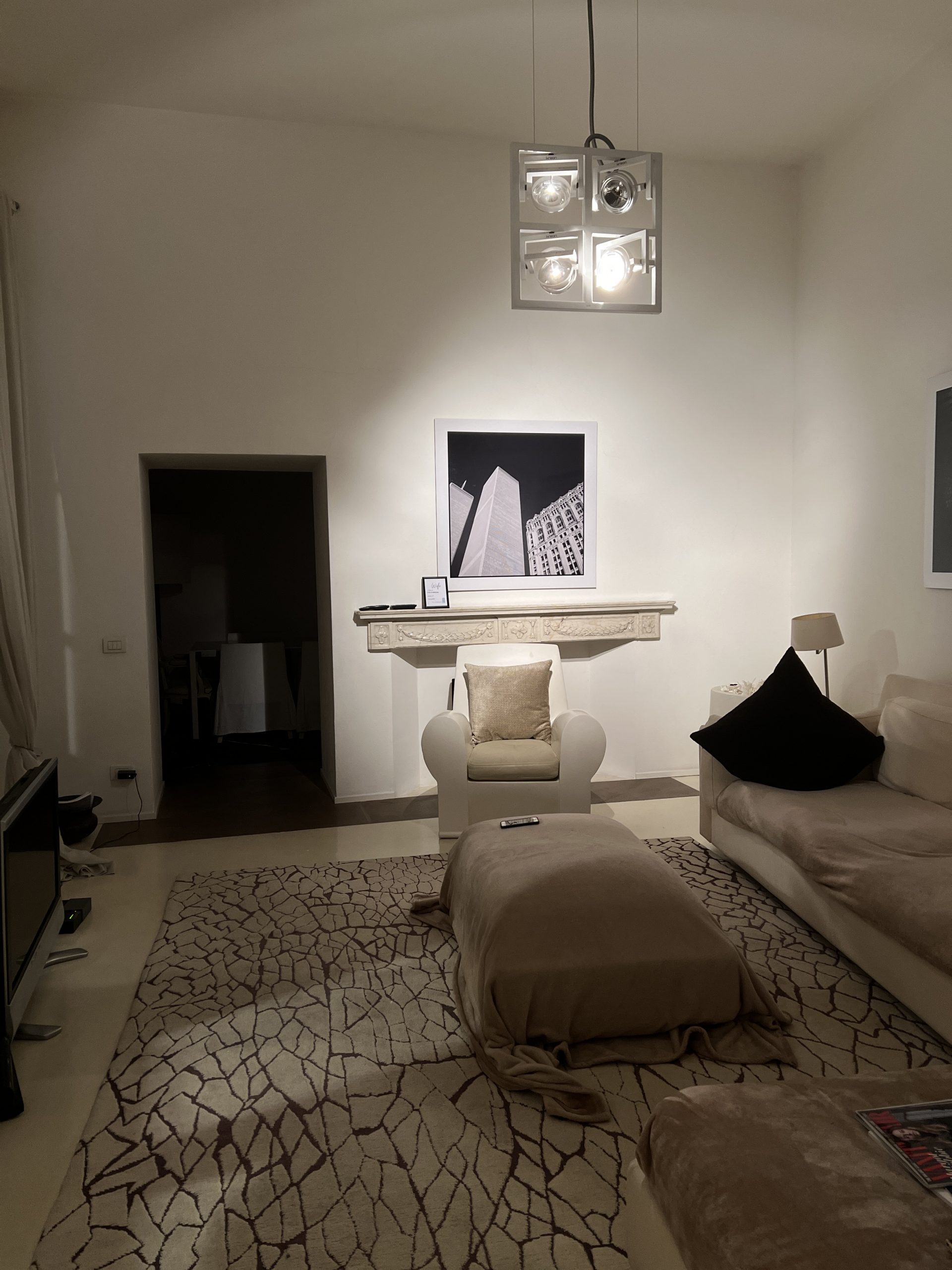
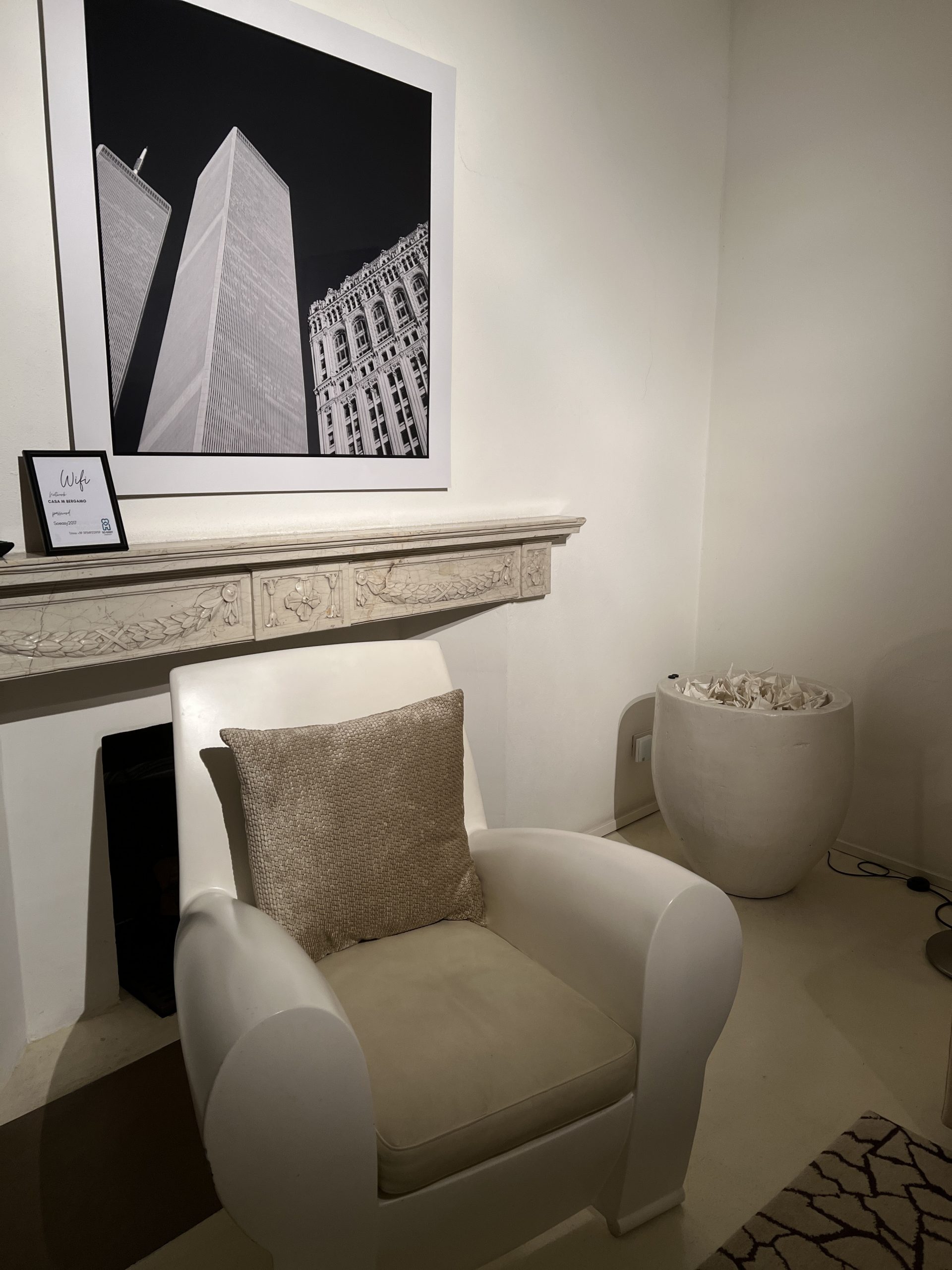
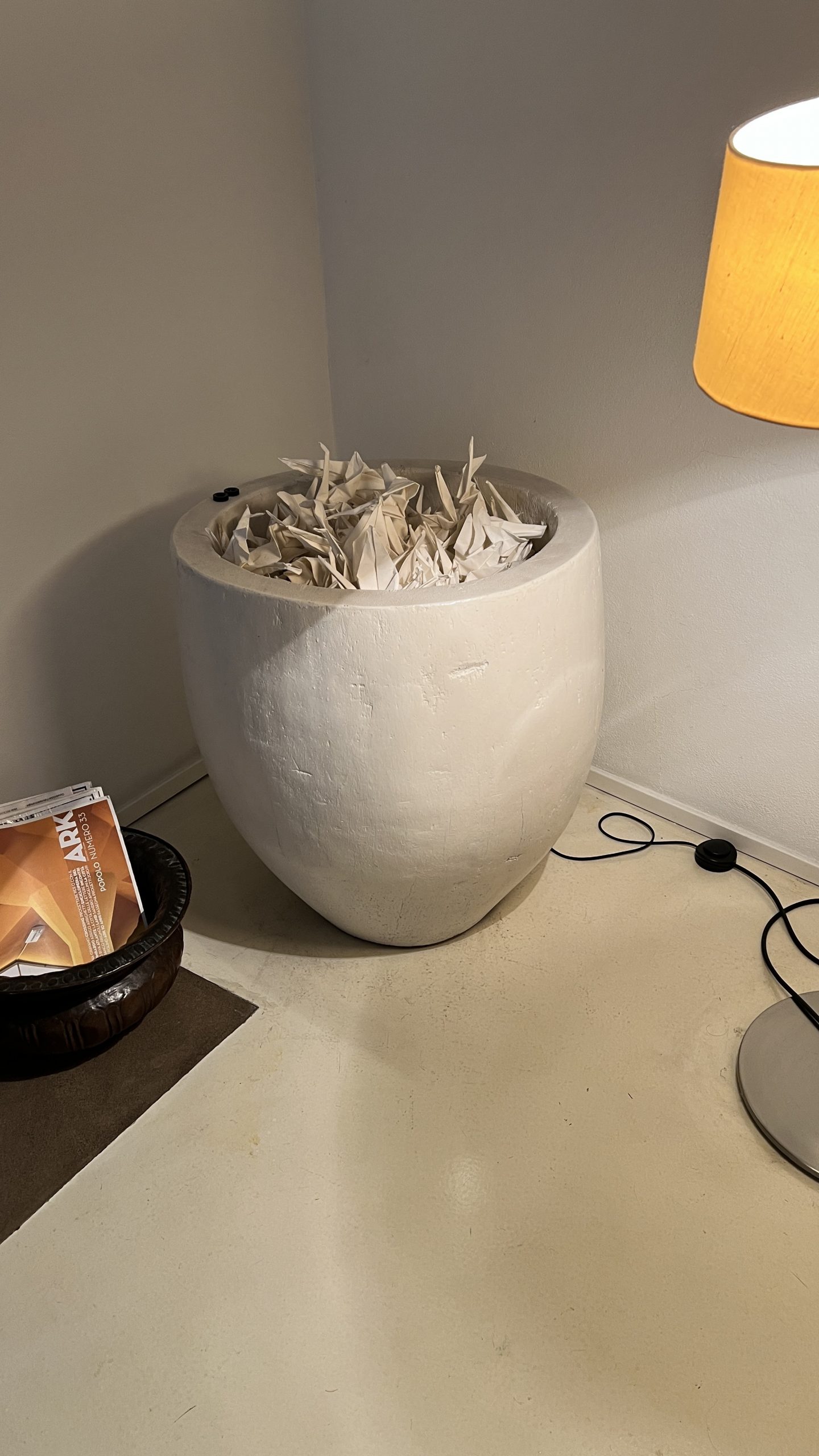
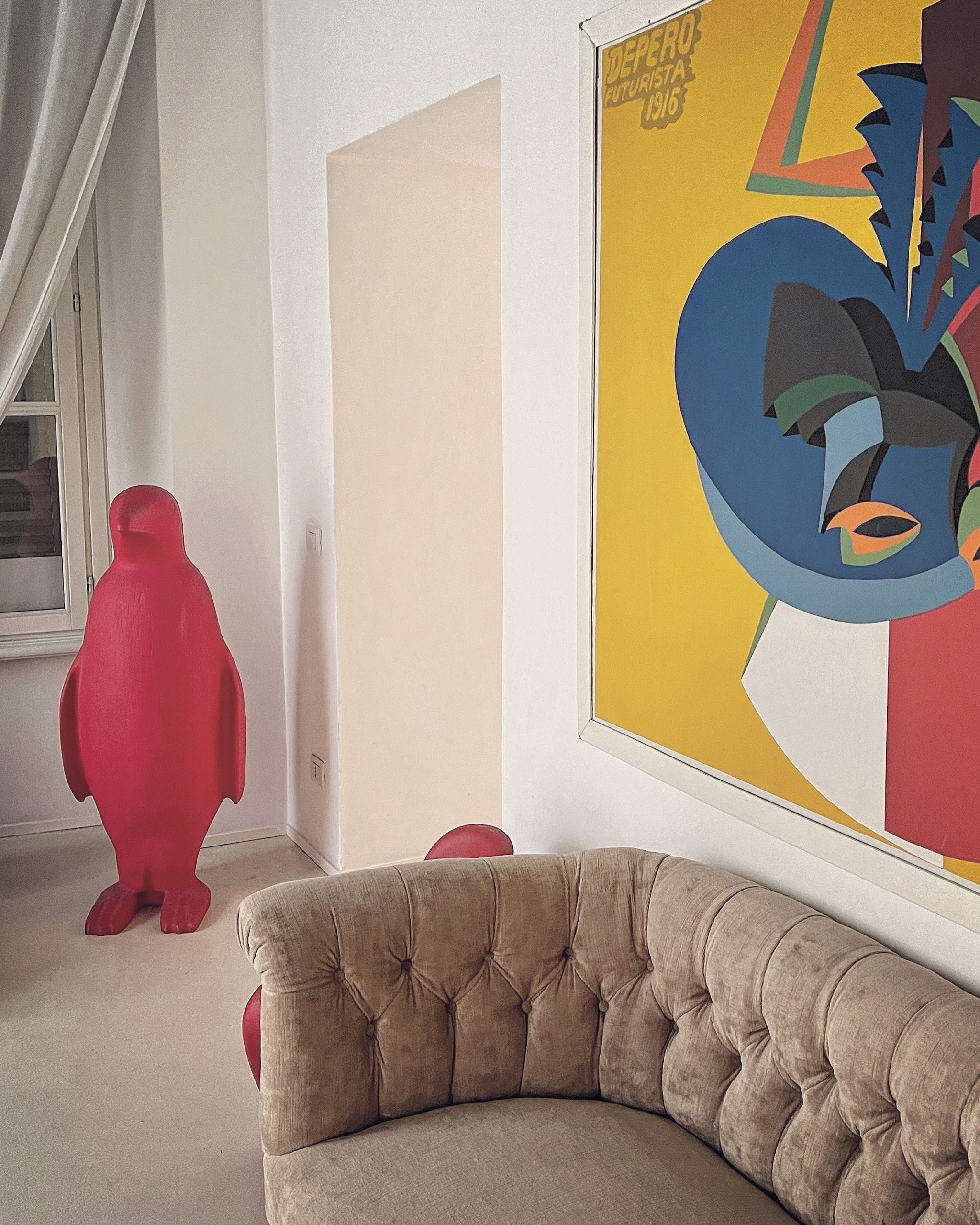
Our bedroom had an ensuite with a bath and a walk in storage unit. It was a large room, furnished in a minimalistic style, with a splash of red from the floor length curtains. (And the painting of Jesus, which I loved as it was obviously there as an ironic piece of art, rather than I think, an expression of religion)…
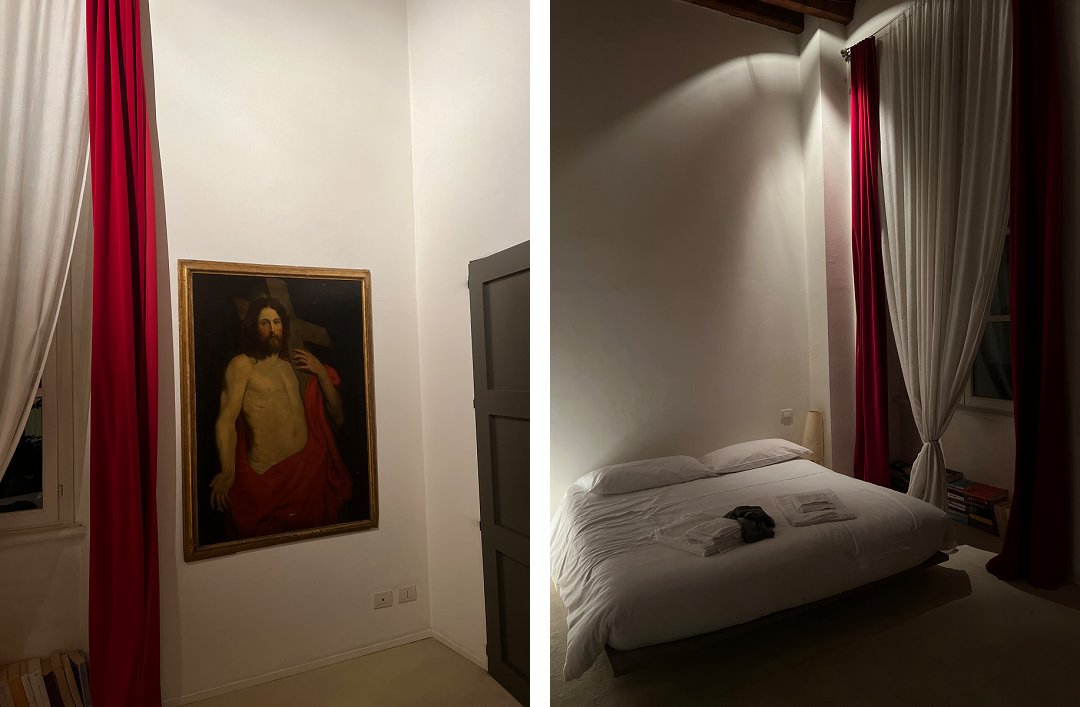
The other double bedroom is something of an enigma. It’s got twin beds and is obviously a room used by children, as evidenced by the artwork and the toys on shelves. It doesn’t have an en-suite, but it does have a big surprise. (There is a small toilet room next door so if you get caught short in the middle of the night, you’ll be OK). From this bedroom, stairs lead down onto a large landing space – definitely big enough to be classed as a small room – and from here, there are French doors leading out onto a small terrace/garden. Being December it obviously wasn’t looking its best, but I would imagine it would be very pretty when everything is in bloom. Then, leading off from this space is an internal spiral staircase, which takes you down into the second bathroom, with a large shower which can presumably also double as a bath…
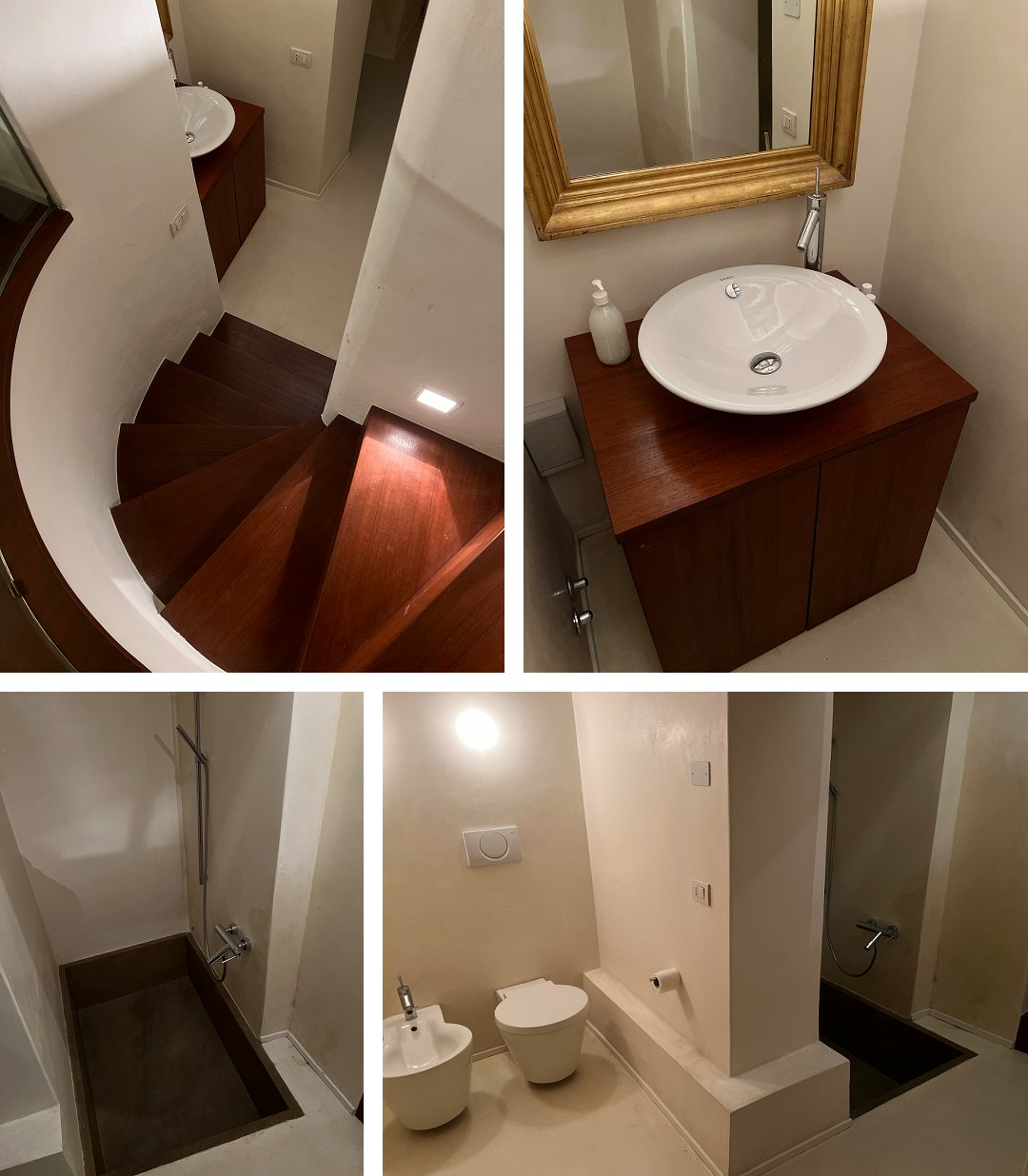
The kitchen is large and well equipped, with a walk-in pantry and a separate small room which houses a washing machine and dryer. A full size dish washer is also available. The dining room has a table that would comfortably sit eight people. With large windows in every room, original wooden, panelled ceilings and frescoes in the kitchen, this is one unique apartment, in the heart of Bergamo Citta Alta.
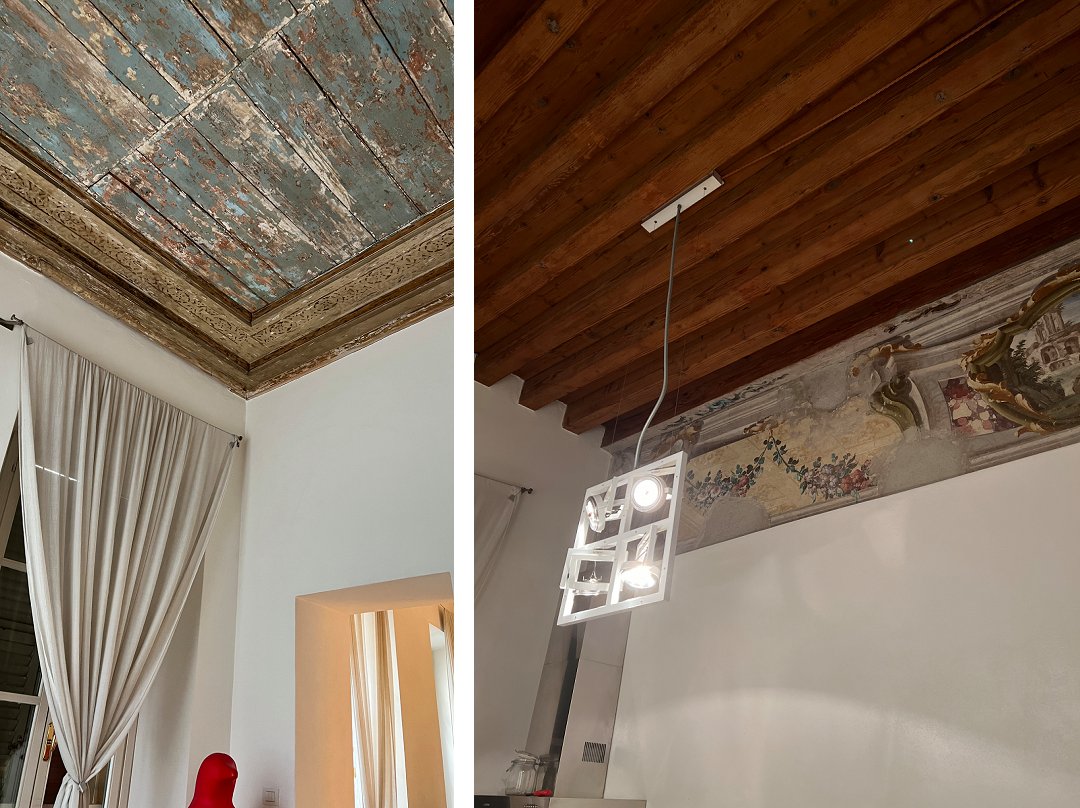
There were a few minor things which we noticed, which could probably be so easily put right by the owners – but which did not in any way spoil our stay. Our bed (the double) was very low and quite hard. A mattress topper, I think, would make all the difference here. Something to be aware of, is the plug/socket situation for device charging. Even though we have EU chargers and our friends had adaptors, we found that only certain sockets would charge and so we had to share the sockets which would work for us. Also, because of the thickness of the walls – and we have exactly the same issue in our home – even though the wi-fi was good in certain areas, it was pretty non-existent in some, certainly in the double room. Again, absolutely not an issue for us, as we had come away to be with friends, not plugged into phones, but just something to factor in.
One other thinking to really, really be aware of, especially if you have a large car (we have a Honda CRV), is that the secured parking space, behind gate, is a squeeze. My old Smart car would have coped, no bother, but we did struggle reversing in. Again, brilliant to have somewhere to park in Citta Alta, but good to know you will definitely need your driving/parking wits about you – and if your car is bigger than a Honda CRV, you will definitely struggle. You may get the car in, but then you may not be able to get out of it!
good to know
- the apartment is fully self catering, but a small breakfast is provided
- there is a small Conad supermarket about 100 metres from the flat, with everything you could possibly need for your stay
- it’s close to all Citta Alta sights – Piazza Vecchia, the Duomo, the Cathedral, the Baptistry, the theatre, the campanile (which tolls 100 times every night at 10pm – just so you know!), the funicular down to Citta Bassa and the second funicular which takes you to the highest part of Bergamo, San Virgilio
- all restaurants are within a short walking distance of the apartment
- although there are stairs in the entrance hall, and no lift access, the stairs are wide and shallow, so even with limited mobility, the apartment is accessible
- if you don’t have pre-arranged parking, don’t try and enter Alta in the car – restrictions are in place, and if your licence plate is not registered to the address you are staying, which offers parking, you will risk a hefty fine. There are plenty of car parks in Citta Bassa, so I’d advise park down town, if you don’t have reserved parking in Alta and either take the funicular up, or a taxi
We booked the apartment via booking.com and paid the going rate for four people at the beginning of December.
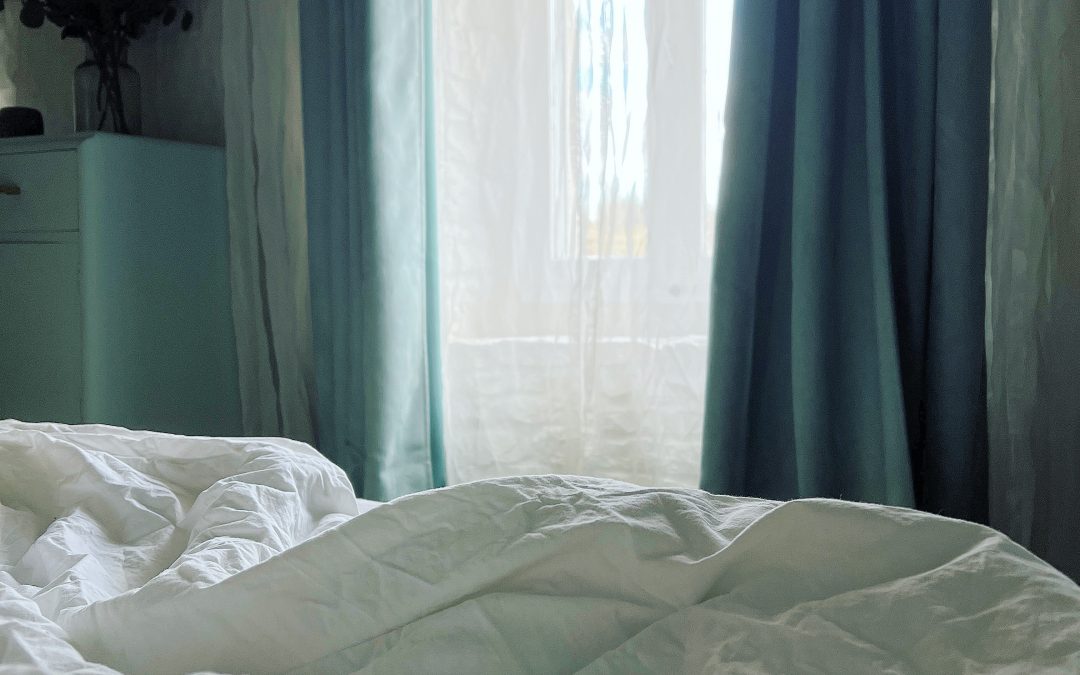
by Helen | Jan 7, 2024 | Interiors
Our bedroom is by far the largest room in the house, and could definitely accommodate an en-suite. We’ve thought about this addition so many times, but it’s always seemed a bit of a luxury, when so many other more pressing projects have demanded attention. We also have two bathrooms, so an en-suite really is the kind of thing that we might tackle if we are still here and if we fancy doing it. So, we’ve not actually done much with the big bedroom, compared to the rest of the house – but that doesn’t mean we’ve let it slip.
It’s now completely renovated. The half painted walls have now been painted white, including the internal bare stone wall, around the two windows. One feature wall has been painted a very soft grey to complement the white. The apex ceiling has been painted white. All of the woodwork is now white, apart from the beams, which have been treated and caulked (in places they needed a lot of TLC) and painted the same soft grey as the feature wall. The floor has also been transformed – it was once pale pine, but is now white. All very scandi and much more us. Bedroom furniture was purchased quite quickly when we moved here, as we’d sold our original bedroom furniture with our house back in Manchester. If we had the time again, we’d choose very different bedroom furniture, but we’re OK with it now, as we’ve chalk painted it all a very, very soft duck egg blue – exactly the same colour as the floor length velvet curtains. It’s a gorgeous room in the summer, with the two windows wide open (but with insect blinds down) and the morning sunshine bathing it in golden light.
Winter mornings are different – but the room is as beautiful. Firstly, the windows are firmly shut. It’s chilly here in Istria, in the winter, so we like to warm and toasty. And this means that the summer bedding is stored away and the winter duvets come out. We want this room to be calm and relaxing so all of the bedding is white, with plenty of throws to add warmth if necessary, in colours that complement. We don’t have carpets, as we like the expansive white wooden floor, but at each side of the bed, we have lovely, thick furry runner rugs – good for our feet, first thing in the morning. But the best thing about this room, in the winter, is the bed. Our gorgeous Eve mattress is still with us and the splash of yellow around her sides, is a lovely contrast to the whites and duck egg blues. A big, thick IKEA mattress topper adds a touch more comfort and soft, white, crinkled, cotton duvet covers and pillow cases, ensure the top level of comfort. We’ve dispensed with coloured/patterned bedding as we’ve finally realised white can’t be beaten.
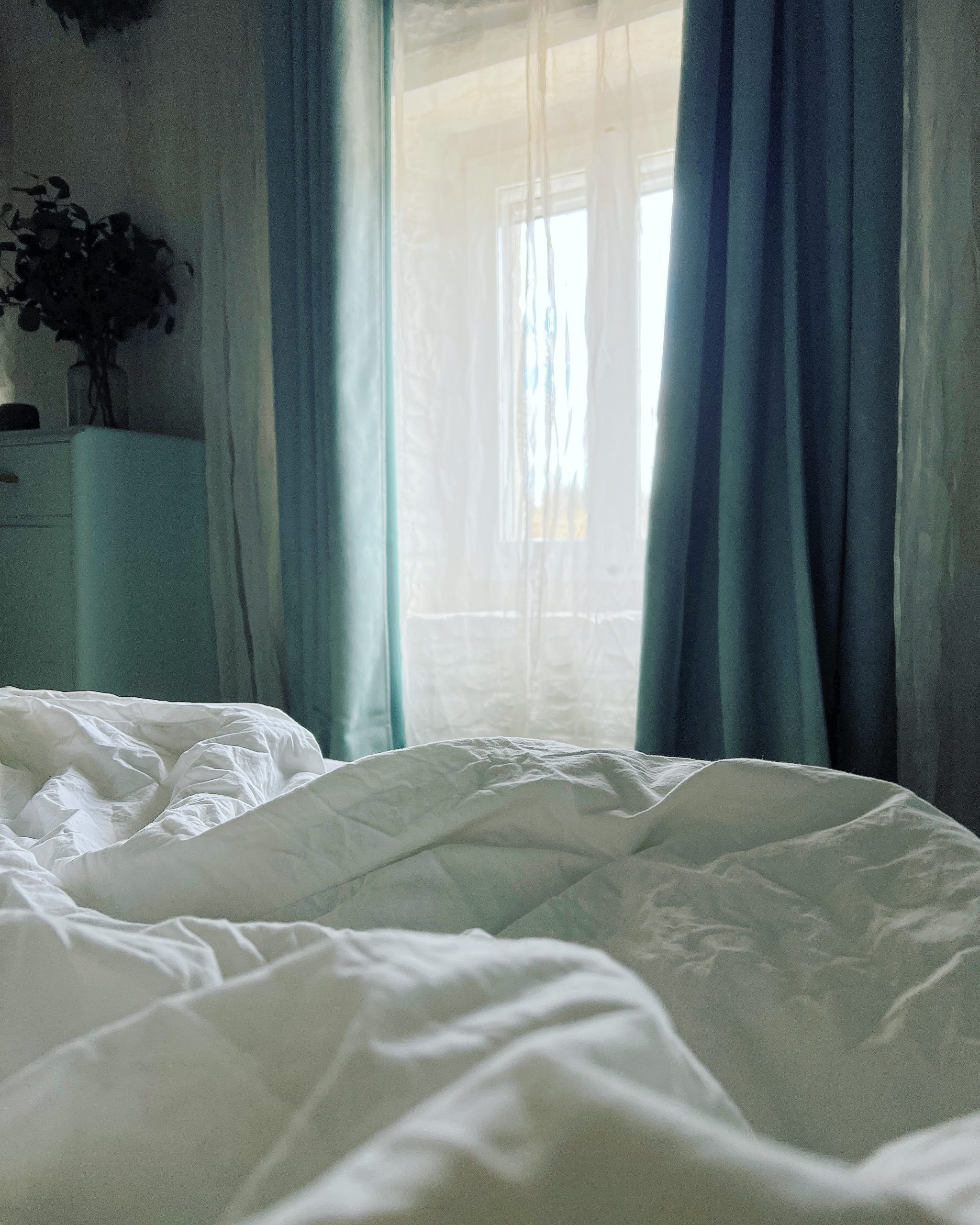
This is definitely a very. very difficult bed to get out of, especially on winter mornings…
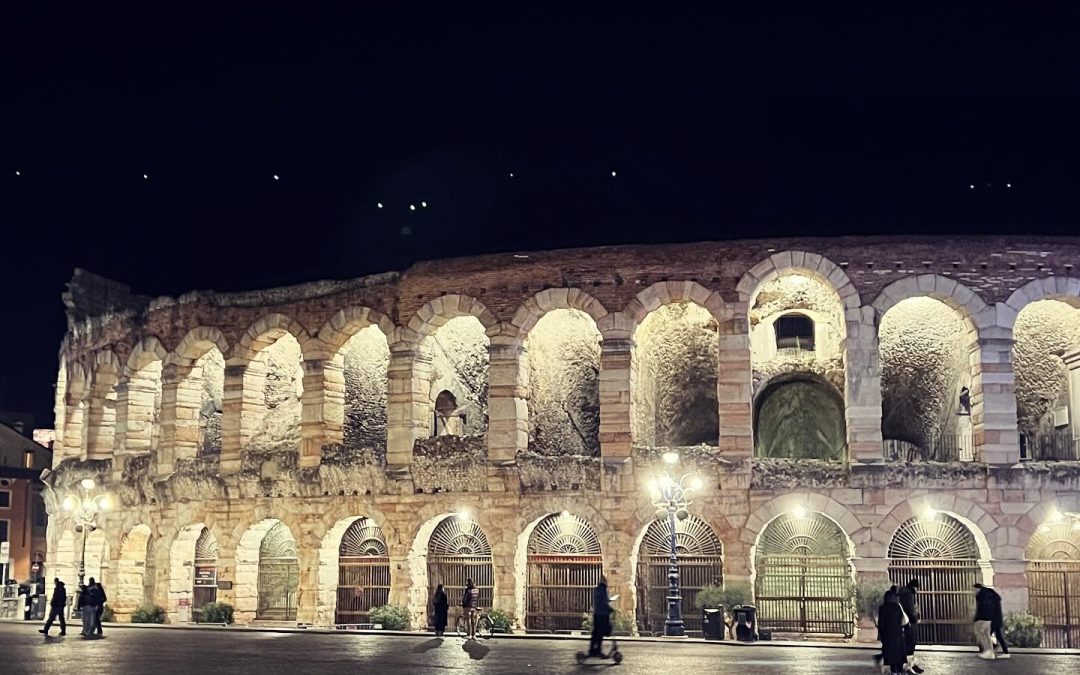
by Helen | Jan 6, 2024 | Italy, Travel
Because of where we now live – northern Istria, near the Slovenian and Italian borders – we get to travel a lot more than we ever used to. We rarely fly now, as our location means many places, especially in Italy, are so much more accessible and so we are very lucky that we can now visit places for an overnight stay, whereas previously, we’d have had to have flown and spent at least a few days there. Not a bad dilemma, to be fair, but we still pinch ourselves that now we can do quick visits to places such as Trieste and Udine and Venice and Bergamo. And as we did, just before Christmas this year, to Verona.
We have visited Verona a few times before and have loved the city. Even the Balcony had me entranced – ex-English teacher and all, so I have an excuse! We’ve been lucky enough to have a visit to the Arena – although not to see an opera, we did see it being set up for Nabucco, and spent a good couple of hours exploring the inside of this magnificent ampitheatre. We’ve spent leisurely afternoons in Piazza Erbe, drinking in the gorgeous buildings which form the outer edges of this rectangular piazza, with their stunning frescoes. We’ve discovered beautiful little restaurants, one in particular by the river, under ancient stone arches, decorated with tiny twinkling lights. Unfortunately, I just cannot remember its name, but I do recall that the menu was all in Italian and chalked up on a board – we decided to just choose without thinking too much, and ended up with one of the memorable meals we’ve had in Italy. The setting may have had something to do with it, as the dishes were just pasta. Although *just* probably doesn’t do justice to how good they were. Anyway, we know parts of Verona quite well, and we’ve stayed in some great places, so we decided to have night stop-over here, when we were driving to Bergamo this Christmas, to collect family from the airport. (We can get to Bergamo in under four hours on the motorway, but this was the Friday before Christmas, and so we knew it’d be really busy and that by the time we got near Verona, we’d be wanting a break. We were right. The motorway was mayhem!)
Hotel Verona is one hotel we’ve stayed at a couple of times before. It is very easy to get to from the motorway – once you exit, it’s literally a straight drive into Verona and onto Corso Porto Nuova, where the hotel is located. This road is a wide thoroughfare, with bars and cafes and restaurants and hotels, plus grand apartments above street level, and at the end of it, is the beautiful Portoni della Bra, two stone archways, erected in 1480 on the site of a gateway that made up part of the city walls, leading you into the beautiful Piazza Bra and the Amphitheatre. A pretty spectacular location for Hotel Verona, which is less than a 10 minute stroll from the Arena. The hotel itself is very modern, with a glass frontage and has had a lovely refurb since our last visit. Rooms are minimalist and super clean with big, comfy beds and excellent showers. What you need after a few hours on a mad motorway. There’s also secure parking, which for us, is a massive bonus.
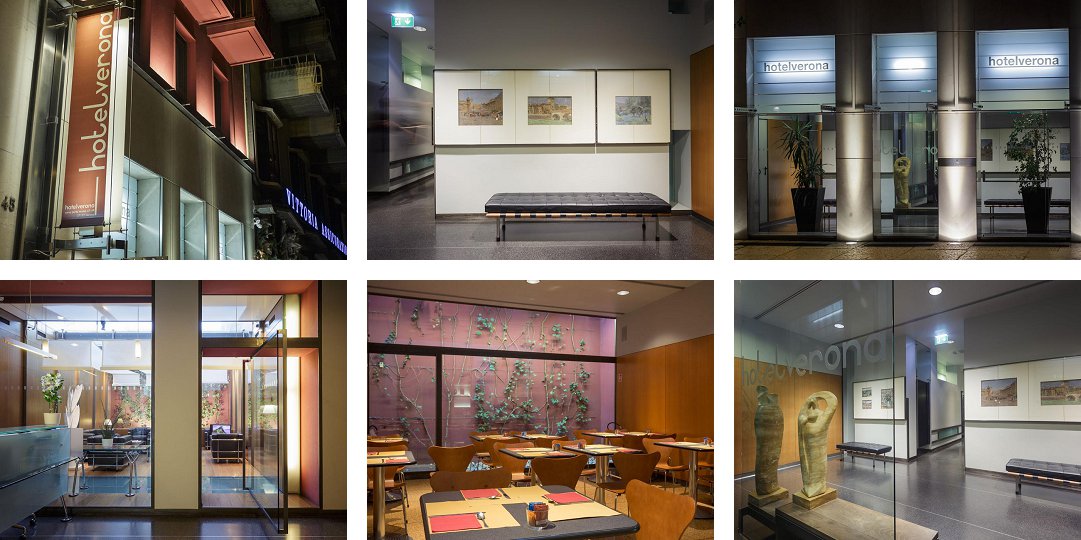
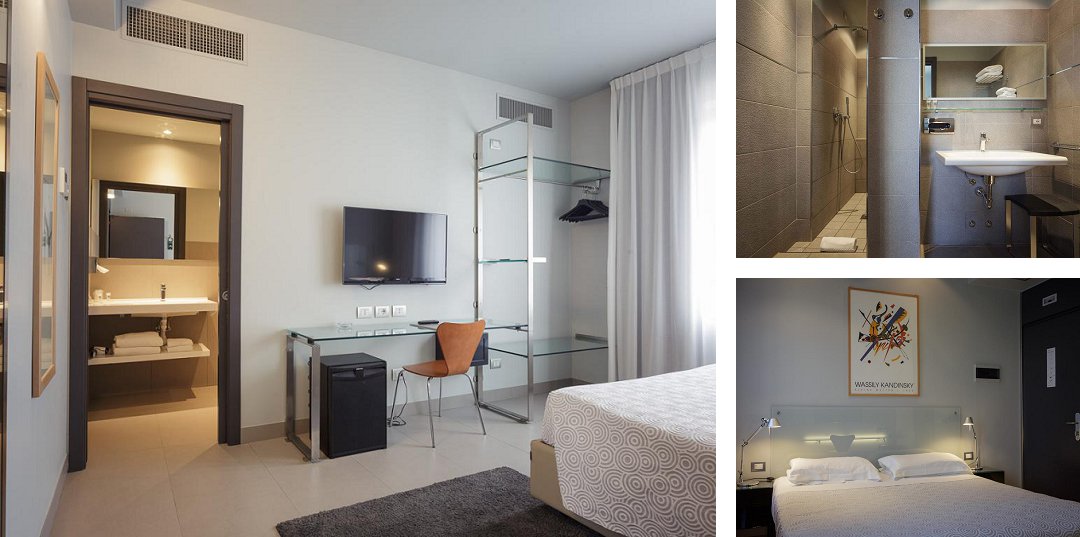
Because our stay this time was short we knew exactly what we wanted to do and where we wanted to go. Restaurant L’Orologio is just outside the double arches of Portoni della Bra and we’d had an excellent meal there on a previous visit, so decided that we’d go again. And, it didn’t disappoint. Full of Veronese, it’s a really authentic restaurant, with a fabulous menu. I did think that I would go for the beautiful risotto which I’d had previously, but a spicy prawn pasta dish caught my eye. Our selection of cheeses, with oil and honey, as a starter were exceptional, as were the desserts. Real old school apple crumble and ice cream and tiramisu. All as fabulous as we’d remembered.
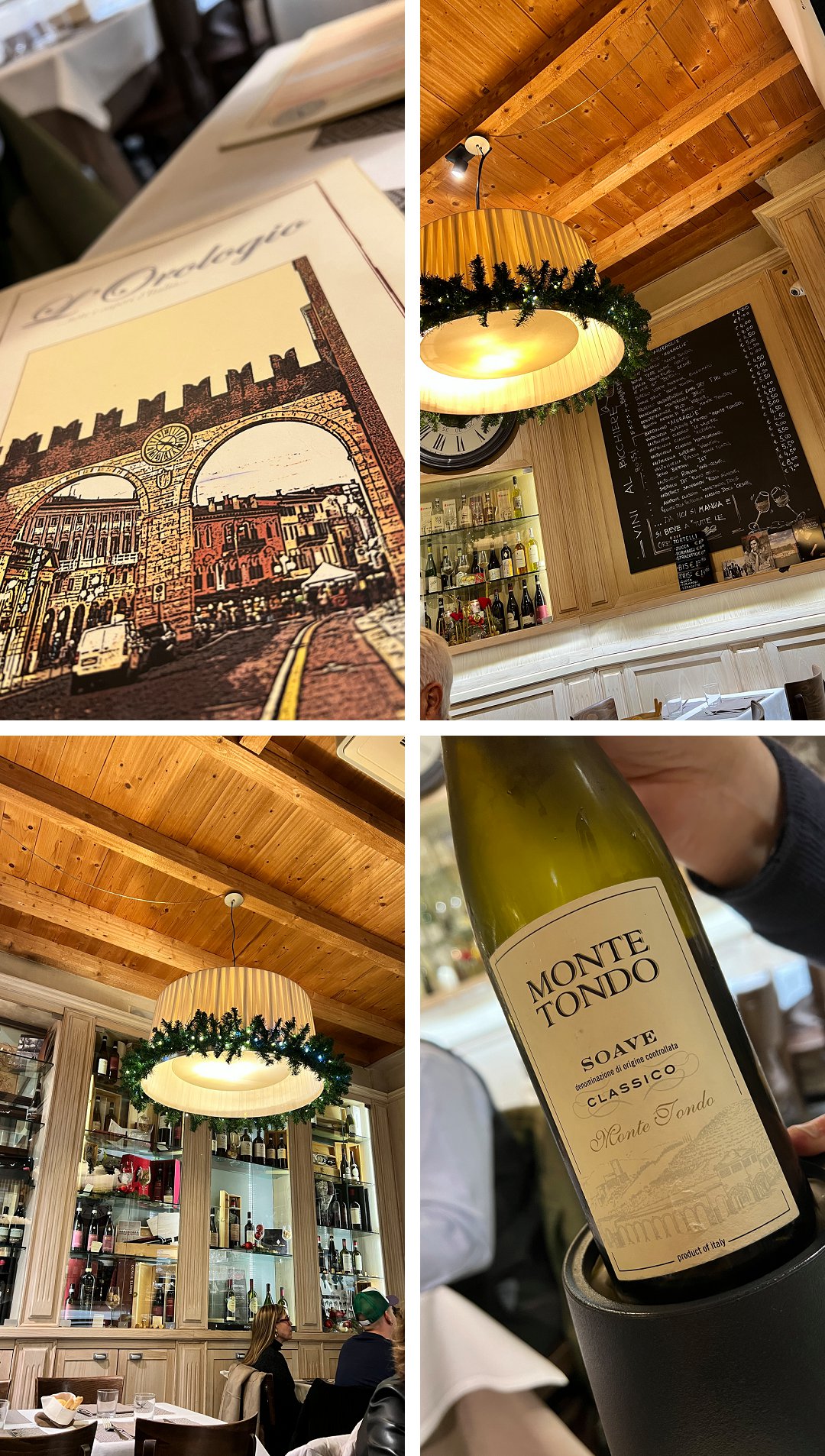
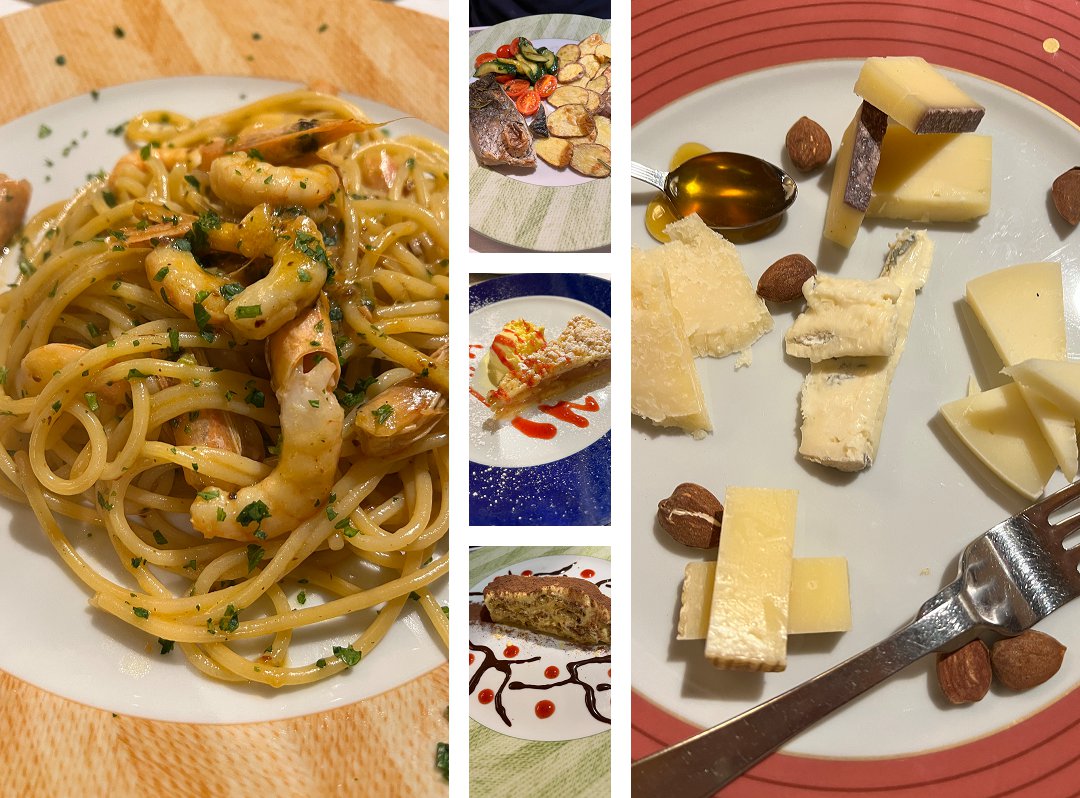
Being so close to Piazza Bra, we couldn’t resist a stroll down Corso Porta Nuova and through the arches. Illuminated against the starry night sky, this entrance into Verona’s centro storico was as impressive as ever.
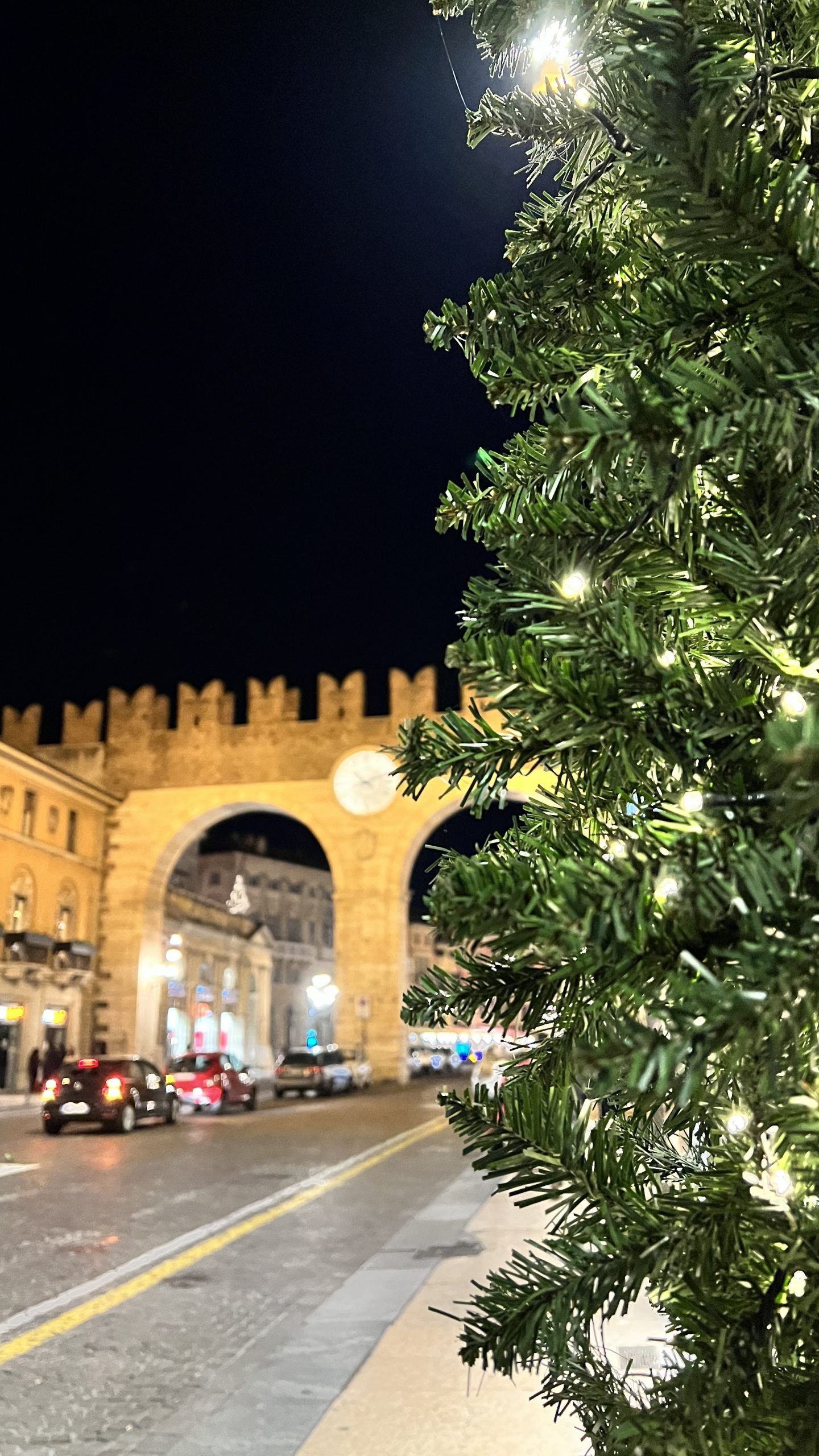
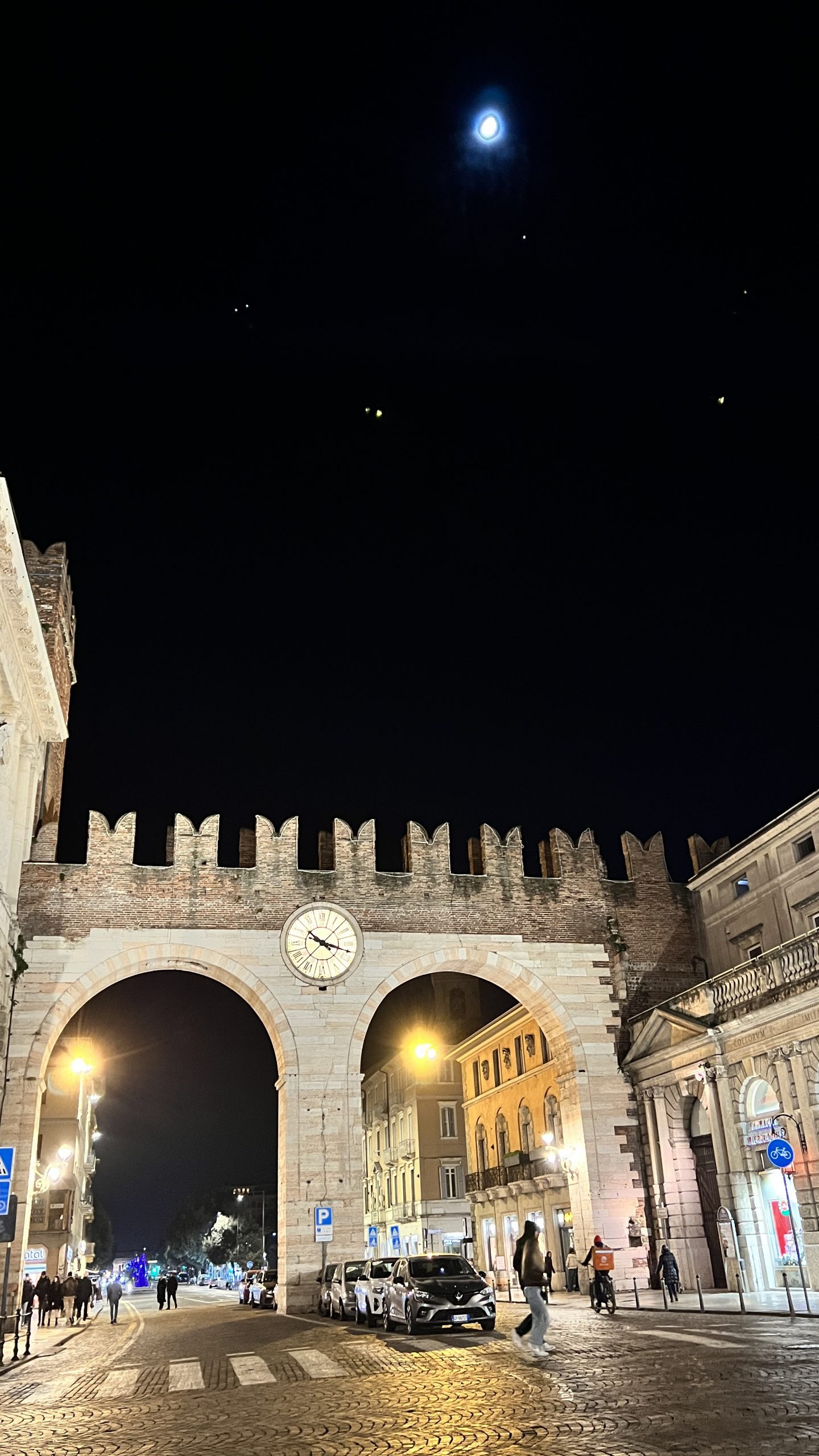
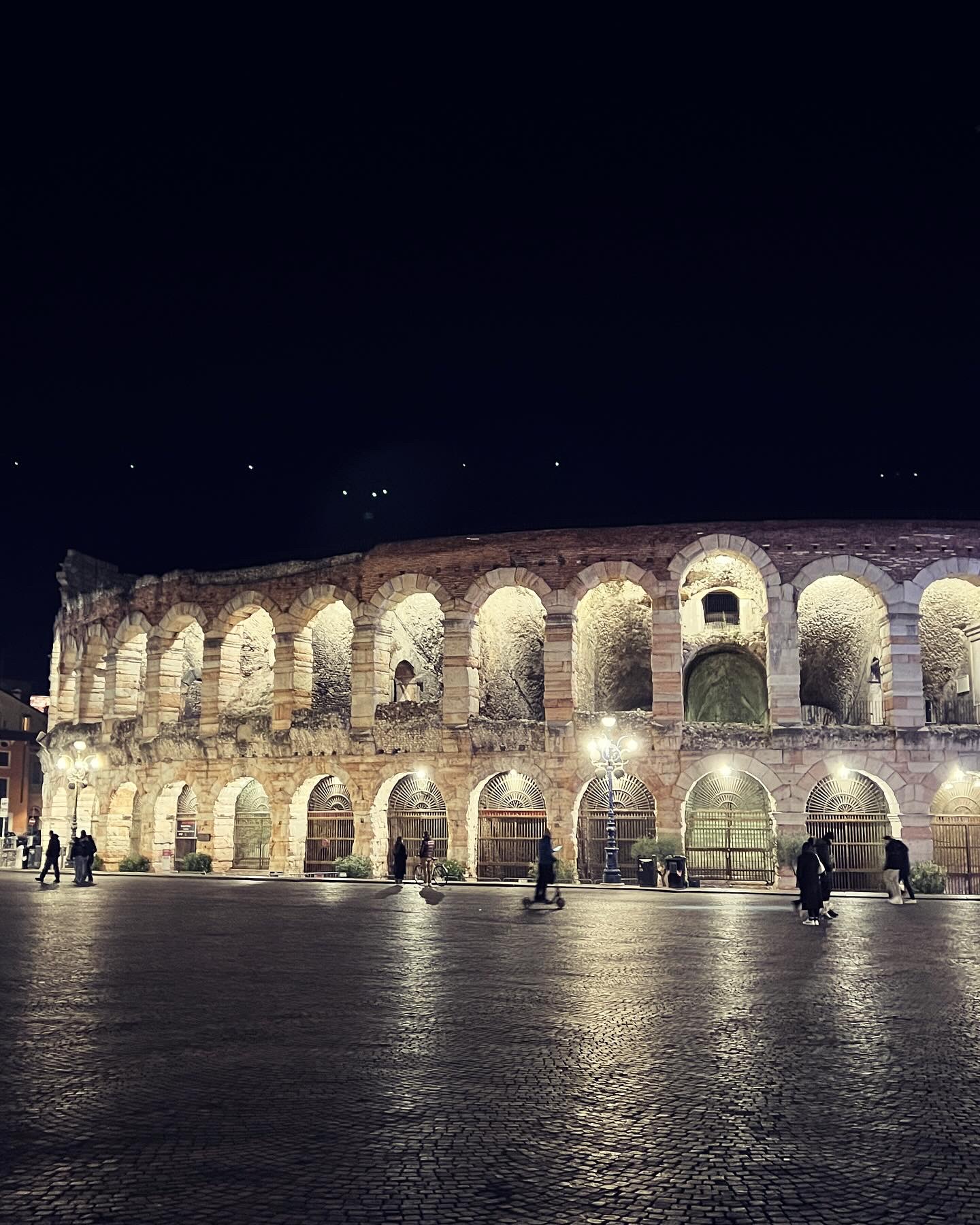
So, not quite 24 hours in Verona, but enough to whet our appetites again, and look forward to spring and hopefully the planning of a slightly longer trip. And maybe find that restaurant by the River Adige, that I can’t remember the name of, but do remember the delicious meal.
All photos of Hotel Verona – www.hotelverona.it
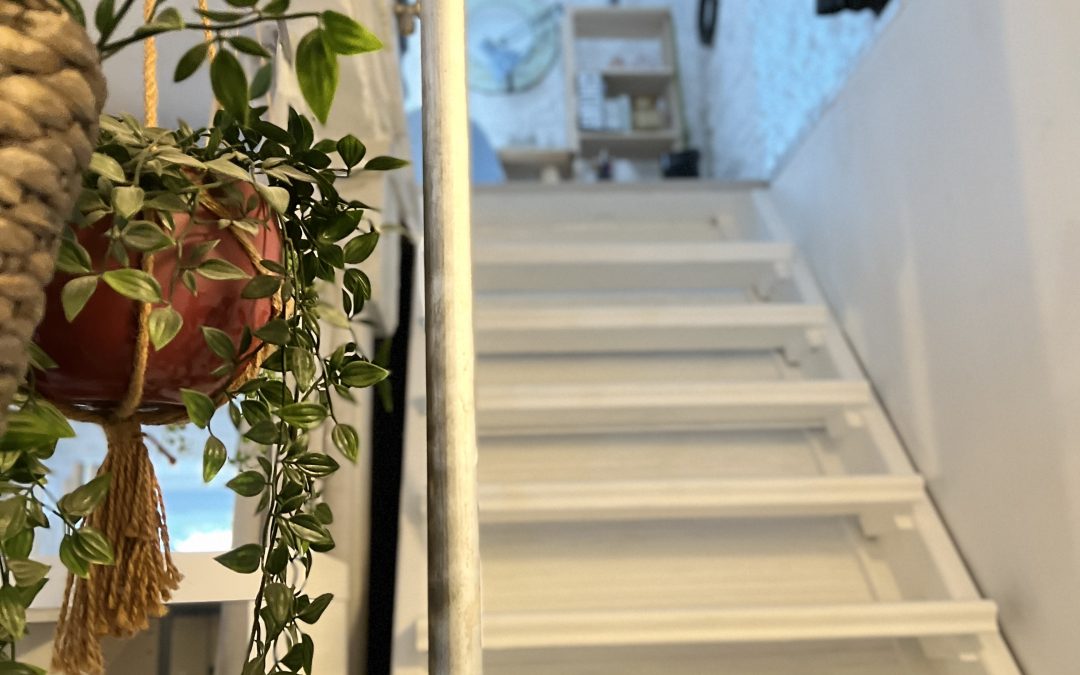
by Helen | Dec 20, 2023 | Renovation
It’s been a while since I first posted about the stairs which lead down from our living room, into what we now call The Snug. I’m glad to say that the very dangerous wooden stairs which we inherited have now been completely renovated and made a lot safer in the process. When we moved into our stone house, this what the stairs were like…
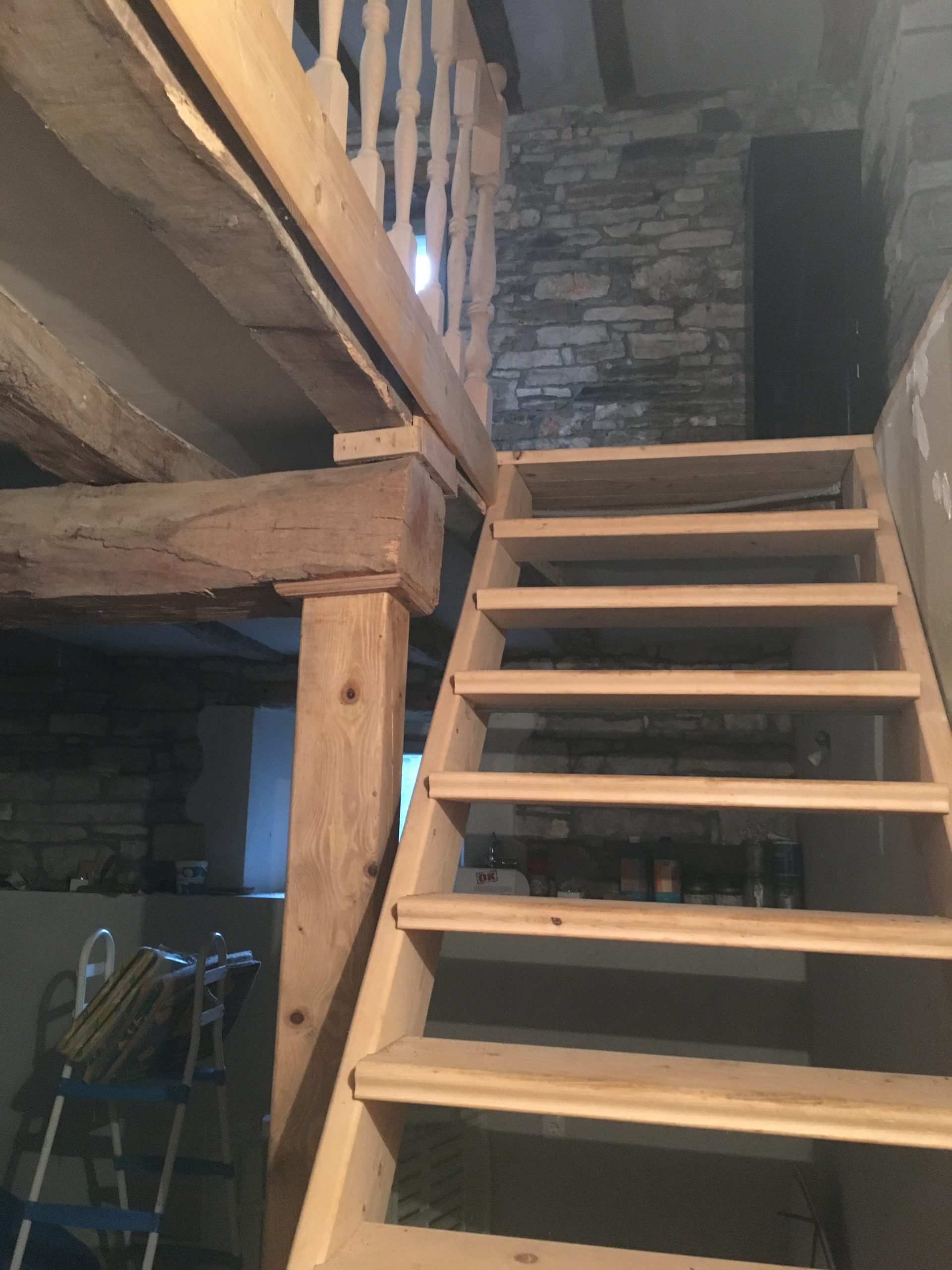
With no back on the flight of stairs, they just felt very precarious, especially as the treads were quite shallow in depth, because of the way they had been fitted. The pine wood was also not what we wanted in terms of a finish. As I explained in my original post, we did investigate replacing the stairs – we even had an (eye-watering) quote for concrete stairs – but with so many other renovation jobs taking priority, to make the house habitable, we were really only left with one option. To try and make the best of what we had, and maybe one day in the future, look into replacing the stairs.
so, what did we do?
The first thing was to attach a solid wooden panel to the back of the structure, so that it no longer looked quite as flimsy and dangerous. The treads were then taken out and refitted, but further forward so that anyone on the stairs had much more space for their feet. Always a handy thing, we think! The treads were then screwed back in, and the joins filled with caulk, so that they had a much more finished appearance, and all painted white. Because we couldn’t alter the angle of the staircase, we decided that grab rails should be fitted for additional safety. These were a bit tricky, because we couldn’t install a handrail following the angle of the stairs as there was nothing to attach it to – and whilst we could have done it on the opposite wall, it would still have left us with an open space down the side of the stairs. Easy to topple over after a glass of wine, so we had to really scratch our heads to come up with a safe solution. And, here’s how we solved the dilemma…
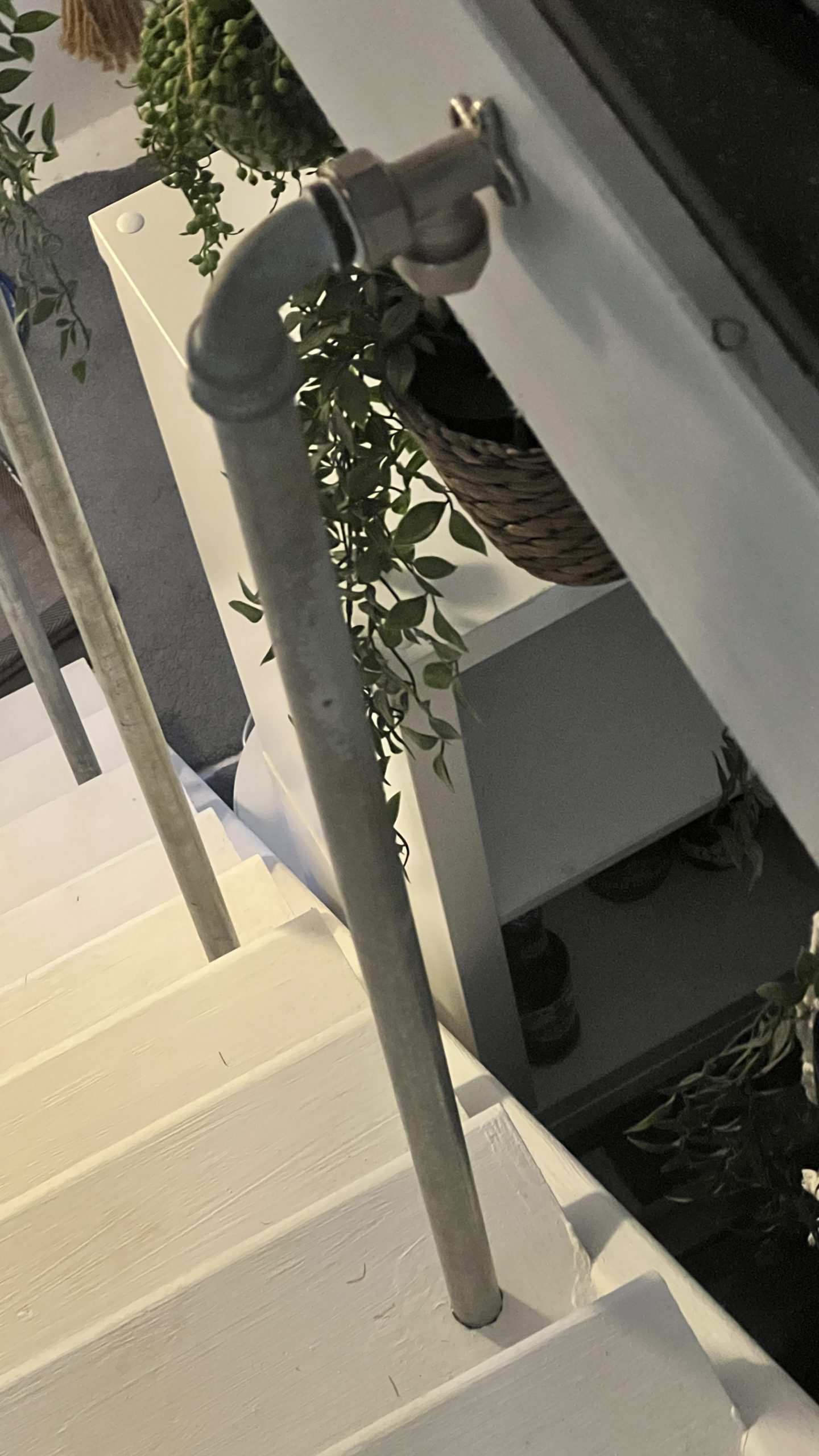
We had galvanised iron plumbing pipes cut to the correct sizes, and attached three, drilling the bottoms into the treads. We couldn’t attach them at the top easily, as there was nothing directly above, to fix them to, so we had to also puzzle this one out. And once we’d worked it out, the solution was obvious – angled pipe connectors, which could be attached the wooden board above. Once all secure, these pipes not only looked good – we do love a bit of industrial design – but provided the safety aspect we needed for the stairs.
Because everything has now been painted white, the whole access into The Snug feels much more spacious. The stairs and the room are bright and light and now seem to connect seamlessly with the floor above, so no longer a dark dumping ground. The room is now used fully, both as a home office and an additional living room, with the added bonus of sectioned off utility area under the stairs, now housing shelving, a condenser dyer, a chest freezer and all of those practical things – ironing boards, hoovers etc – which take up a lot of space. A new room, and one we do love spending time in.
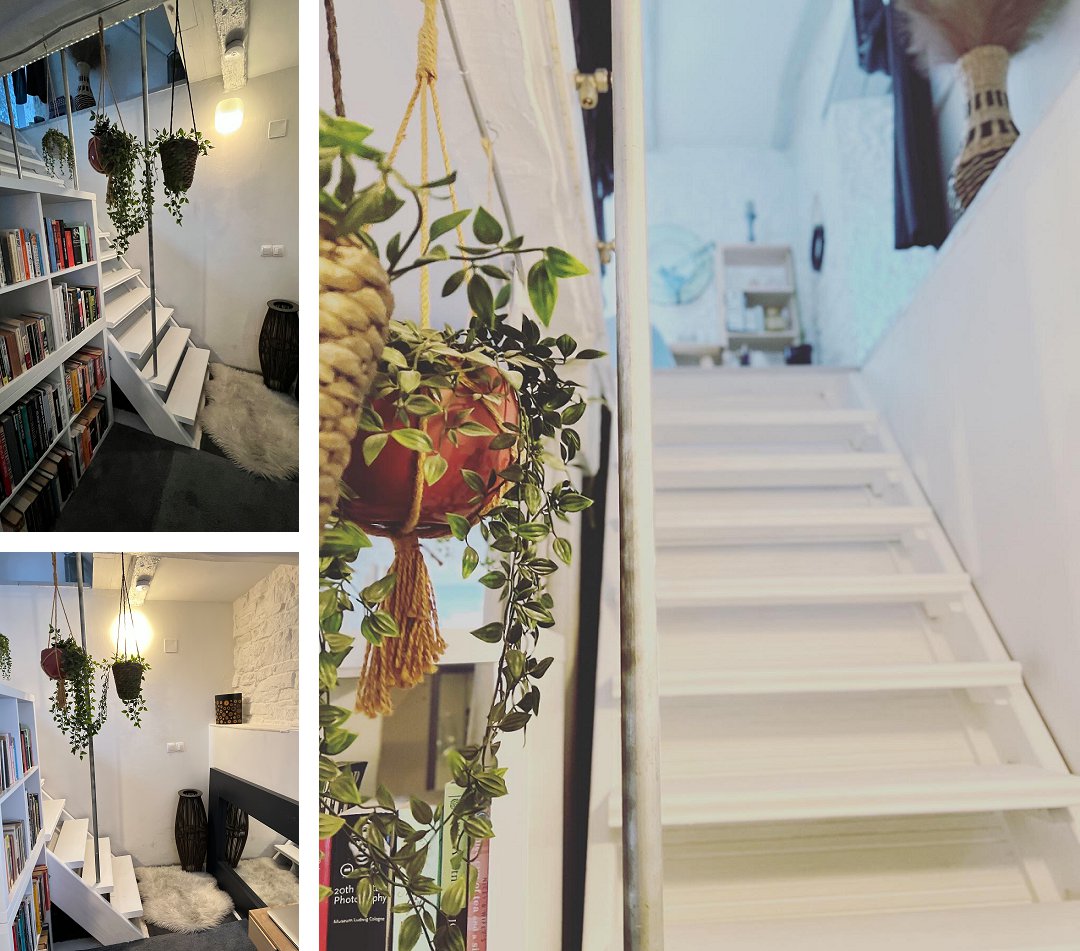
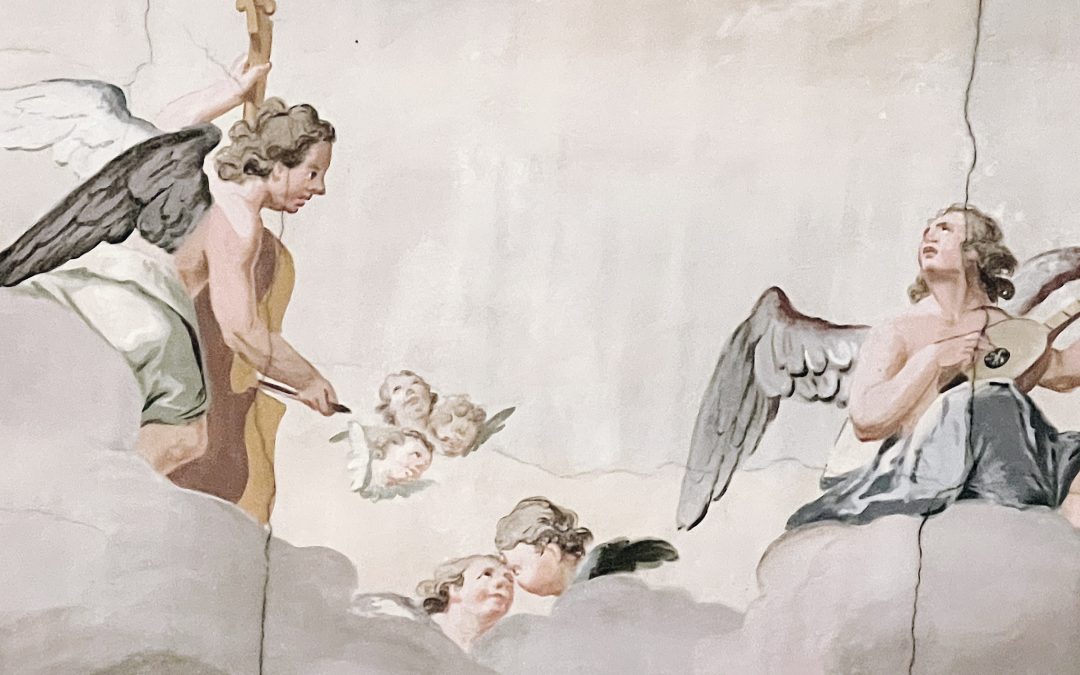
by Helen | Dec 19, 2023 | Travel
Until very recently, we hadn’t actually realised that our closest beach/seaside town, was actually in Slovenia, not Istria. Not by many kilometres, but enough to be our closest. In just over half an hour, we can be in beautiful Portorož, on the Slovenian Riviera, the 47km slice of coast, in this otherwise landlocked country. However, as gorgeous as this town is, we think we actually Piran, a little further on, towards the main coastal town of Koper and onwards to Trieste, is perhaps even more pretty.
From 1283 to 1797, Piran was part of the Republic Venice, and today, Venetian influences are everywhere. Until the mid 20th century, Italian was the official language and the architecture and food have strong Italian influences. Even though now in another country, the city of Trieste is only a short drive away, and Venice can be accessed in a couple of hours. After 1797, Piran was ruled back and forth, by Austria, France and Italy, until 1954 when it became part of Yugoslavia. In 1991, it became part of the new country of Slovenia. However, it is a town which feels very much Italian. The architecture is reminiscent of Venice, the pastel colours of the buildings like one of the Cinque Terre towns.
What makes it a bit more special, is the fact that it’s almost car free. Only residents can drive into the town, through controlled barriers. Outside these barriers, is a huge underground car park, where visitors park up and either walk the 1km into the town, along the sea front, or hop on one of the free shuttle buses, which run every 15 minutes or so. The shuttle bus drops you off right on the edge of Tartini Square, the main square, named after the violinist Guiseppe Tartini, who was born and lived here. Three sides of the square are surrounded by elegant, colourful buildings – very Italianate – whilst the fourth side opens onto the pretty harbour. The bell tower of the Church of St George, stands above the square, and is a great example of the Venetian influence – it is a smaller scale version of the Campanile in St Mark’s Square in Venice.
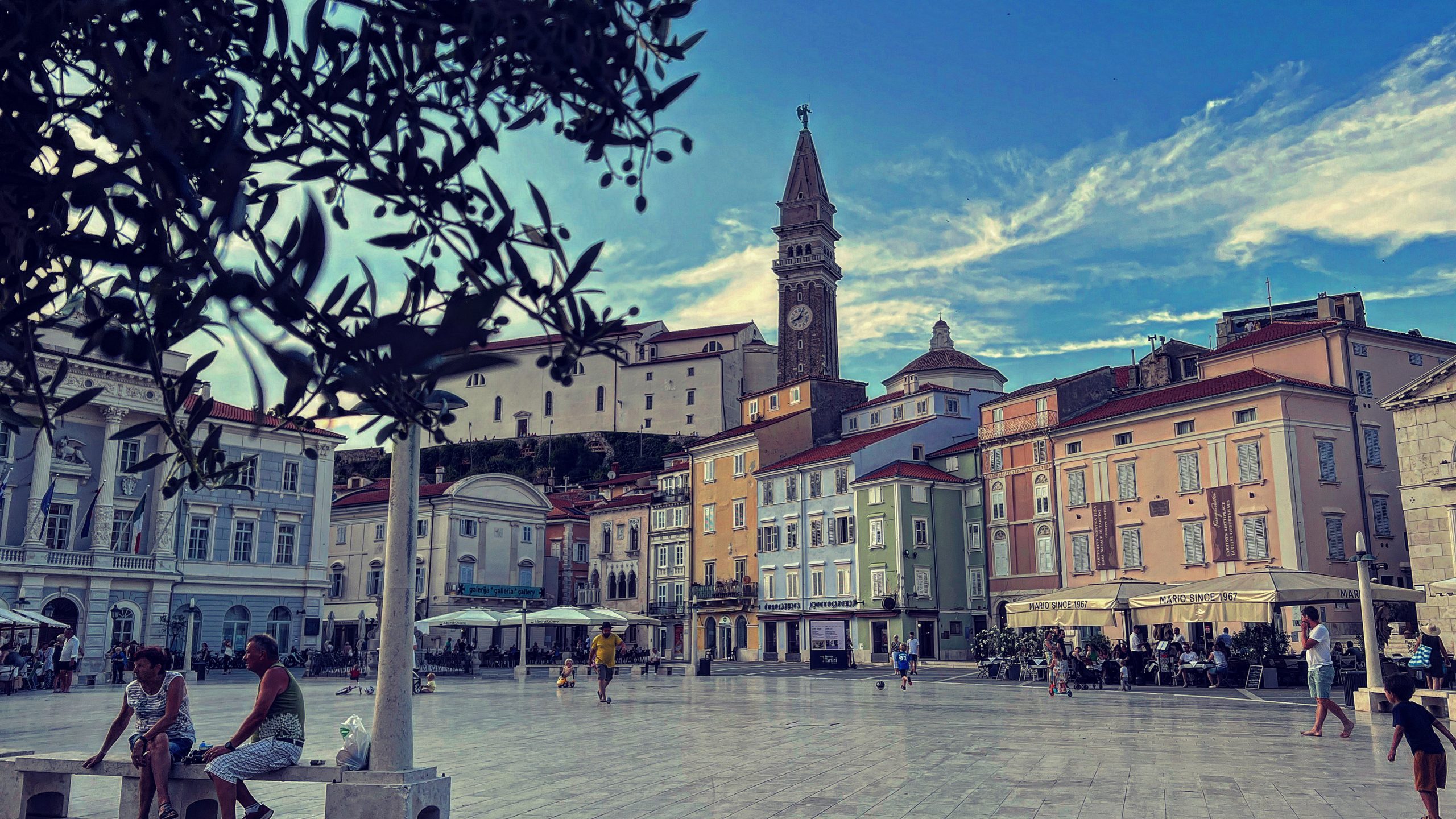
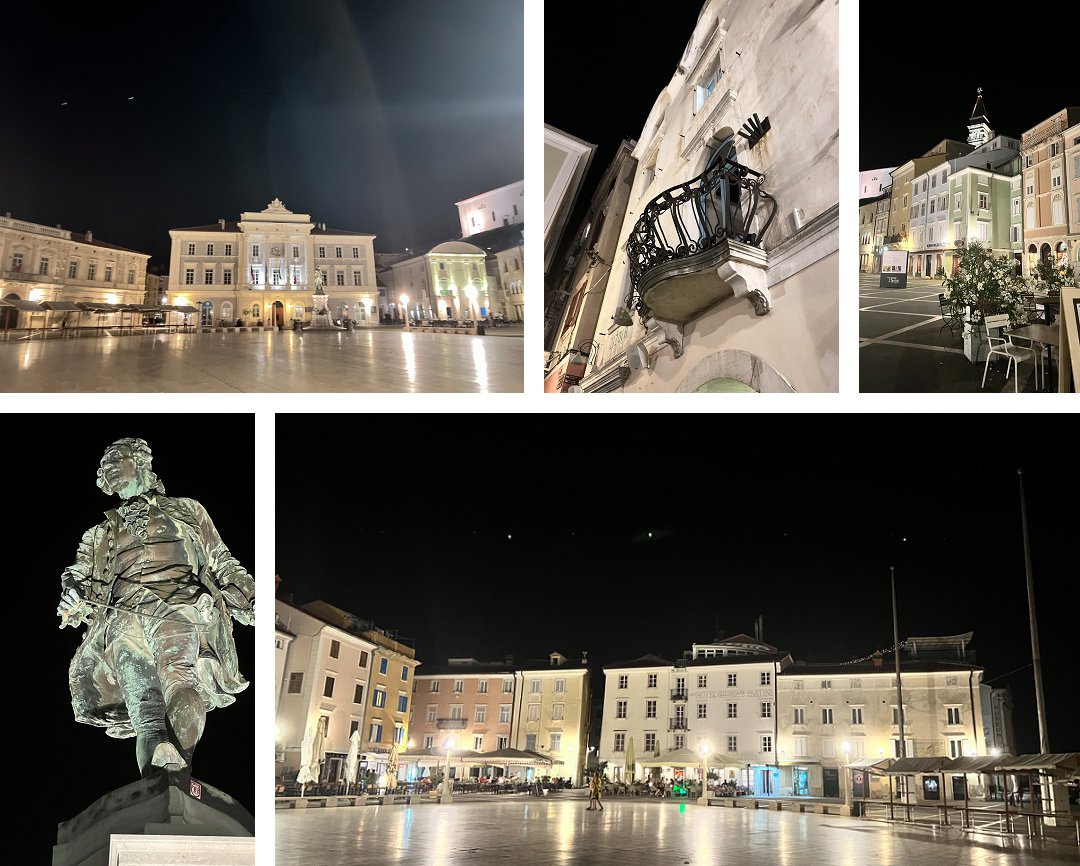
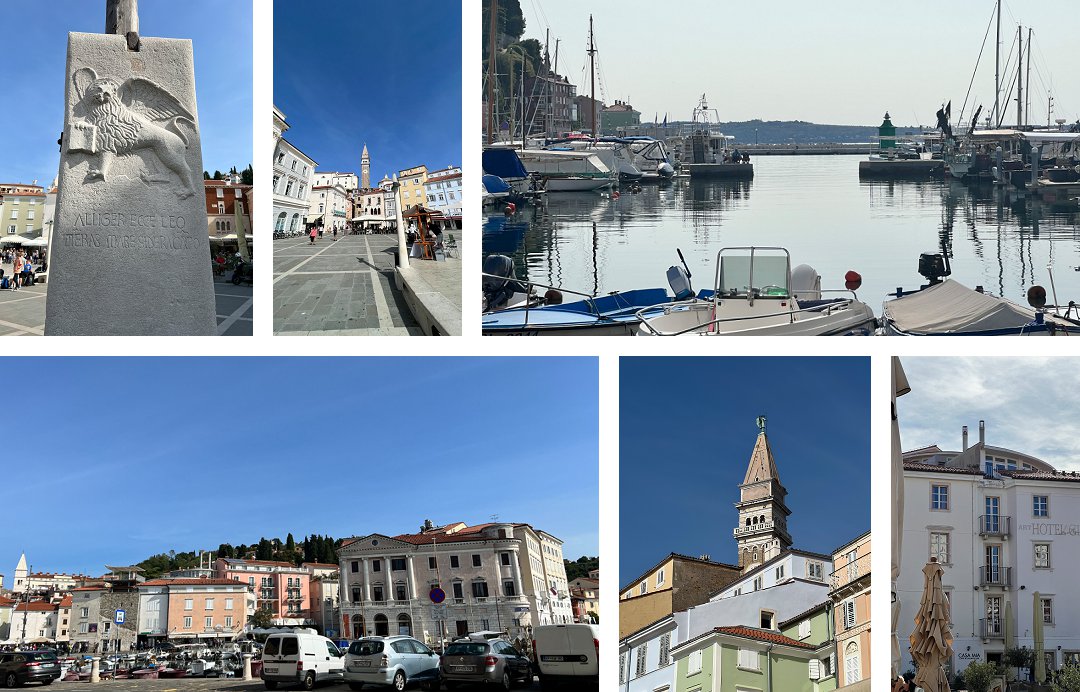
The old town leads directly off the square, via a series of cobbled alleyways, all taking you up to the top of the hill and the town walls, where the vantage point is amazing. From the walls (and the top of the campanile) you can see the whole of Piran below you, and the views across to Istria and Italy. The old town itself, is as pretty as picture. Higgeldy-piggeldy houses, of various heights and sizes, all painted different pastel colours usually with lowers tumbling down out of window boxes. Little independent shops and holiday lets and the odd boutique hotel, mingle with the houses.
Piran, I don’t think, ever gets very, very crowded, but if you did want to escape Tartini Square or the harbour, where the restaurants and bars are located, I’d really suggest the walk up into the old town and take in the cloisters of St Francis Monastery, considered by many to be the most beautiful in Slovenia. This is such a peaceful, serene place, and if you are lucky, you may even get the place to yourself, like we did. And, you’ll get the opportunity to sit on an amazing chair, carved out of the trunk of a 500 year old olive tree, just as our friend did. Do go into the church as well, and look up…
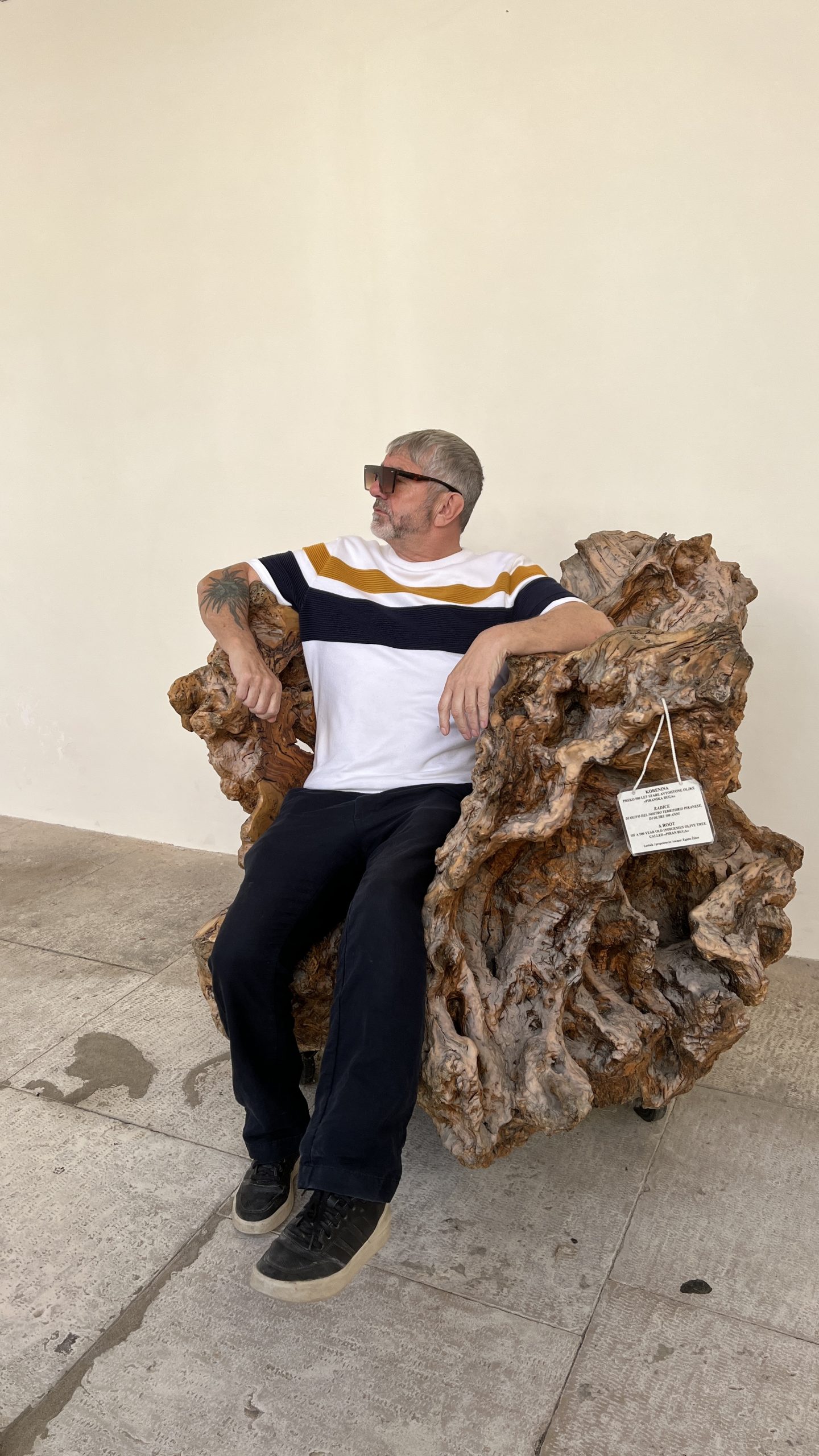
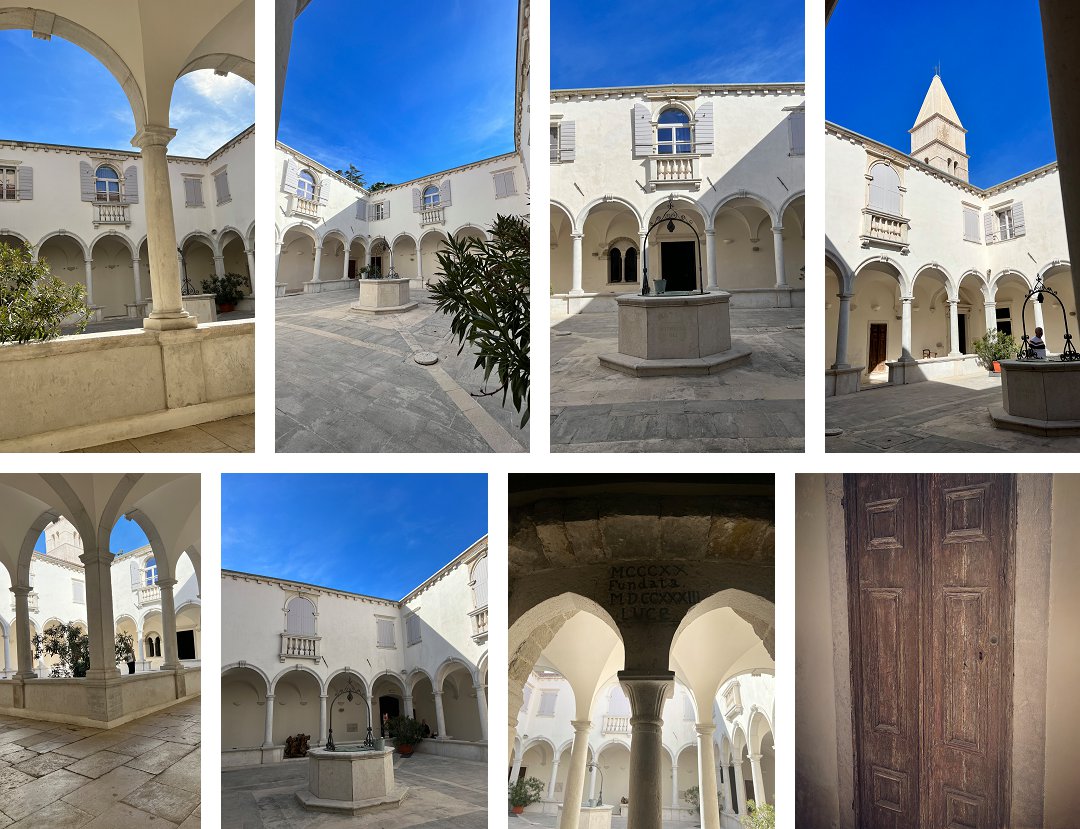
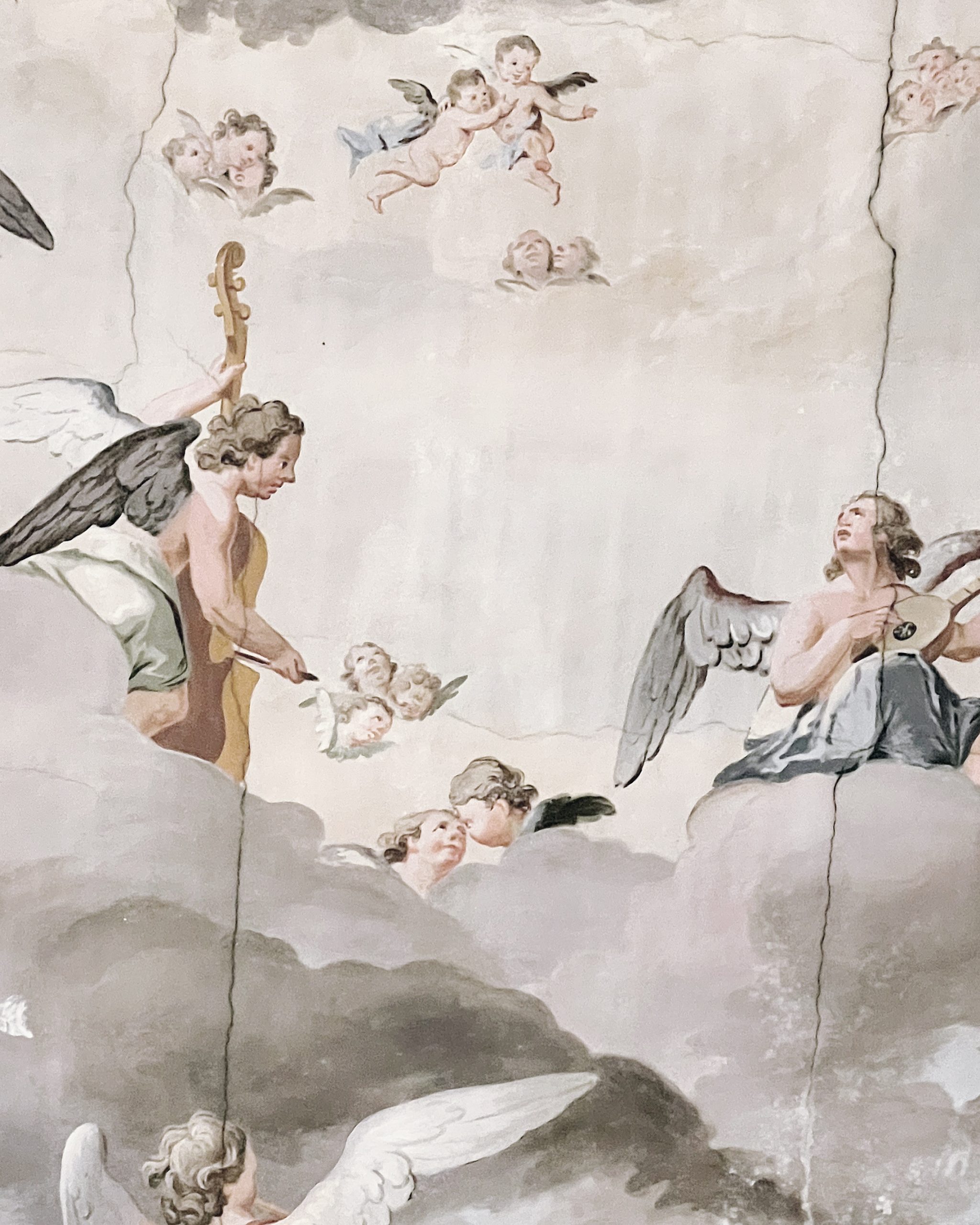
The harbour is small, and very pretty, as is the coastal path. There are lots of restaurants here, most specialising, obviously in fish. It’s safe to say we’ve not had a disappointing meal here, as like Italians, the restauranteurs of this town, know how to do food well.
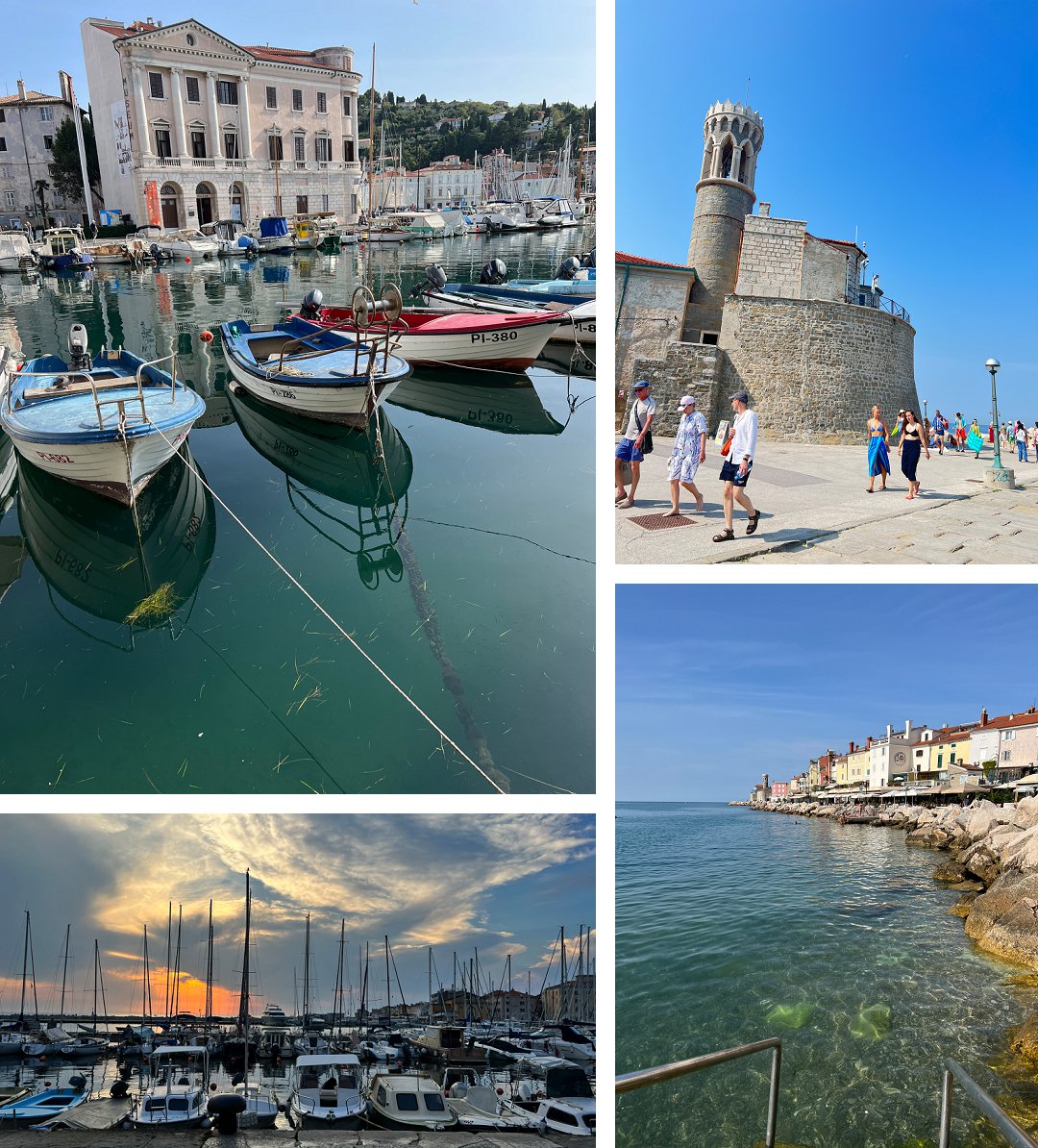
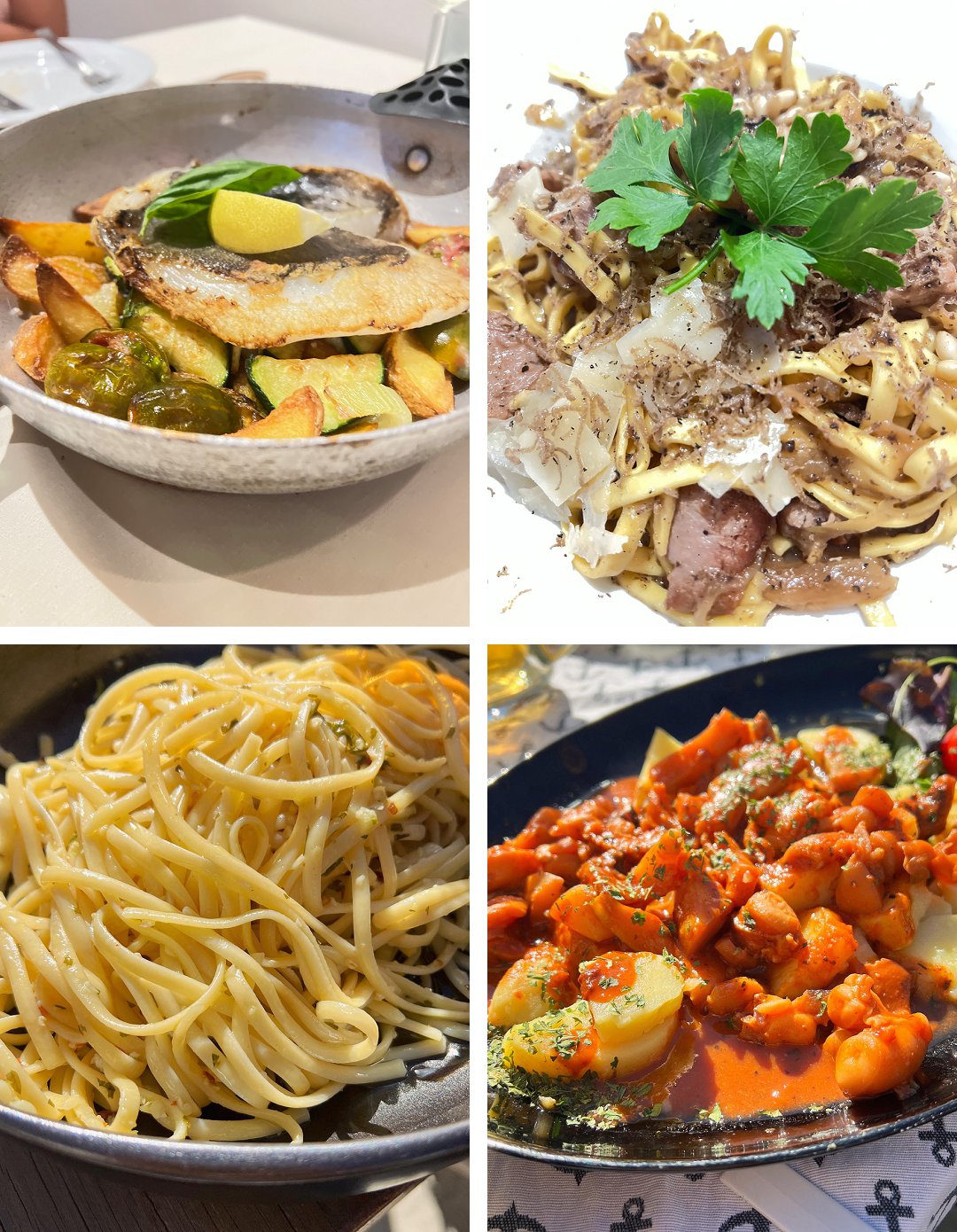
We are extremely lucky that we now live so close to beautiful places like Piran, and its neighbours of Portoroz and Izola, and can just drive across the border for an afternoon out or an evening away. Now that Croatia has joined The Schengen Zone, it has made travel across the border so much easier, and that means we can really explore our new(ish) locality. It’s a real privilege to live somewhere so stunning.



















































































